Allison Collection Photos
September, 1942
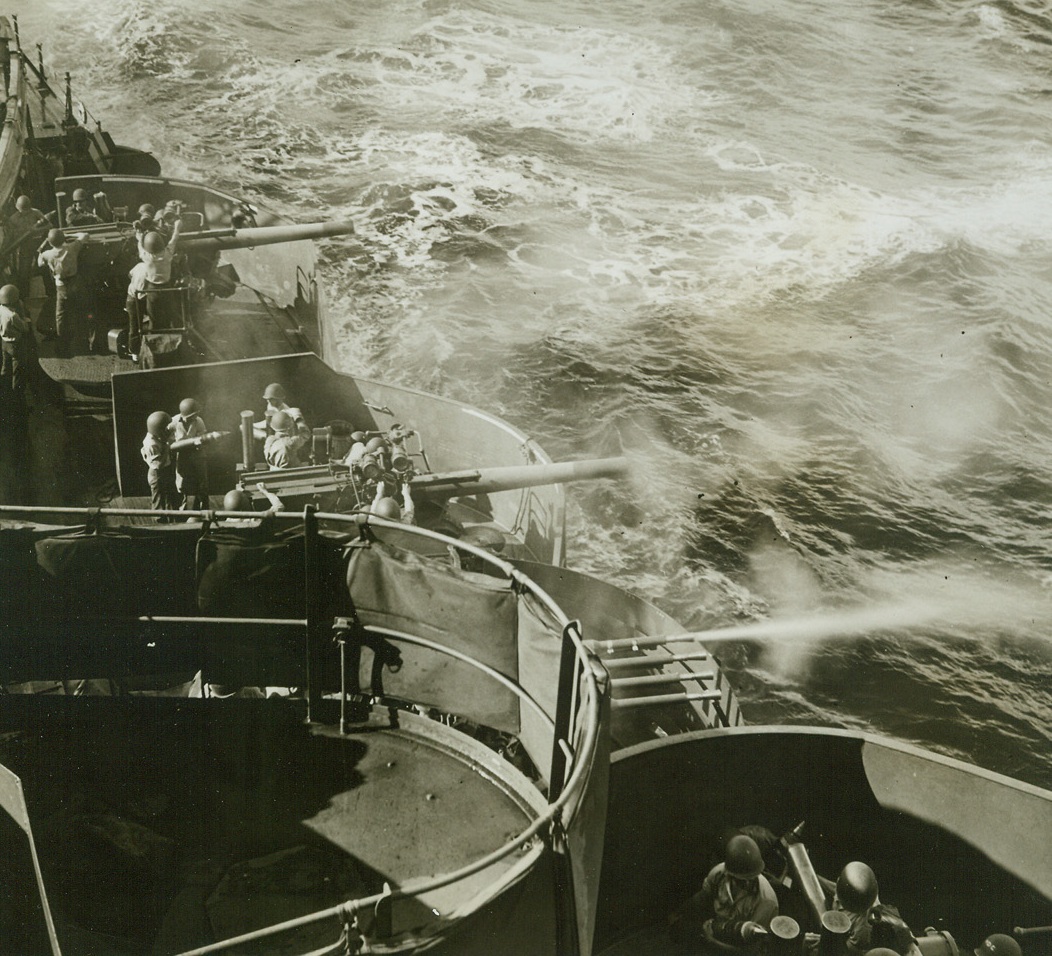
WHERE A PERFECT MARK IS “ZERO”, 9/25/1942. Big little anti-aircraft guns of a unit of the U.S. Pacific Fleet engaged as part of a task force somewhere in the Pacific fill the air with “flak” during anti-aircraft practice at sea. The larger AA’s in action here are five-inchers.Credit: ACME.;
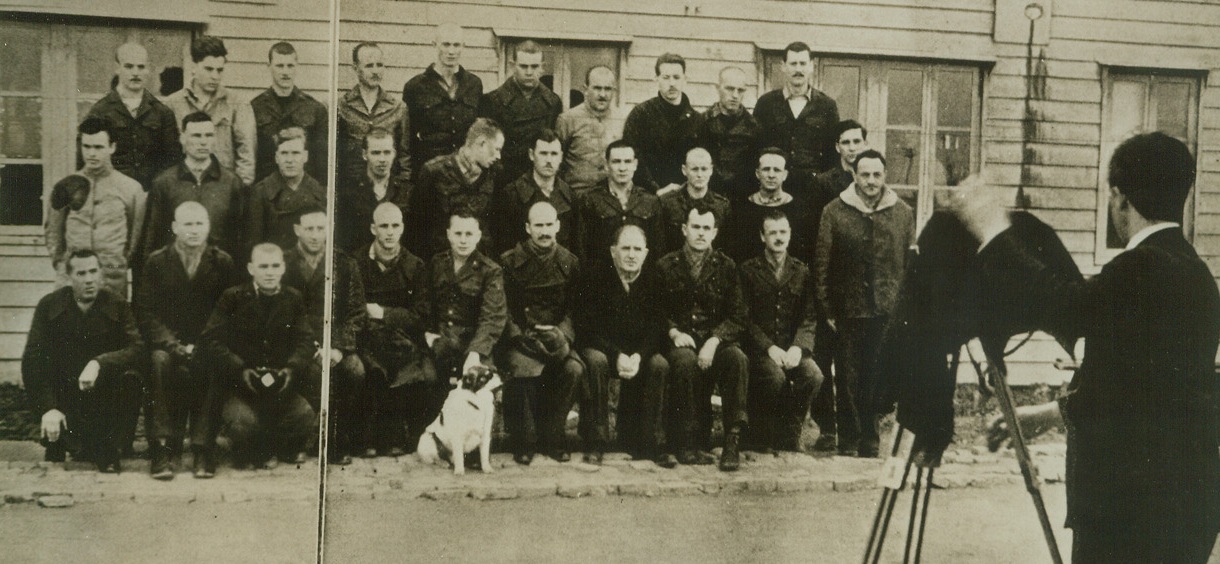
JAP PROUDLY PHOTOGRAPH THEIR WAR PRISONERS, 9/11/1942. SHANGHAI—In a caption accompanying this photograph in “Freedom,” Japanese propaganda magazine published in Shanghai, this scene is described as U.S. and British was prisoners being photographed by a professional Jap cameraman in Shanghai concentration camp. Purpose of the picture, like all those published in the magazine, is to show that the Japs don’t mistreat their prisoners. “The camp mascot was not forgotten,” the caption points out—no doubt one of those warm, human touches for which the perpetrators of Pearl Harbor are famous. Credit: ACME.;
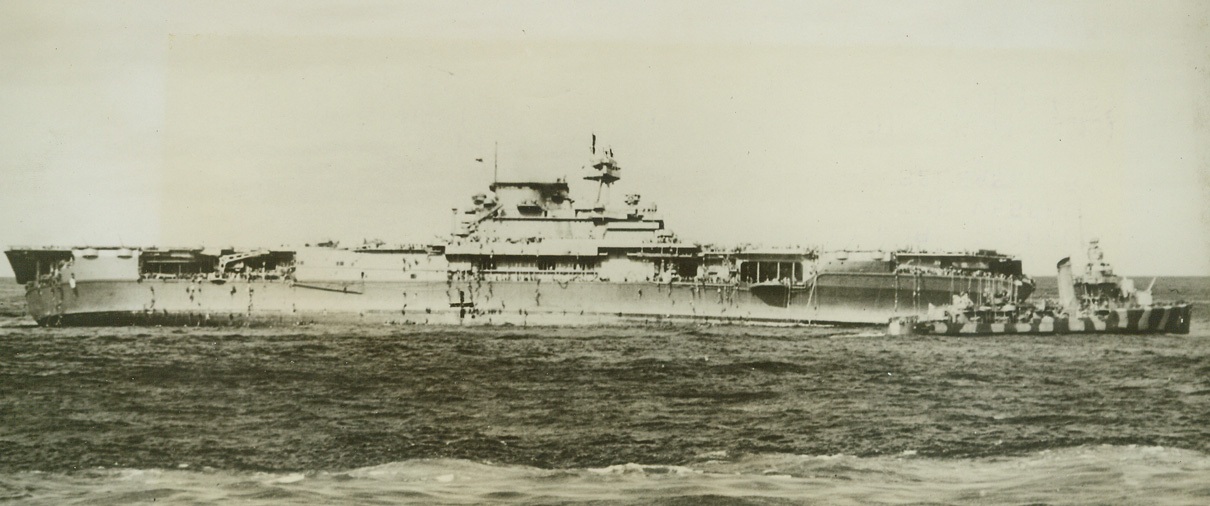
ABANDON SHIP!, 9/16/1942. WASHINGTON, D.C.—Crewmen slide down ropes over the side of the aircraft carrier U.S.S. Yorktown to swim to the escort vessels that stood by to rescue the men, after the order to abandon ship had been given. Few of the 2,072 officers and men the ship had as a normal complement were lost during the abandonment. After undergoing punishing bomb and torpedo hits on June 4th, the ship was still afloat and it was thought that it might be salvaged, but two more torpedoed from a Jap sub finally finished off the vessel on June 7th. Photos and story were released by the Navy, Sept. 16th. Credit: OFFICIAL U.S. NAVY PHOTO FROM ACME.;

SINKING OF THE YORKTOWN, 9/16/1942. WASHINGTON, D.C.—Escort ships circle the helpless U.S.S. Yorktown, shortly before it sank to the bottom of the Pacific, June 7th, after its work was done in turning back the Japanese invasion fleet from Midway Island. The gallant aircraft carrier, which caused the destruction of at least a dozen Jap ships, was lost—but it was lost during the greatest American Naval victory of the war. Credit: OFFICIAL U.S. NAVY PHOTO FROM ACME.;
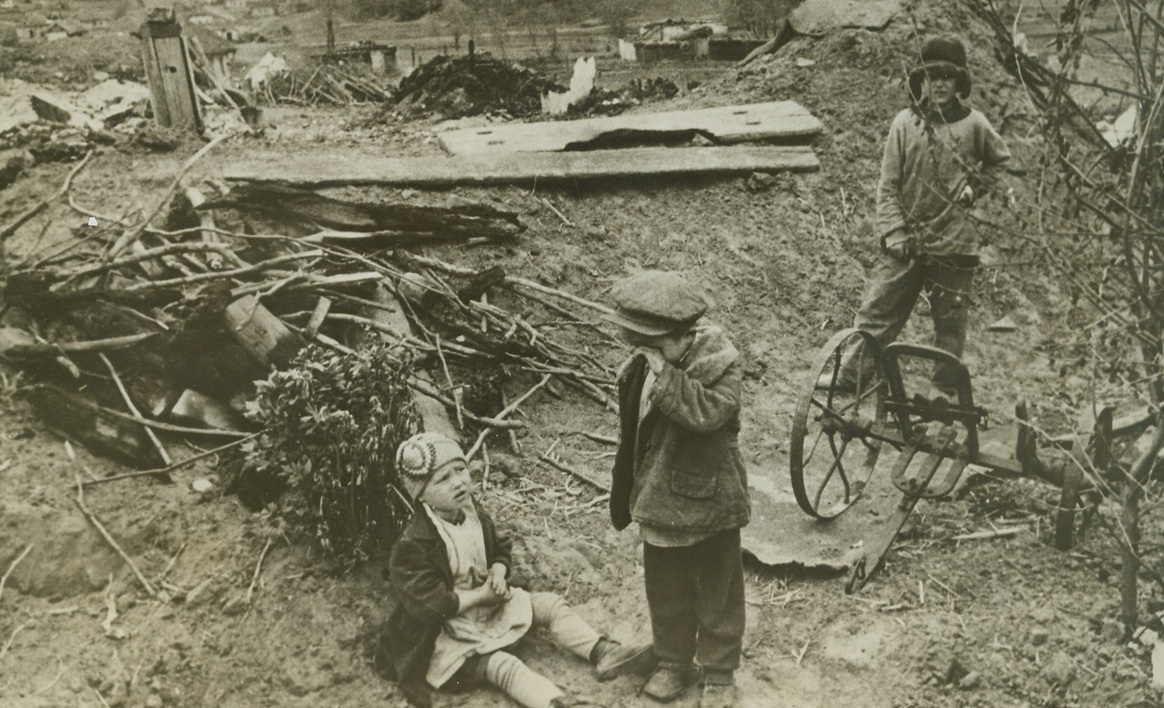
Orphans of War, 9/29/1942. GERMAN-SOVIET FRONT—These youngsters were left motherless, fatherless and homeless when the Germans demolished their home and carried off their parents in their mechanized rush through a region somewhere in the southern part of the Soviet-German border. Passed by Soviet censor. Credit: ACME;
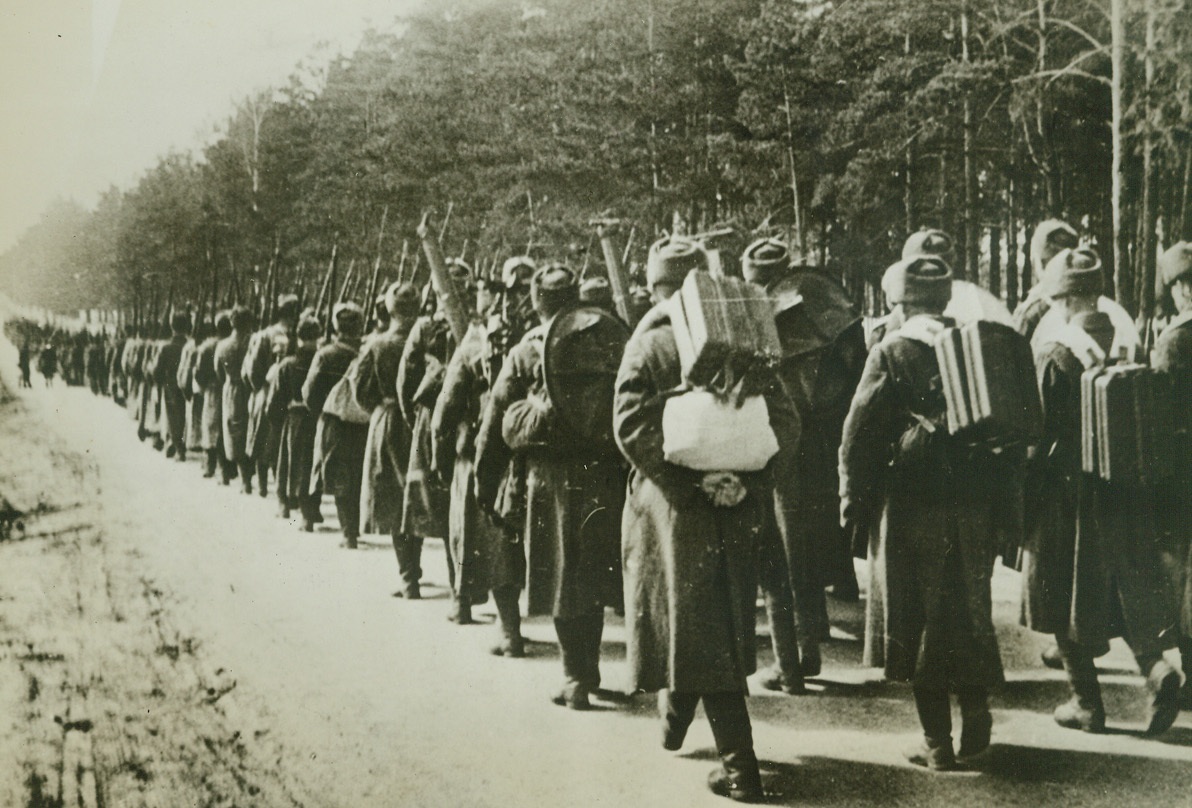
A Key Factor on the Russo-German Front: Reserves, 9/20/1942. RUSSIA—On the extent of Soviet reserves depends the fate of Stalingrad and the shape of things to come all along the German-Soviet front. Military experts have pointed out that the object of the Russians may be to make German losses at Stalingrad as heavy as possible while holding out strong forces of reserves for a grand counter-offensive. Here a seemingly endless line of Red Army reservists move up to “a forward area” somewhere on the battle front. Passed by Soviet censor.Credit: ACME;
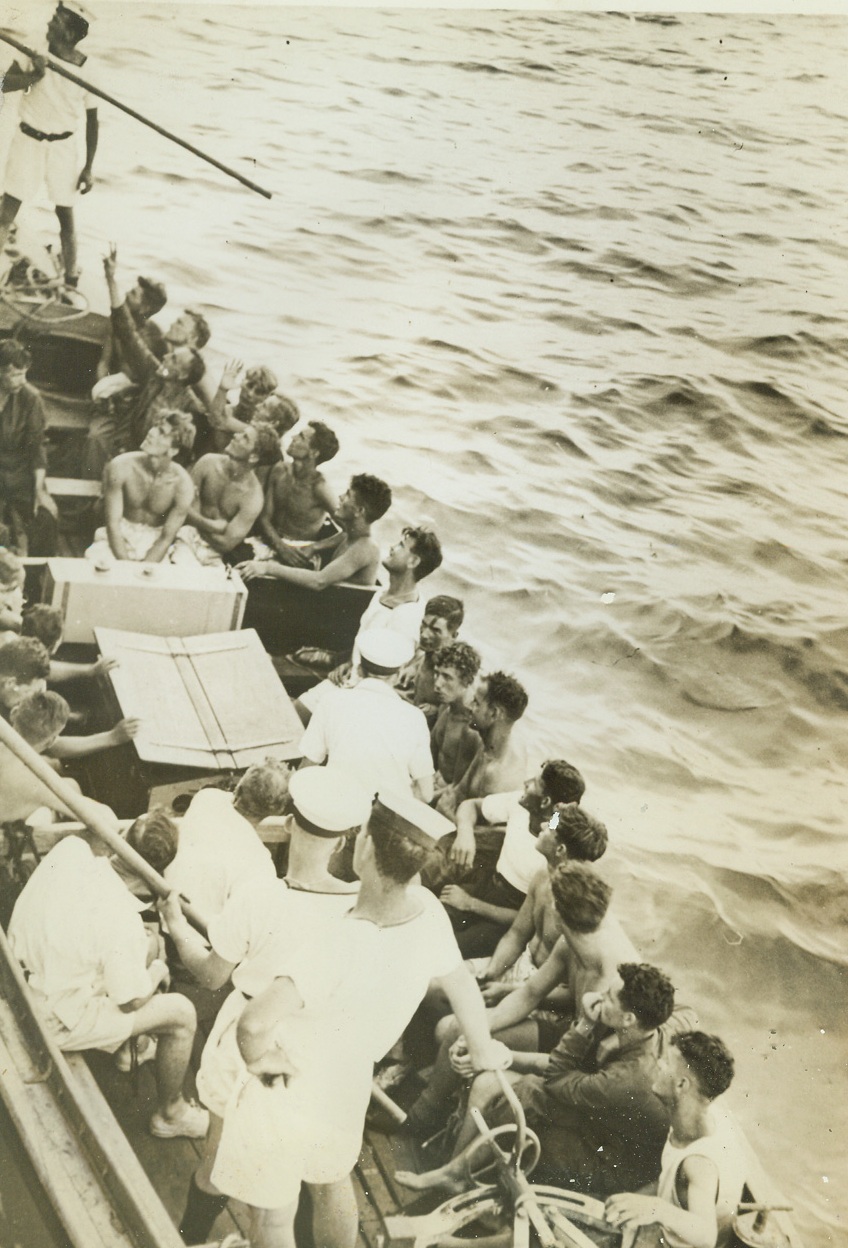
Rescue of Survivors from H.M.S. Dorsetshire”, 9/8/1942. Indian Ocean – As if they were going along “just for the ride”, these courageous survivors of H.M.S. Dorsetshire sit quietly in a lifeboat while crew members make fast to the side of a British Destroyer which hurried to the scene of action. With another British cruiser, H.M.S. Dorsetshire was sunk during action in the Indian Ocean, but hundreds of the British tars were saved by prompt action on the part of rescuers. Credit line (ACME);
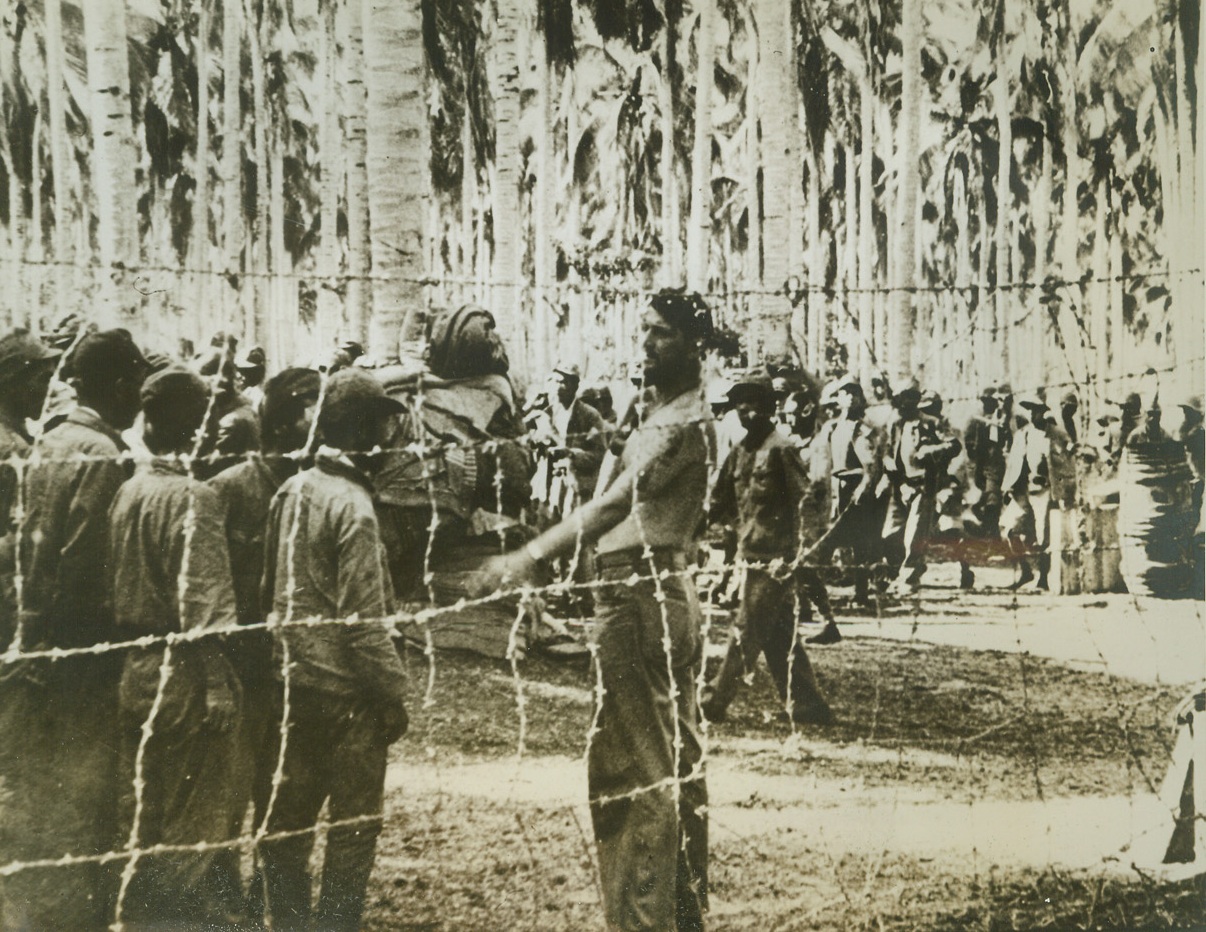
Captured “Nip” Workmen, 9/22/1942. Guadalcanal, Solomon Islands – This band of Japanese workmen, penned in behind barbed wire, was captured by U.S. Marines during the recent heavy fighting on Guadalcanal Island. The “Nips” had been brought from Japan to construct bases on the island. Credit line (ACME);
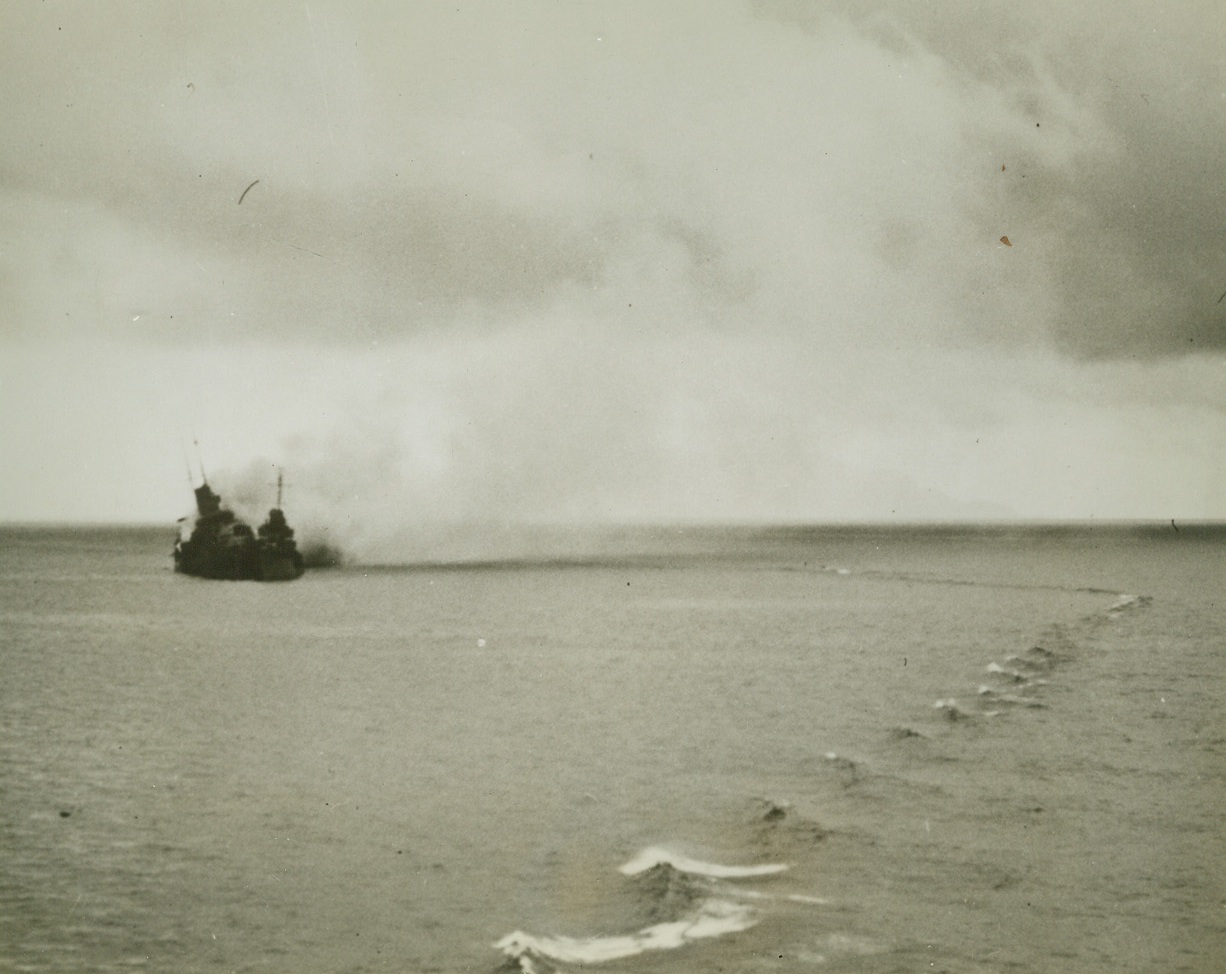
Japs Hitting At U.S. Transport, 9/25/1942. Skimming through anti-aircraft fire, four Jap bombers come in low at Guadalcanal, Solomon islands, to attack U.S. transports (extreme left). Black bursts are intense anti-aircraft fire. Credit line (ACME);
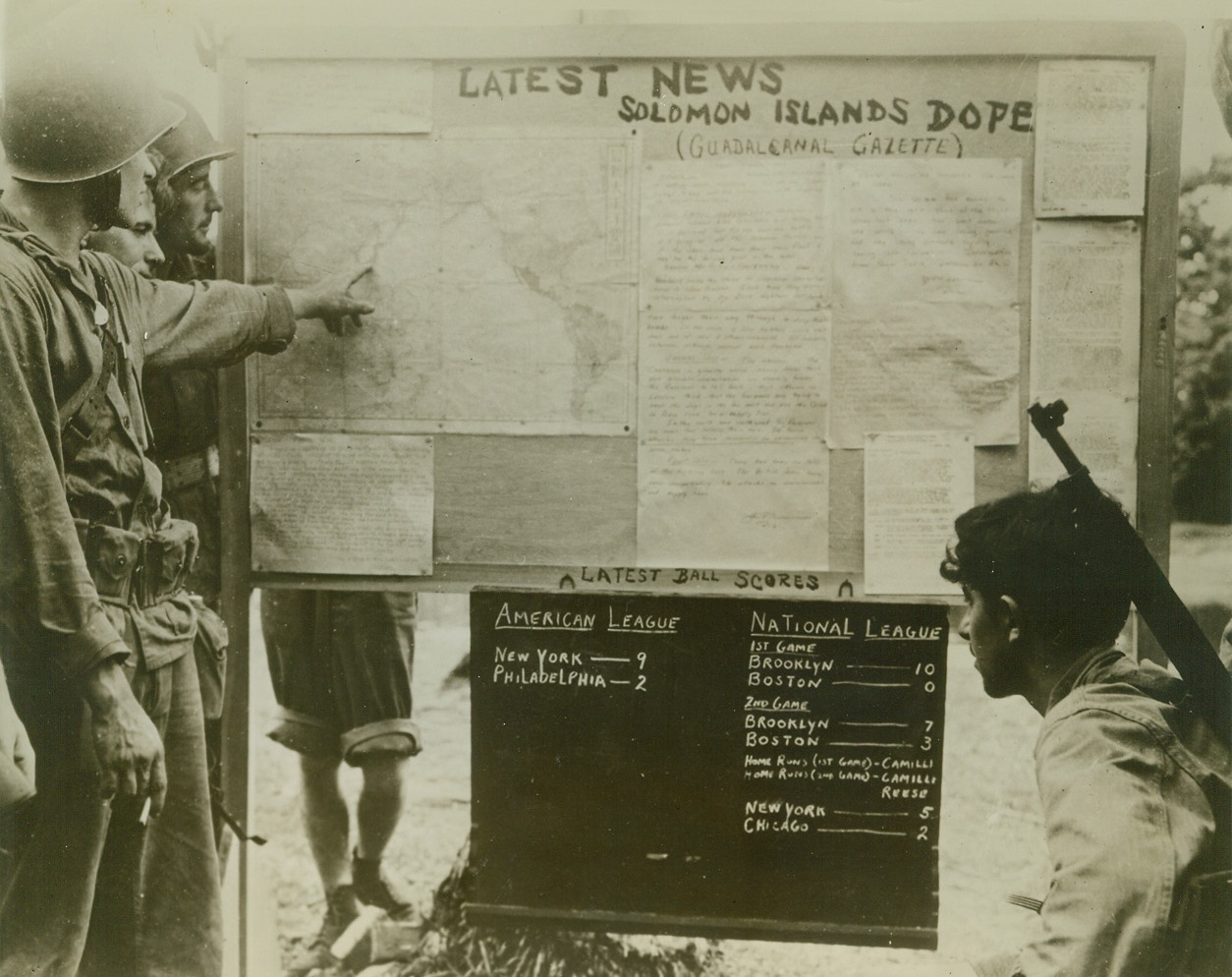
“Wuxtry! Wuxtry! Read All About It”, 9/24/1942. Guadalcanal, Solomon Islands – Marines in Guadalcanal not only make hot news for the rest of the world, but manage to keep up with the news from other parts of the world with the “Guadalcanal Gazette.” Three of the Leathernecks locate their next goal – Tokyo, while another lad, (right), gloats over the twin victory of “Dem Bums” from Brooklyn. Credit line (U.S. Navy photo from ACME);
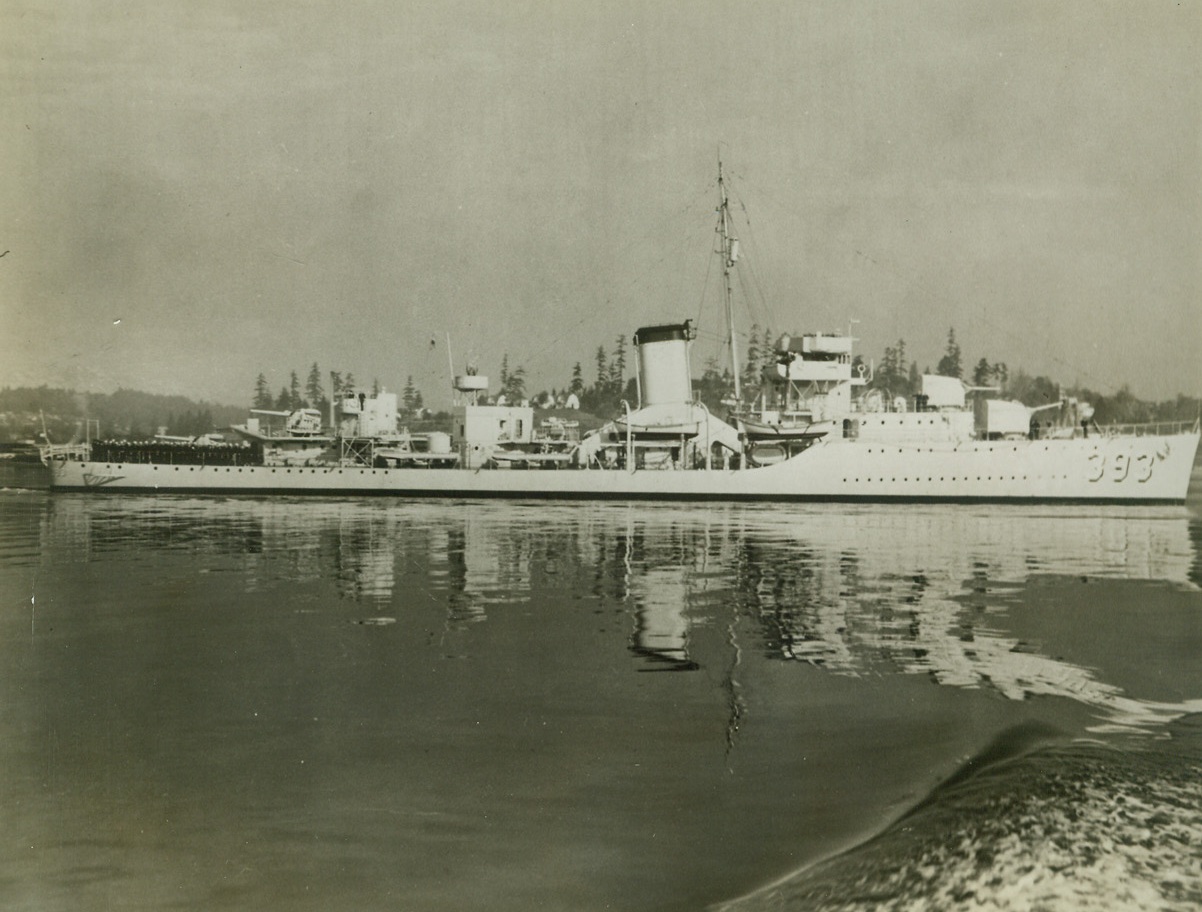
Sunk in Solomons Area, 9/24/1942. Washington – The sinking of the 1,500 ton destroyer Jarvis (above) and the small auxiliary transport Little in the Solomons islands was announced by the Navy. There is an estimated manpower loss of 272. Intensive search by aircraft and ships disclosed no sign of the Jarvis which was on its way to a Southern repair base after being damaged by aircraft off Guadalcanal. Credit line (ACME);
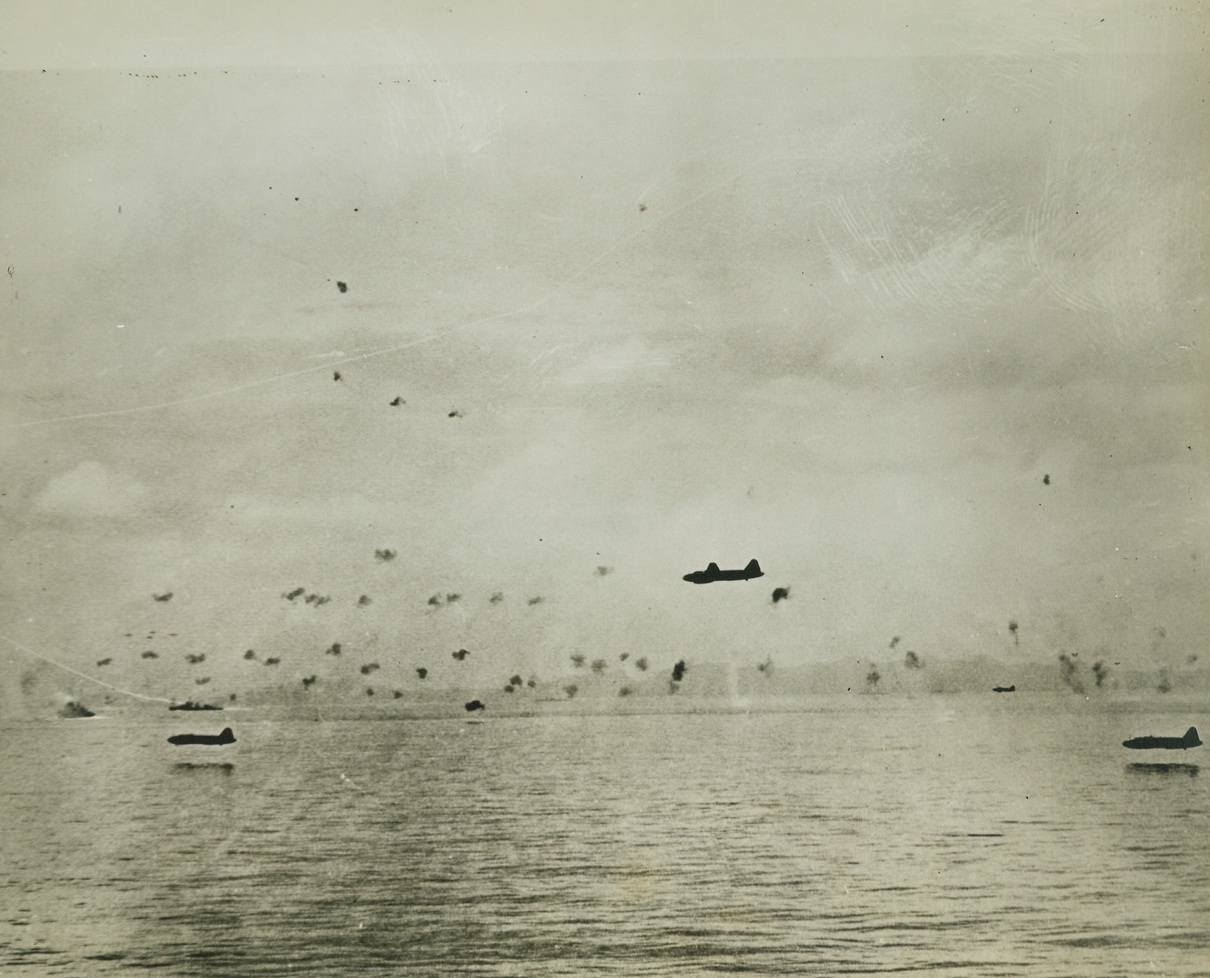
Australian Cruiser Afire in Battle of Solomons, 9/25/1942. Here is the H.M.A.S. Canberra, which participated in the American offensive on the Solomon islands early in August, on fire after being mortally hit. Her loss was previously announced. Pictured with her is an unidentified destroyer. Credit line (ACME);
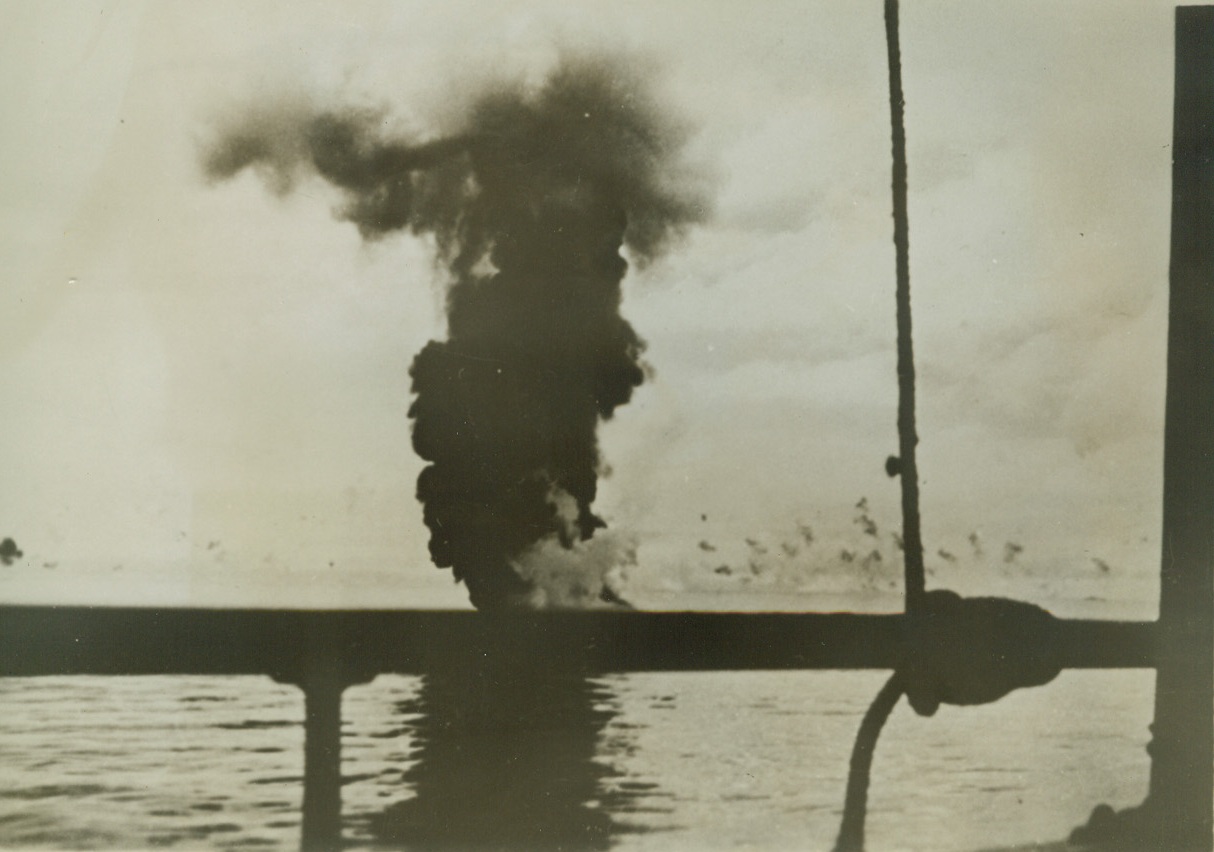
Failure of a Mission, 9/29/1942. Solomon Islands – Here’s a close-up view of an exciting “near miss” during a Jap attack on the U.S. defenders of the Solomons. That cloud of black smoke marks the uncomfortably close demise of a Jap bomber which had attempted to crash into the ship from which the picture was taken. The vessel’s anti-aircraft guns brought it down just short of its goal. Action took place between Guadalcanal and Tulagi. Credit line (ACME);
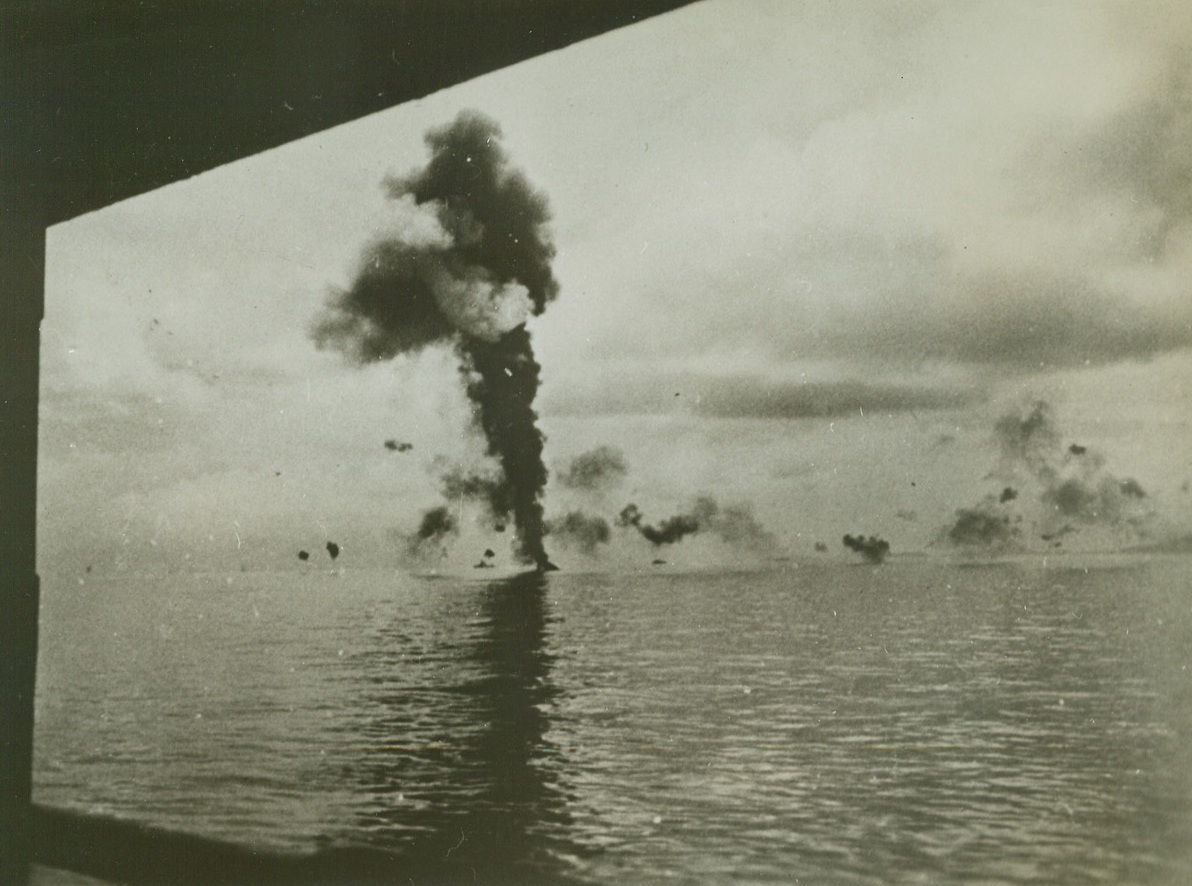
A Jap Bomber Goes Up in Smoke, 9/29/1942. Solomon Islands – A smudge of black smoke staining the sky between Guadalcanal and Tulagi is all that remains of a Jap bomber which attacked the American defenders of the Solomons. In background can be seen smoke from U.S. anti-aircraft bursts. Credit line (ACME);
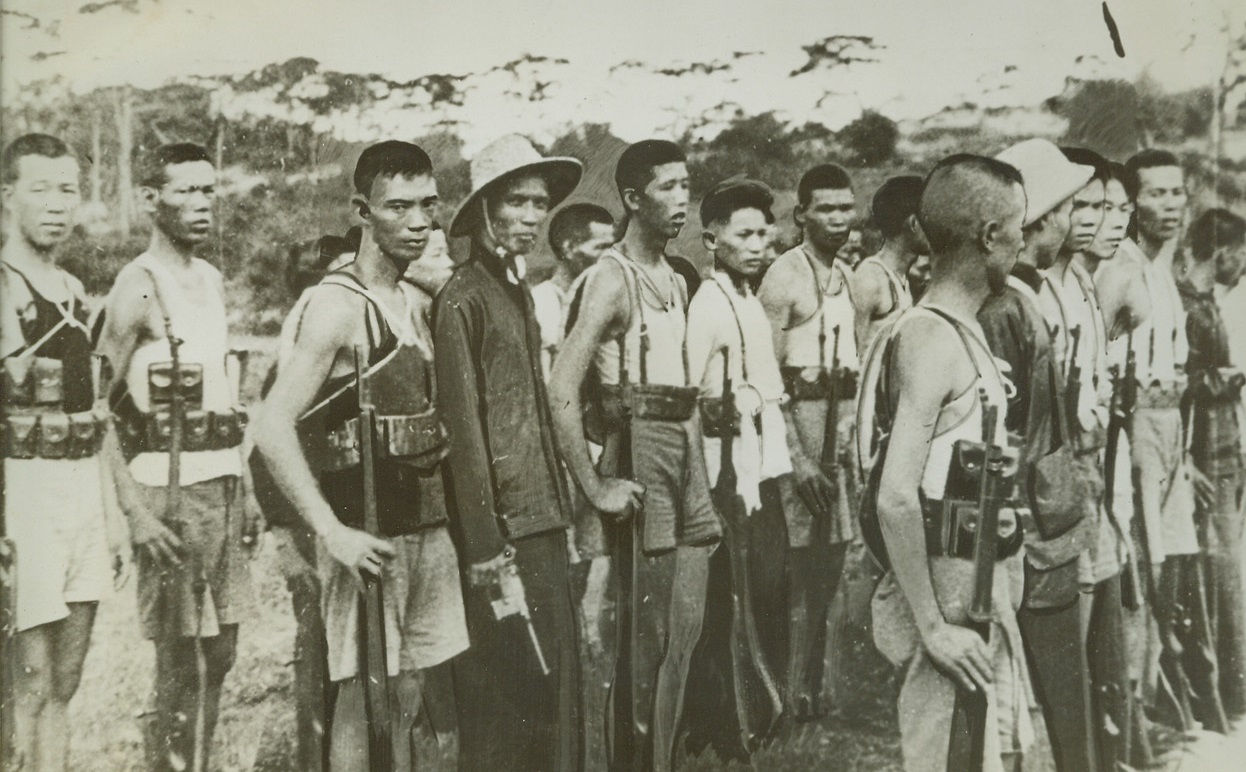
Revenge Detachment, 9/30/1942. Somewhere in China – Chinese guerilla soldiers, recruited from farmers, are getting their revenge against Japs who indiscriminately scourged civilians, hospitals and entire defenceless villages. United China relief offices have received reports of “revenge detachments,” like the above. Credit for starting the vengeful groups is given to an old Chinese farmer whose entire family was slain. Credit line (ACME);
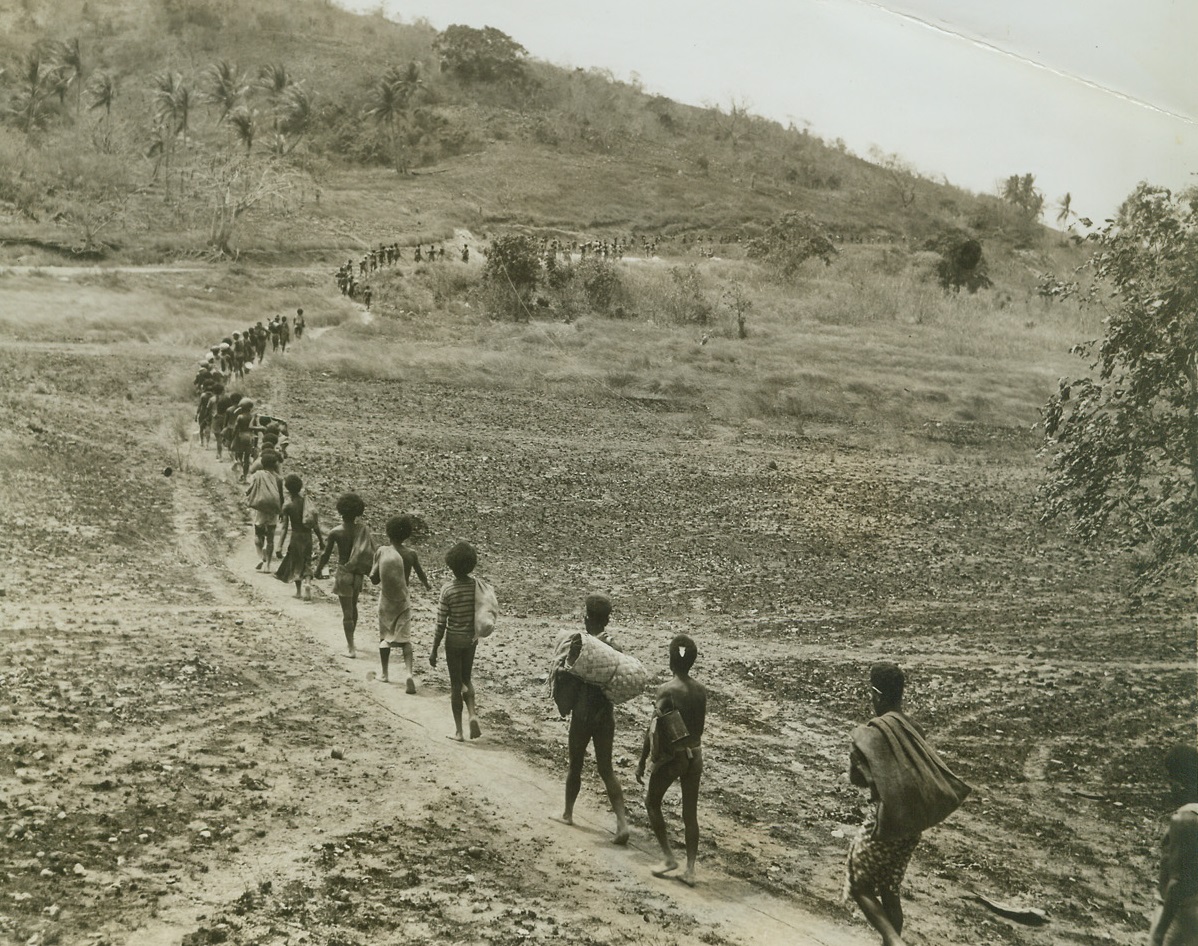
Supplies on the March, 9/17/1942. New Guinea – Each New Guinea native shoulders about forty pounds of supplies, as they make their way on foot to the interior of New Guinea where allied troops are holding off a heavy Jap push toward port Moresby, main allied base. Credit line (ACME);
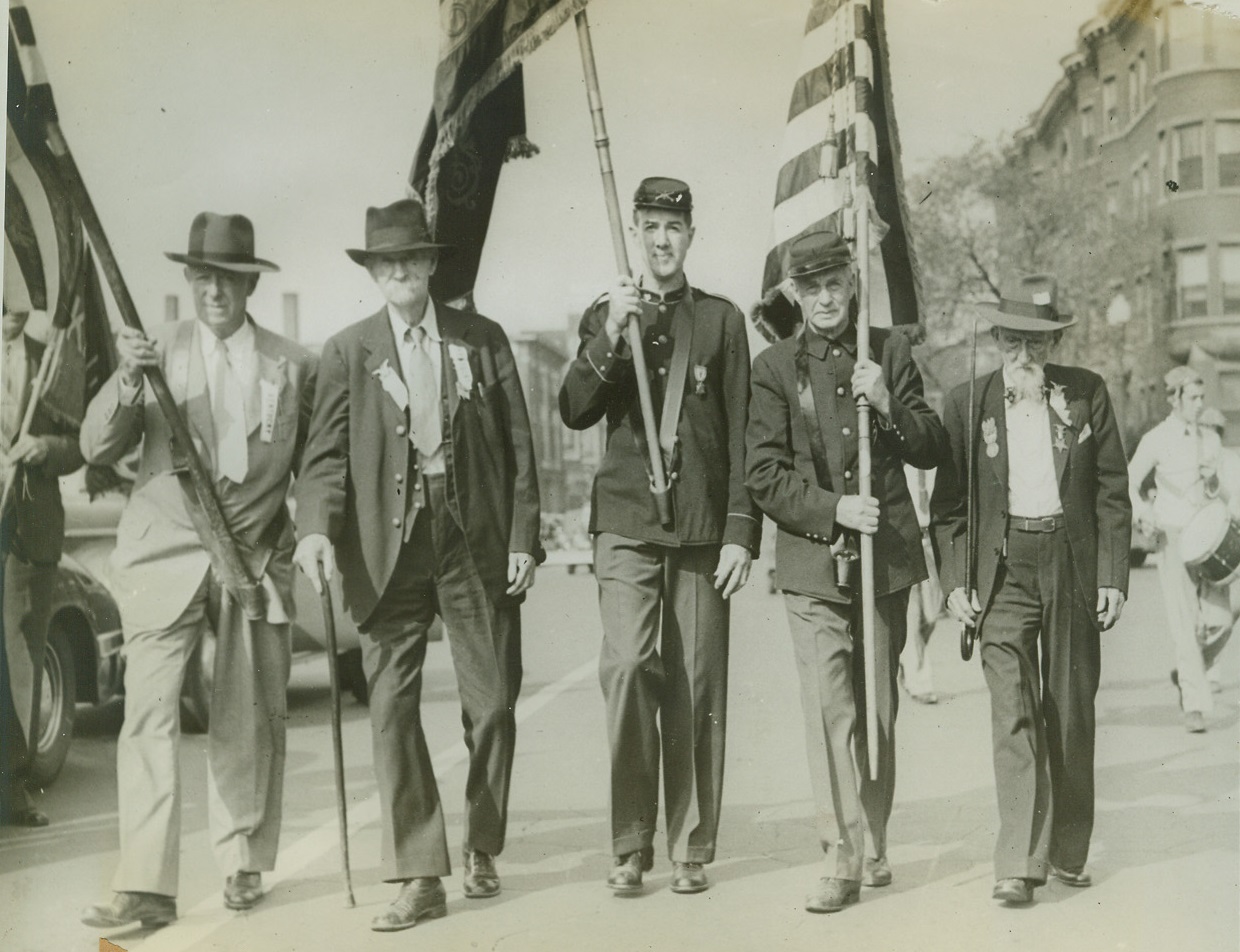
G.A.R. Hold 76th National Encampment Parade, 9/16/1942. Indianapolis, Ind.: Although most of the sixty members of the Grand Army of the Republic rode in the annual encampment parade, four veterans marched the entire distance. R.R. Graham, 97, of Madisonville, Ky (second from left) and Robert Barrett of Princeton, Ky. (right), two of the veterans who marched are shown with their sons of Civil War escorts (left to right) C.C Holstner, B.R. Green and David Wasser. Credit line (ACME;
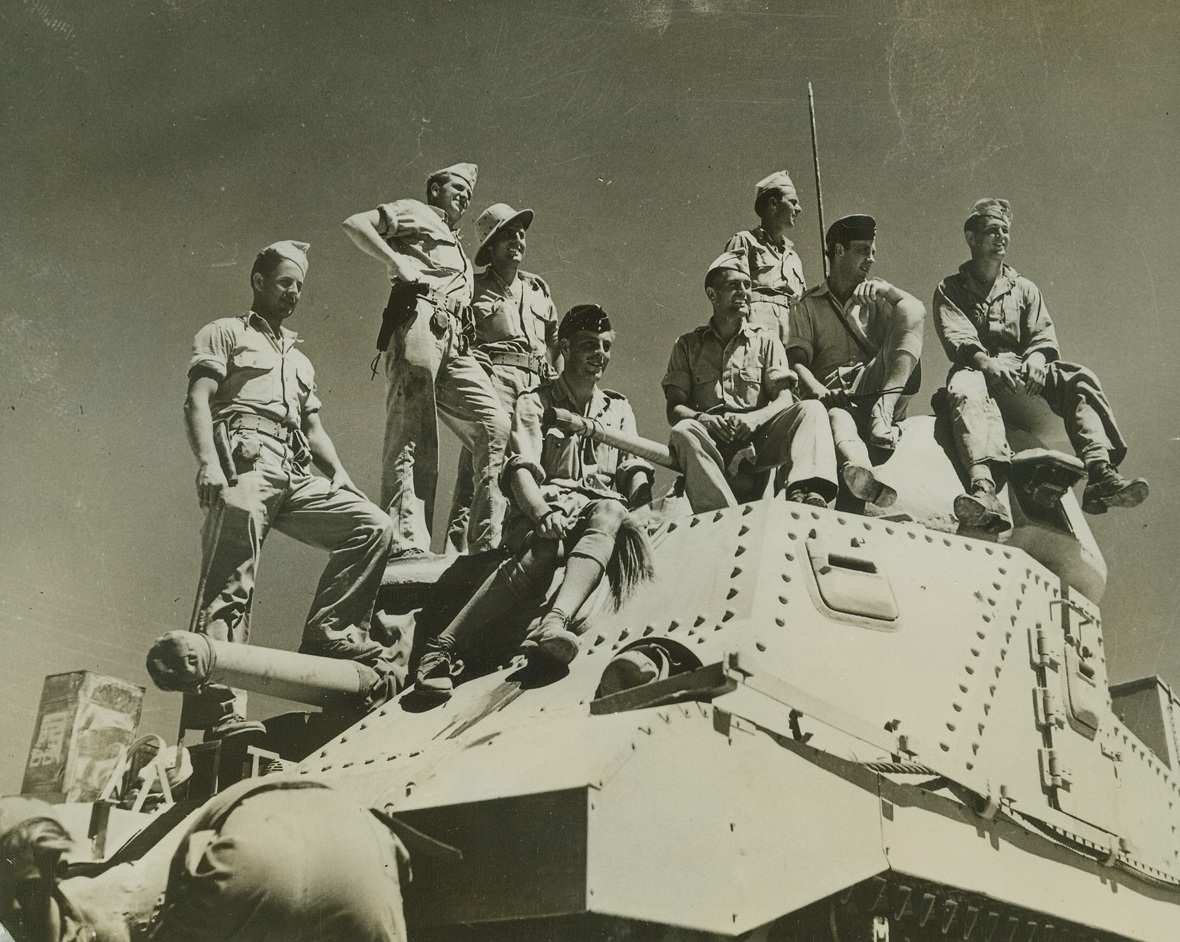
U.S. and British Tankmen in the Desert, 9/11/1942. Egypt – A group of American and British tankists take a breathing spell atop a U.S. – built tank in the Egyptian desert, where the Yank tank crews have been practicing behind the lines to acclimate themselves to the desert heat and to familiarize themselves with methods of desert warfare. The two lads in black overseas caps are Britishers. Their behind-the-lines days over, some of the U.S. crews have recently been reported in action against Rommel’s Africa Korps – and doing pretty well for themselves, too. Credit line (ACME);
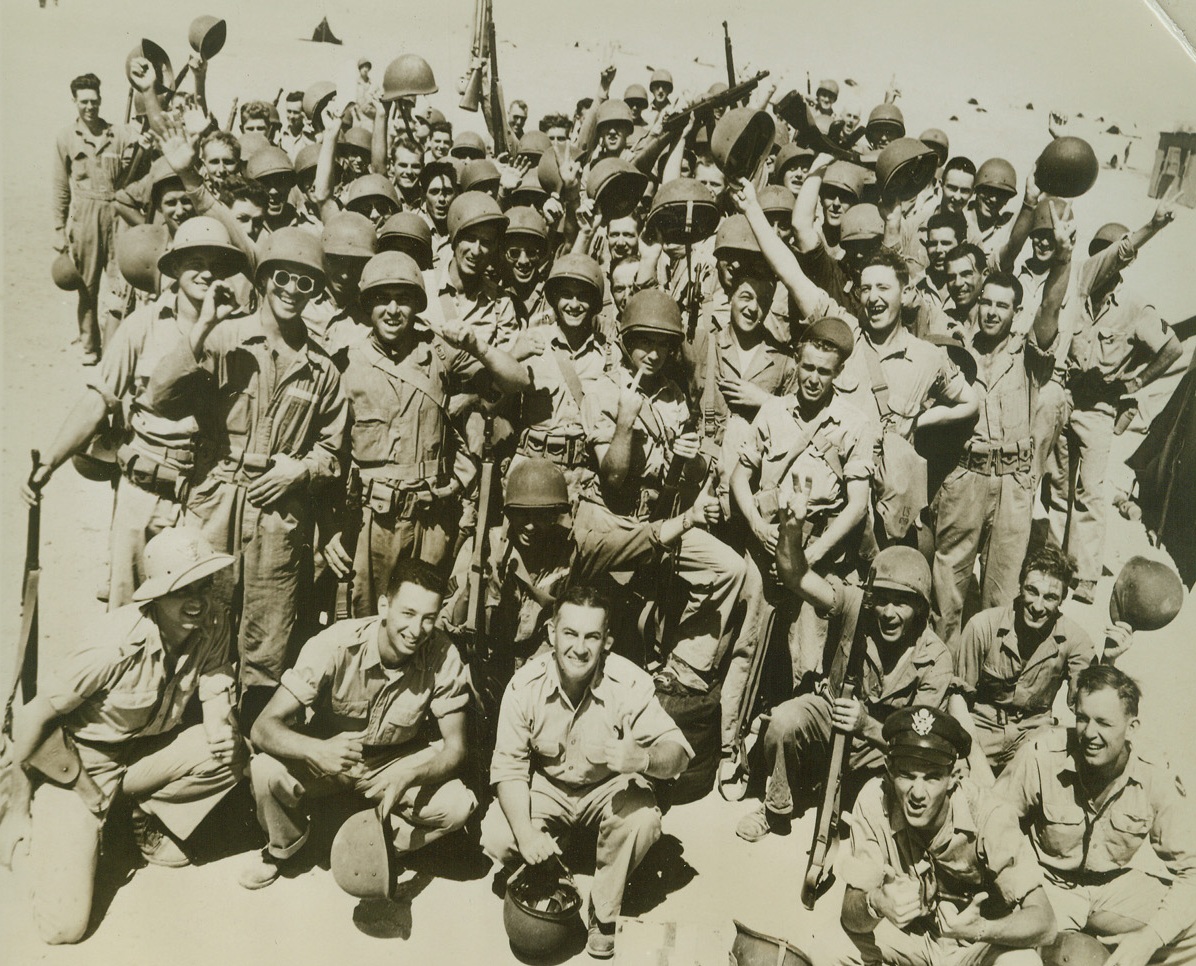
New U.S. Arrivals in Middle East, 9/12/1942. Middle East – It’s a toss-up between thumbs-up and V for victory signs with these newly arrived American troops somewhere in the Middle East. Here in their desert camp the boys are full of pep and smiles and rarin’ to go. Credit line (ACME);
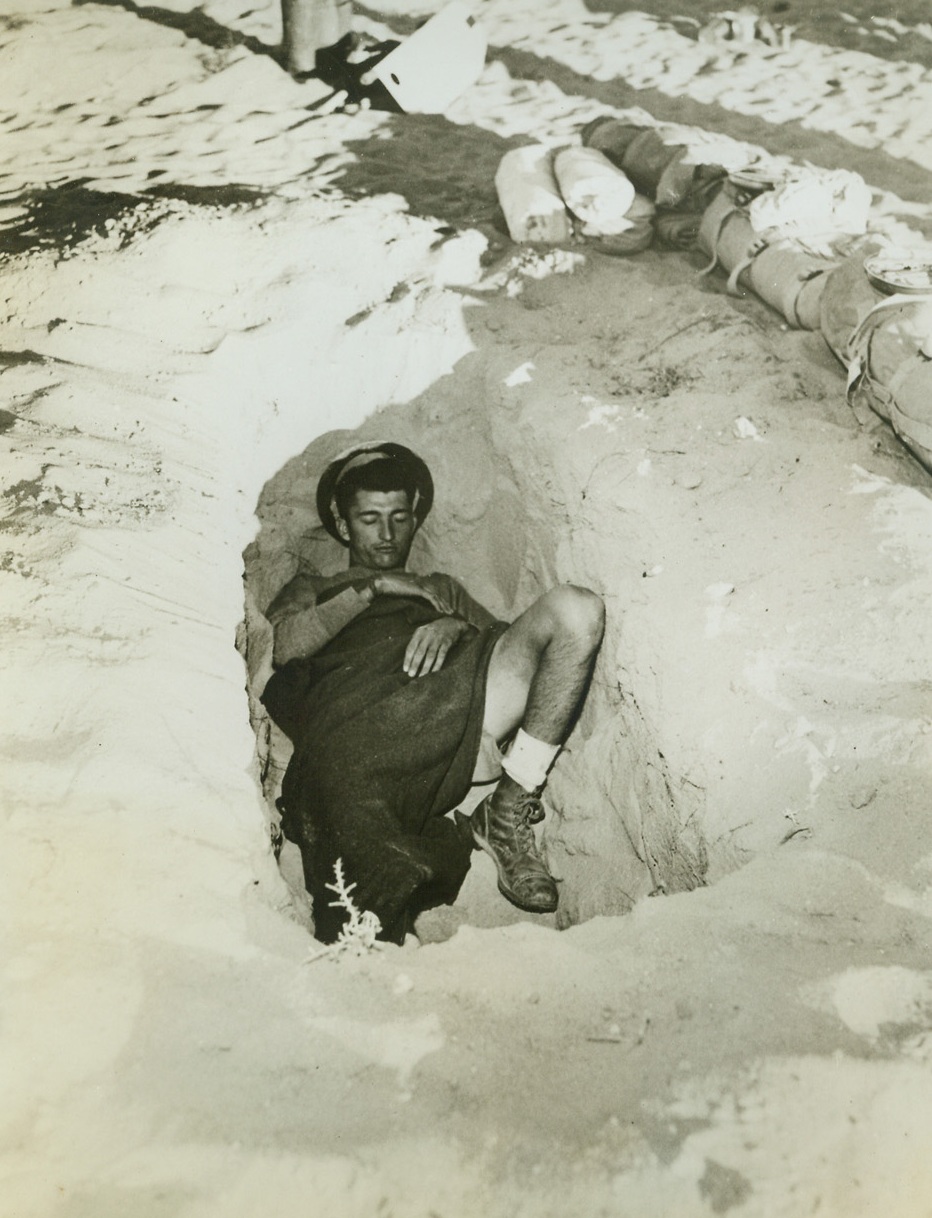
Desert Bed, 9/11/1942. Egypt – Here’s how a U.S. tankist parks himself for the night on the Egyptian desert. He digs himself a slit-trench bed, which isn’t exactly a commodious as his bed at home but affords shelter from enemy shrapnel. Note that the Yank, Benjamin Folsom Jr., prefers British shorts to trousers for wear under the scorching desert sun, as do many Americans in Egypt. Credit line (ACME);
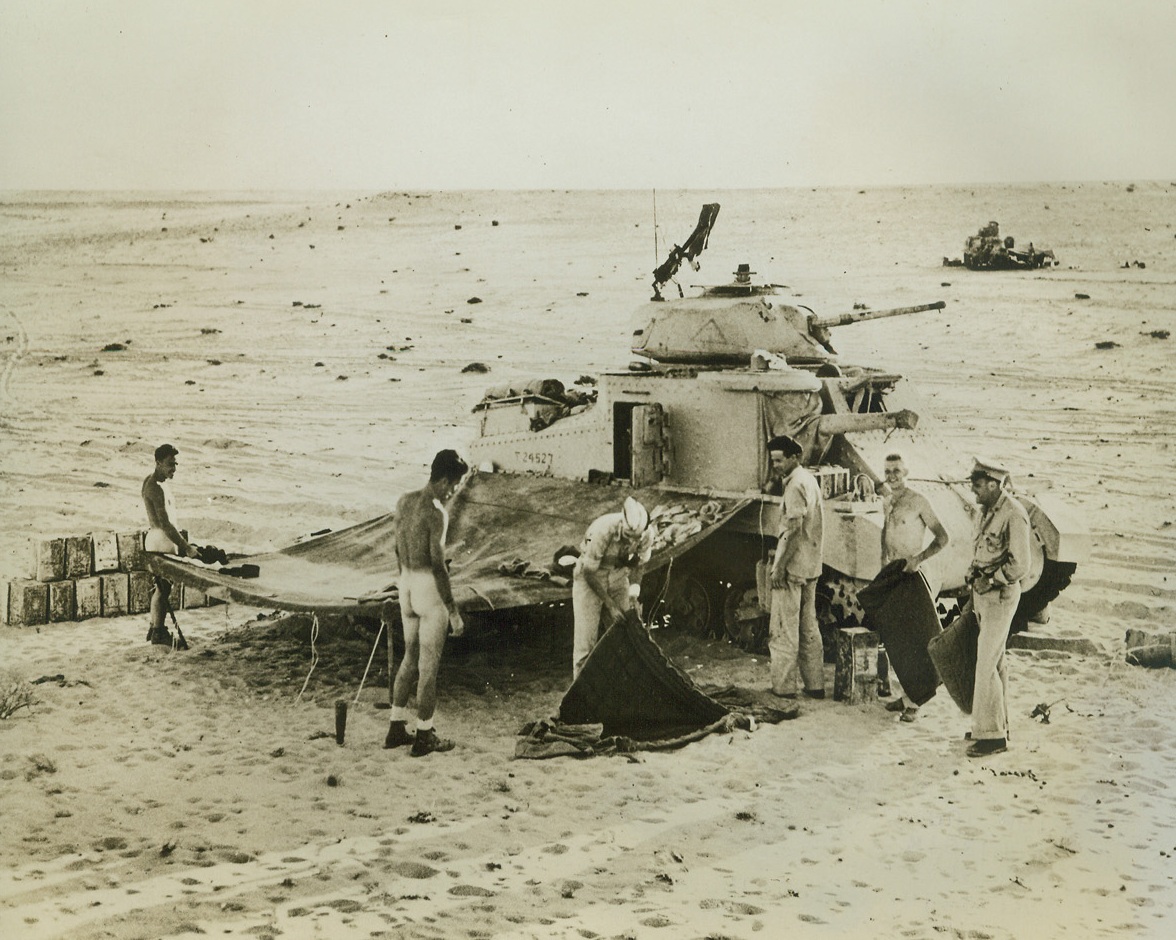
Bedding Down in the Desert, 9/11/1942. Egypt – Here’s how U.S. tankist park for the night in the Egyptian desert. These two tank crews are a scant 3 ½ miles from the enemy lines. Note that the two tanks are widely separated so that one bomb could not put both out of commission. Men are unloading the tank and getting some of the sand out of their bedrolls. For desert-style beds, see companion picture.Credit line (ACME);
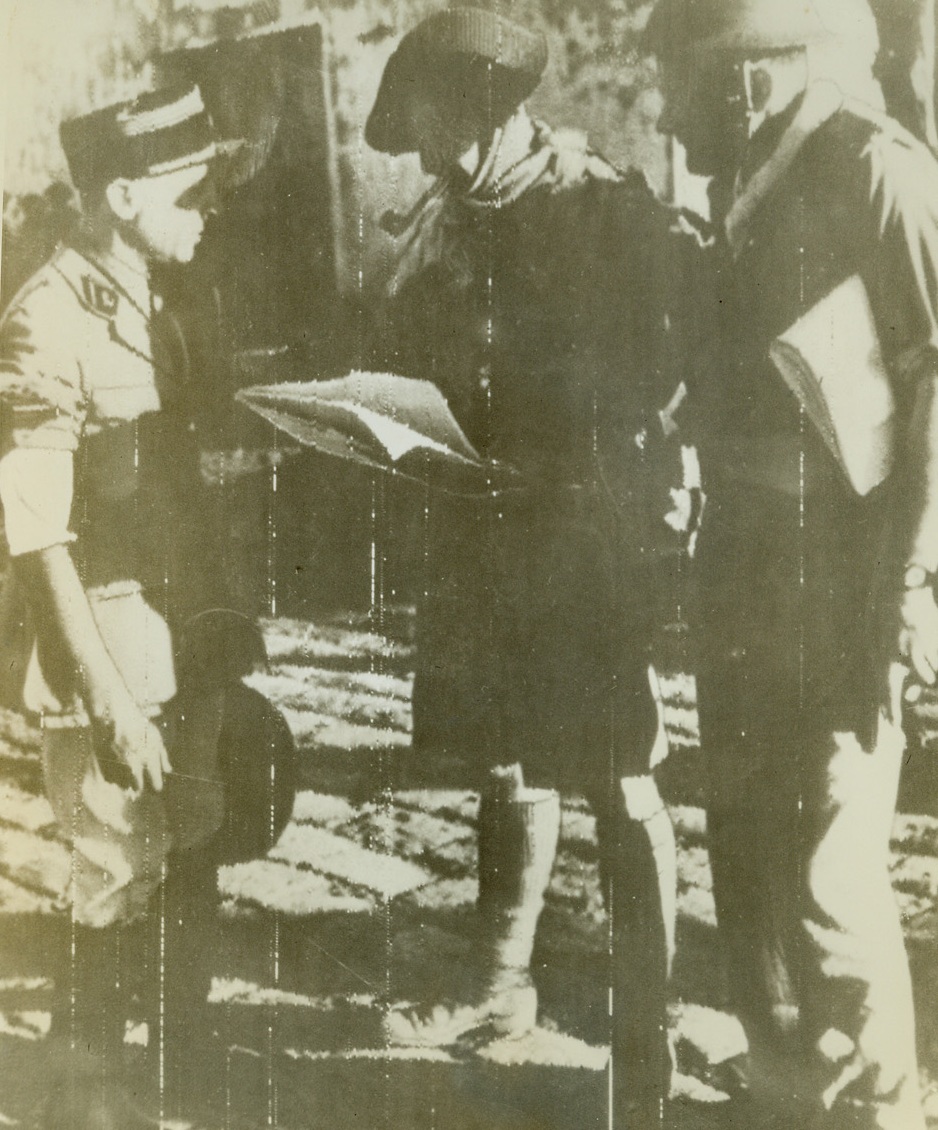
At Capture of Majunga, 9/29/1942. This photo flashed by radio from Cairo to New York, Sept. 29, shows British officers, (right and center) as they interview the French Commandant, Chef De Battalion Martin, at Majunga, after the capture of that strategic Madagascar port, Sept 10. Credit line (ACME radio photo);
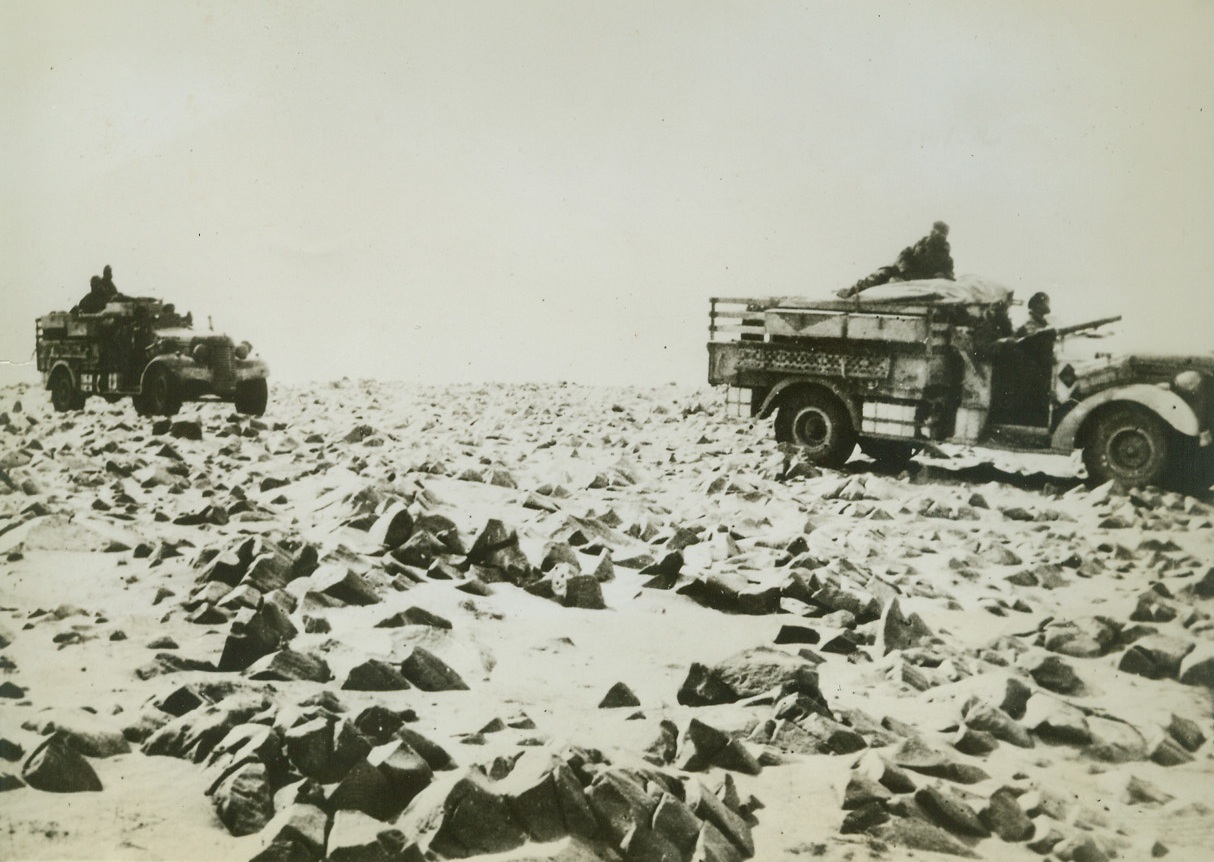
Here’s Why An Army Needs Good Rubber Tires, 9/24/1942. North Africa – Trucks of the long range desert patrol manned by picked British and New Zealand troops bump along the rock desert 100 miles South of Bengas. These patrols recently carried out attacks on Bengasi, Barce, and Gialo, and have made raids as far as the outskirts of Tripoli. Credit line (ACME);
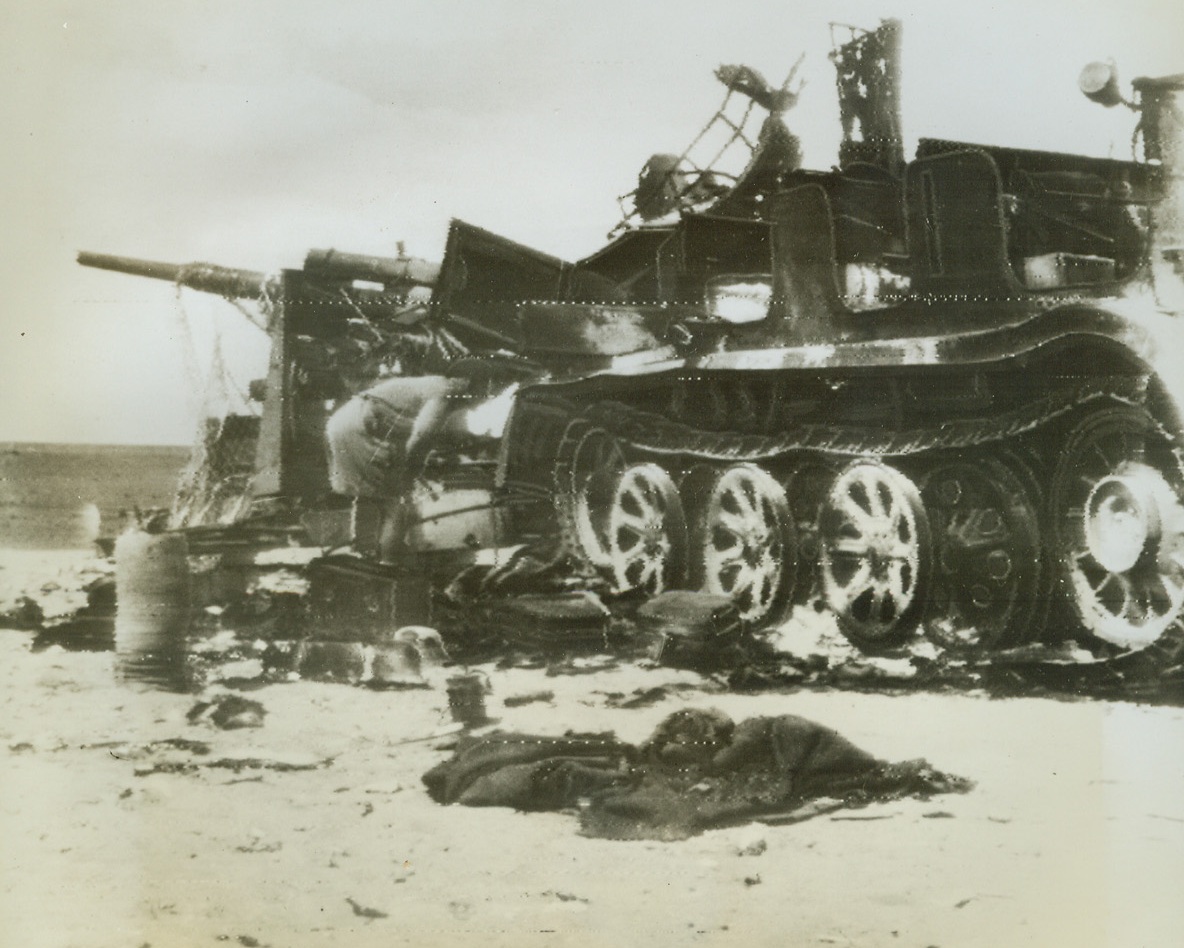
Badly Busted, 9/9/1942. Western Desert - - A British tommy gets a close look-see at this busted and battered tractor which was once used to draw the 88 mm Nazi gun in the background. The whole outfit, which included accommodations for the German gun crew, was made scrap by direct hits of crack British artillery gunners. Wrecks like this one are not unusual sights on the Western Desert front where Allied airmen and soldiers have successfully checkmated Rommel’s drive for Alexandria and the Suez. Photo was radioed directly from Cairo to New York, Sept. 9th. Credit line (ACME radio photo);
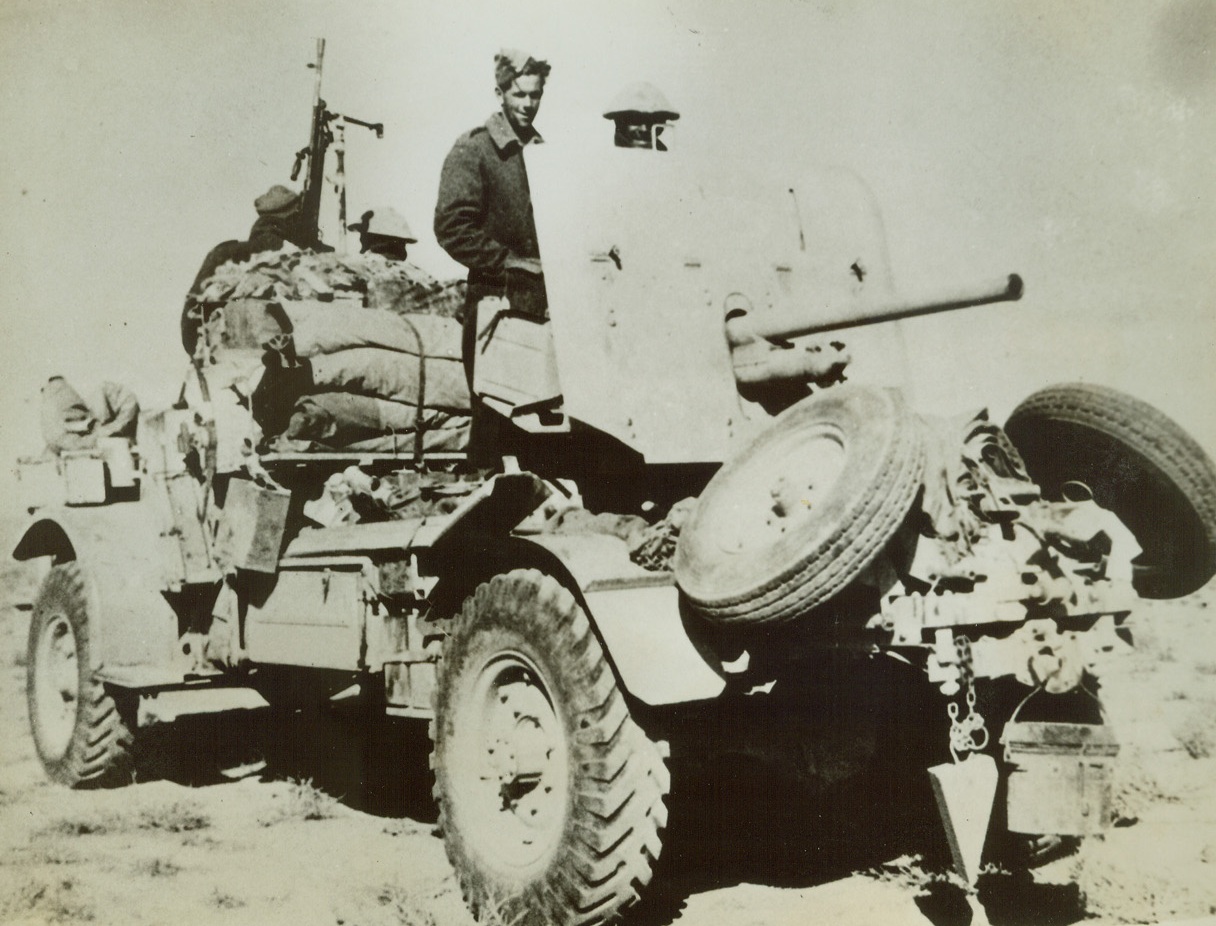
Anti-Axis Desert Patrol Guns, 9/24/1942. North Africa—Recent Allied raids into Axis positions deep in Cyrenacia depend upon special equipment such as this truck manned by New Zealanders who are members of the Long Range Desert Patrol. They are shown with an anti-tank light machine gun on a specially built carriage which carries supplies for wide reconnaissance and battle raids. Credit: ACME.;
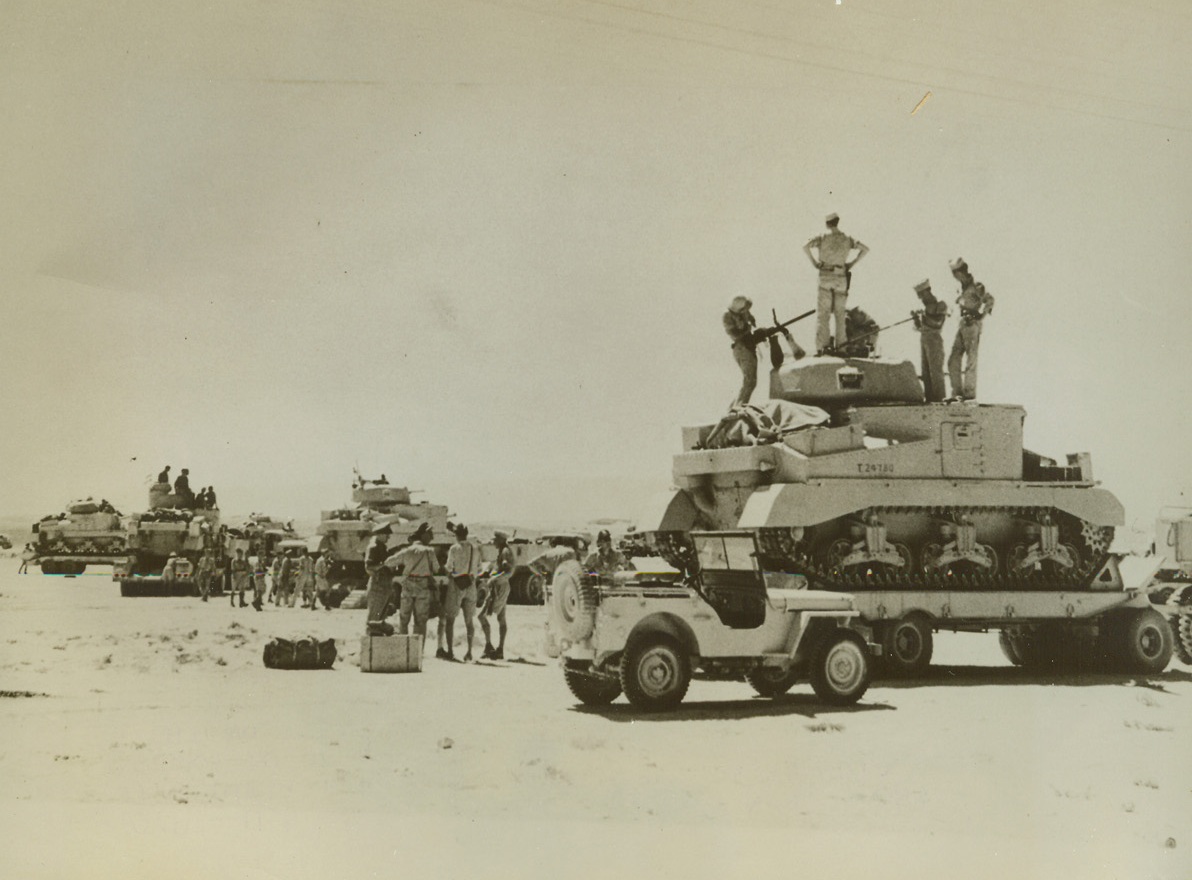
Desert Tank Taxi, 9/11/1942. Egypt—U.S. M-3 (General Grant) tanks, along with their American crews, are loaded onto trucks to be hauled closer to the actual fighting front on the Egyptian desert, where they will be unloaded to continue on their own. The tank-taxi service, a new wrinkle in desert warfare, saves wear and tear on both tanks and men. Passed by censors. Credit: ACME.;
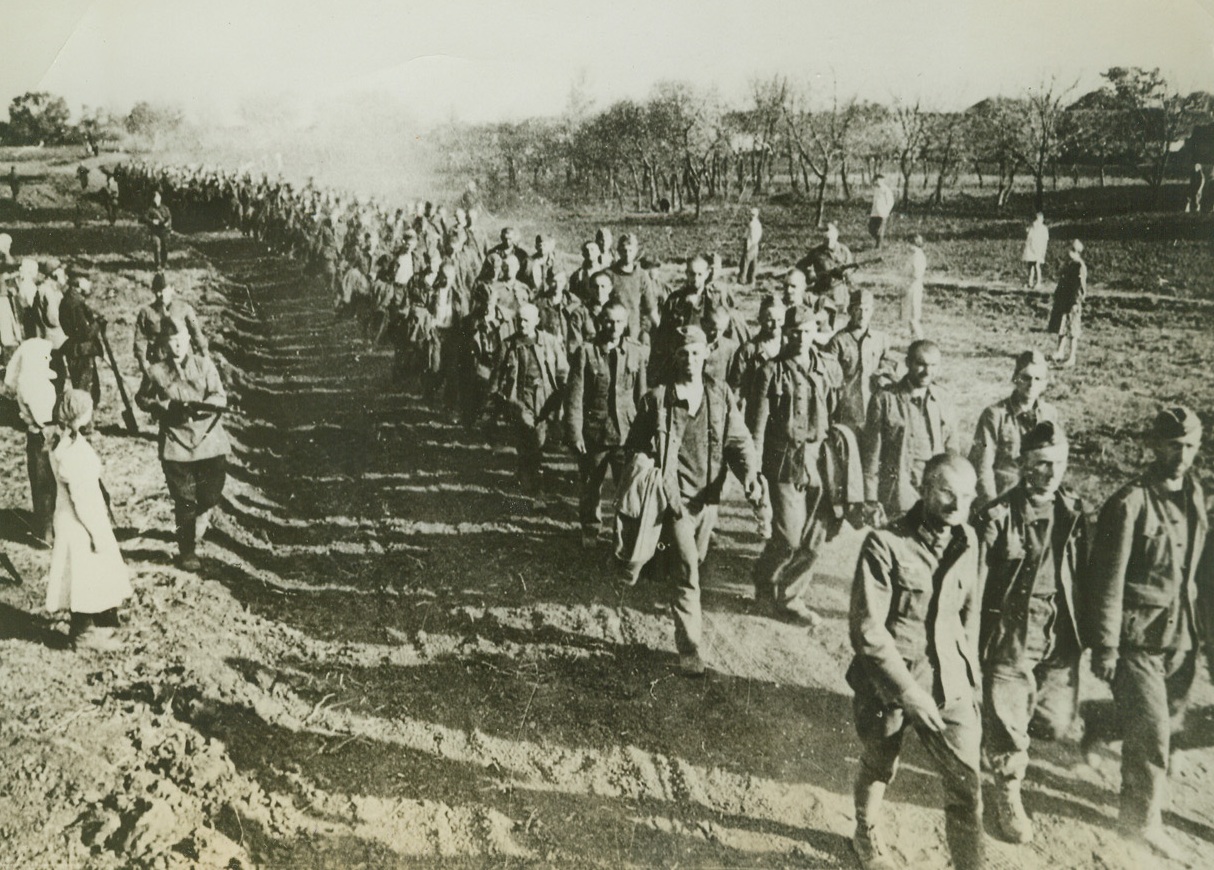
End of Their Army Careers, 9/17/1942. Russia—Russian villagers watch this long line of captured Nazi soldiers marching along a dusty road behind the Soviet lines into captivity. Their armed guards watch them closely. The Nazis are gaining ground in Russia, but only at the cost of many men lost and captured, and much equipment destroyed—if they can gain enough ground, they’ll lose the war. (Passed by censor). Credit: ACME.;
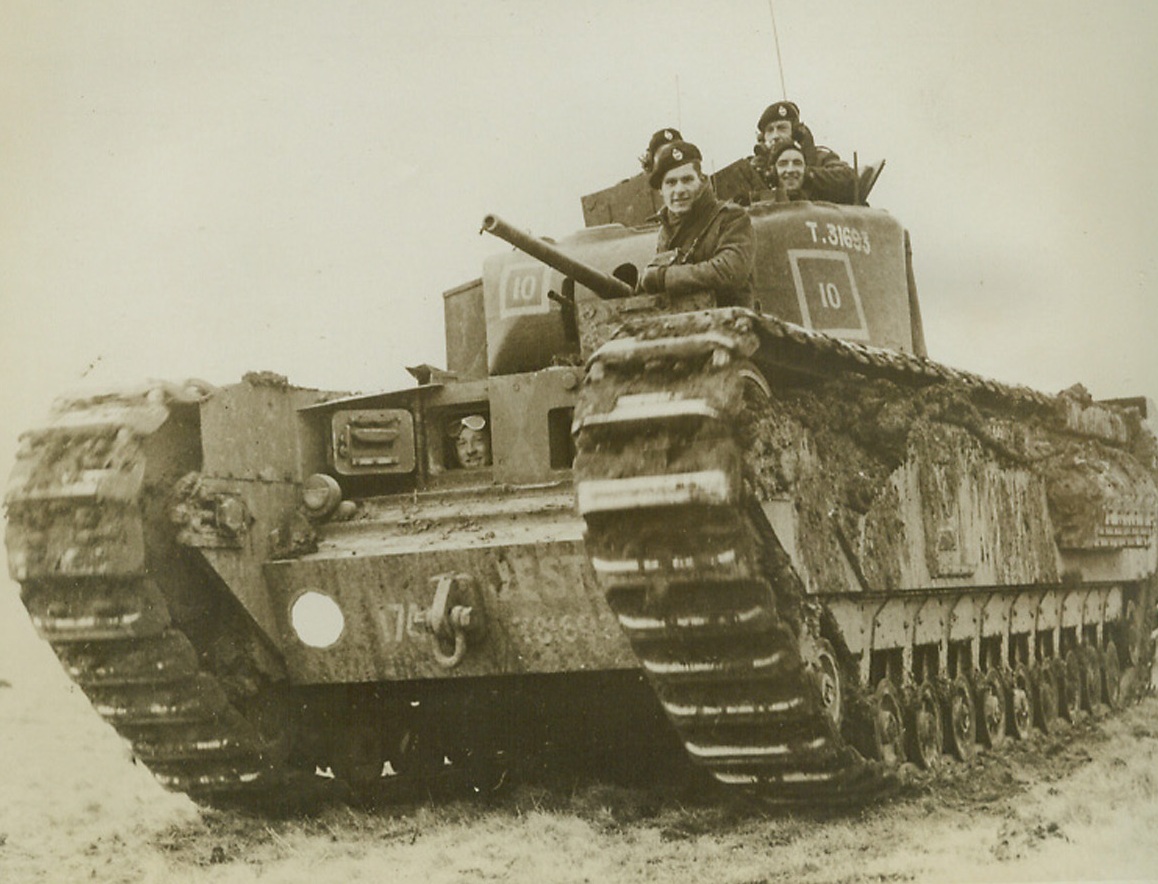
Churchill’s Namesake, 9/28/1942. England—Britain’s new infantry tank, shown here on maneuvers, is called the “Churchill.” It is so heavily armored that it can be used as a pill-box, has 6-pounder guns, and can move along at a startling speed. (Passed by censor). Credit: Official British photo from ACME.;
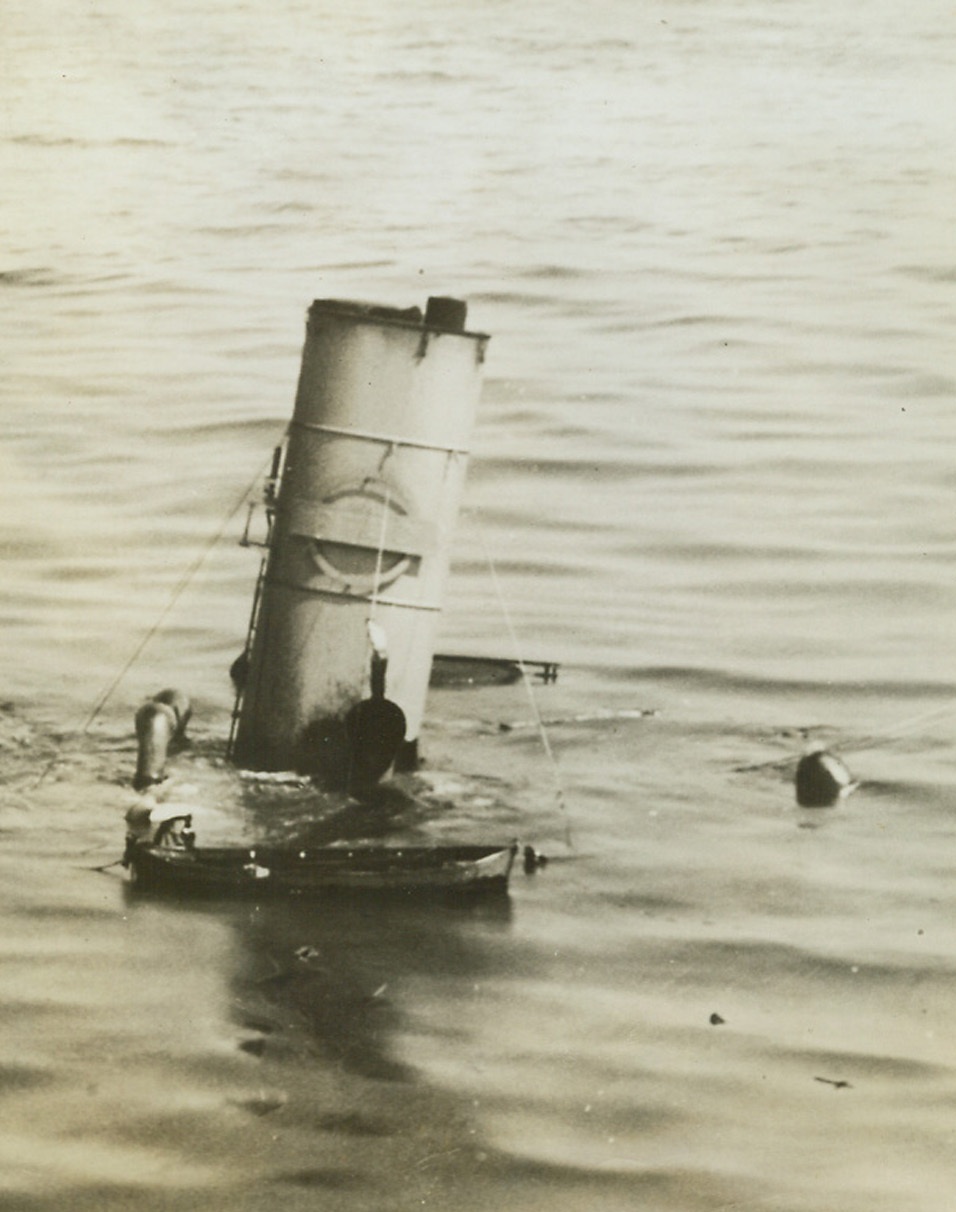
Atlantic Dilemma, 9/29/1942. You don’t have to tell this seaman of a torpedoed merchantman that the battle of the Atlantic is still in full swing. Standing on a funnel just a few feet above the surface of the swiftly rising water, he’s weighing his chances of getting away safely in a life boat which is still moored to its davits. Photo has just been released by the U.S. Navy. Passed by Navy censor. Credit: U.S. Navy photo from ACME.;
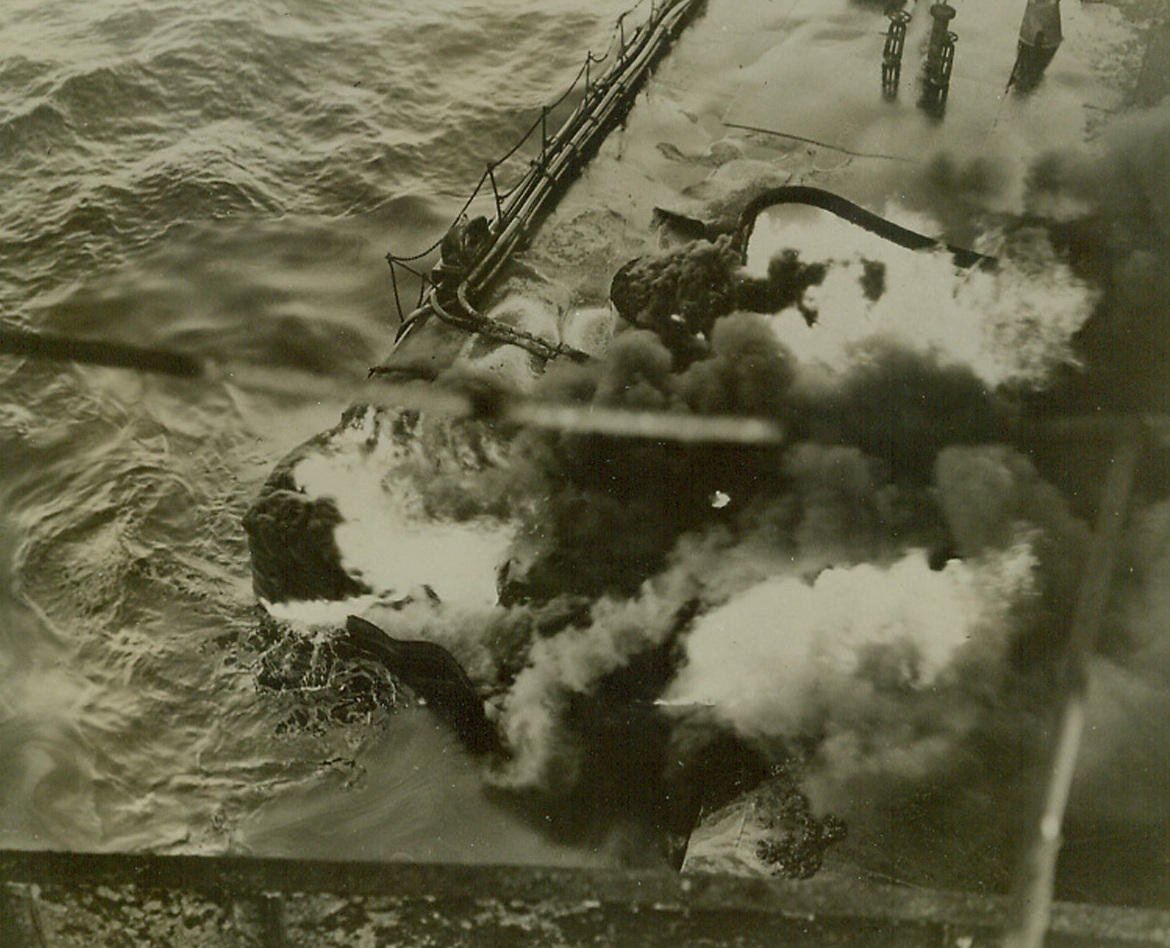
Saga of the Atlantic, 9/28/1942. Somewhere in the Atlantic—Flames still rage around the gaping hole torn by the torpedo when it struck a tanker approximately amidships on the portside as oil in the foreground sluggishly moves out into the ocean. Despite a raging fire which sent columns of smoke billowing into the sky, crew members were able to bring the flames under control and the tanker was towed to port by a U.S. Naval ship. The tanker is now in an east coast ship yards under repair and it will soon see service again against its enemies. Credit: Official U.S. Navy photo from ACME.;
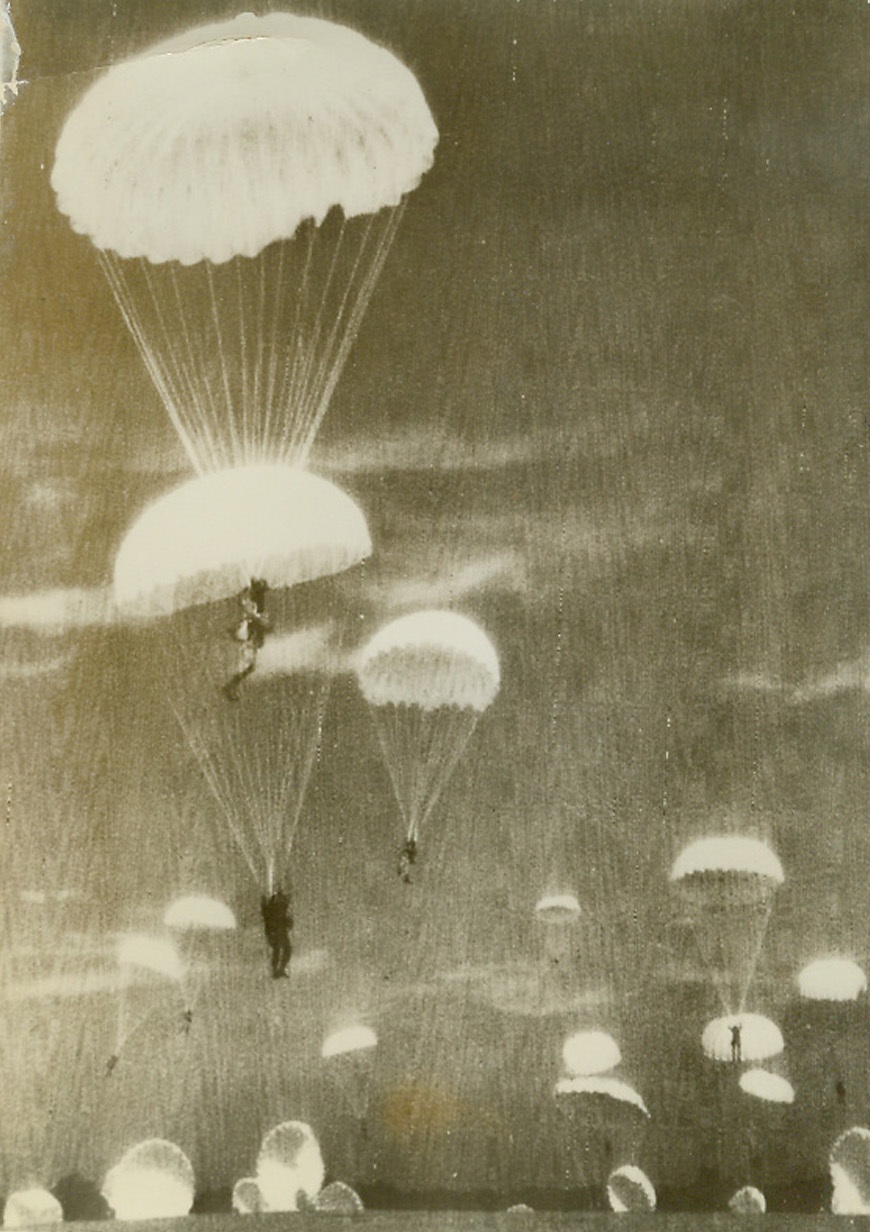
Dress Rehearsal, 9/18/1942. England—During mass invasion exercises in Britain, U.S. parachute troops float down from the skies from operational altitude. Although these troops have been in England for some time, their presence was only made known September 18th from the headquarters of Lt. Gen. Dwight D. Eisenhower, commander-in-chief of the A.E.F. in Europe. Credit: ACME.;
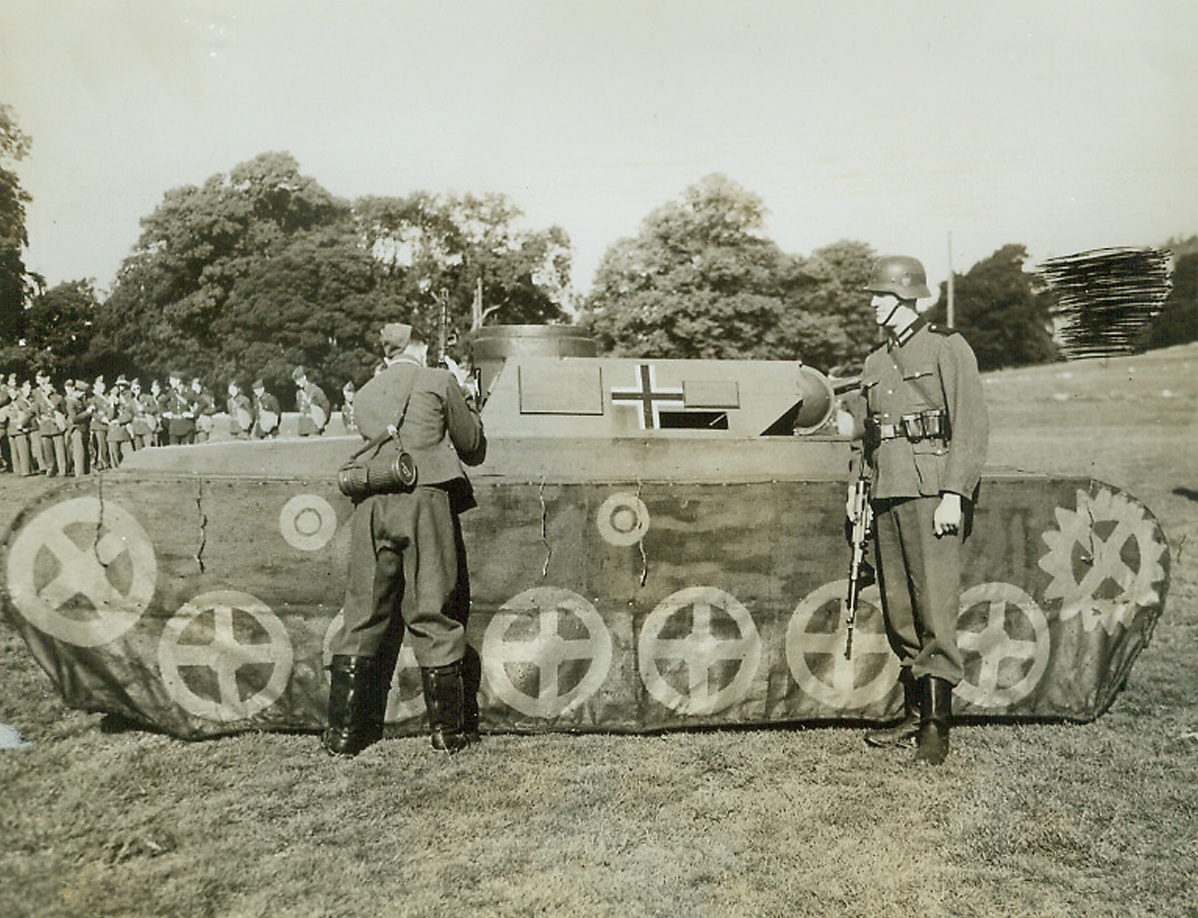
No Klieg Lights at This Preview, 9/18/1942. Northern Ireland—American armoured forces in Northern Ireland receive a demonstration from British soldiers on the various uniforms and weapons used by the Nazis so that they will have a clear picture of the enemy when they go into action. Here an American soldier (left) in German uniform peers inside a German tank as a British soldier also in German uniform looks on. (Passed by censor). Credit: ACME.;
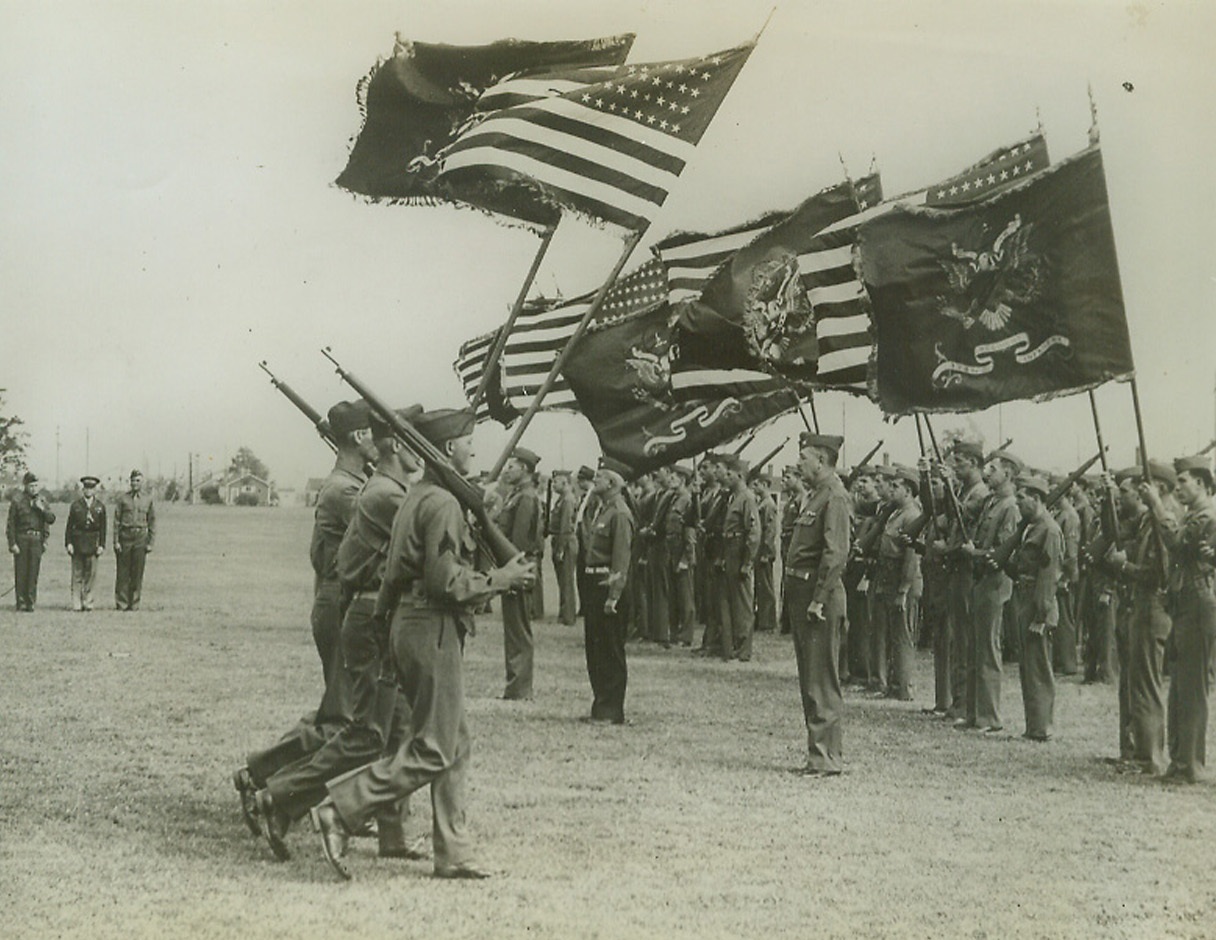
The New 94th Division Receives its Colors, 9/16/1942. Fort Custer, Mich.: Color guards are shown marching with Regimental colors and standards which were presented to the Regimental commanders of the new 94th division which was “activated” in formal divisional review. Major General Harry J. Maloney, Division Commander; Col. Young, and Brig. Gen. Louis J. Fortier, are shown at left.Credit: ACME.;
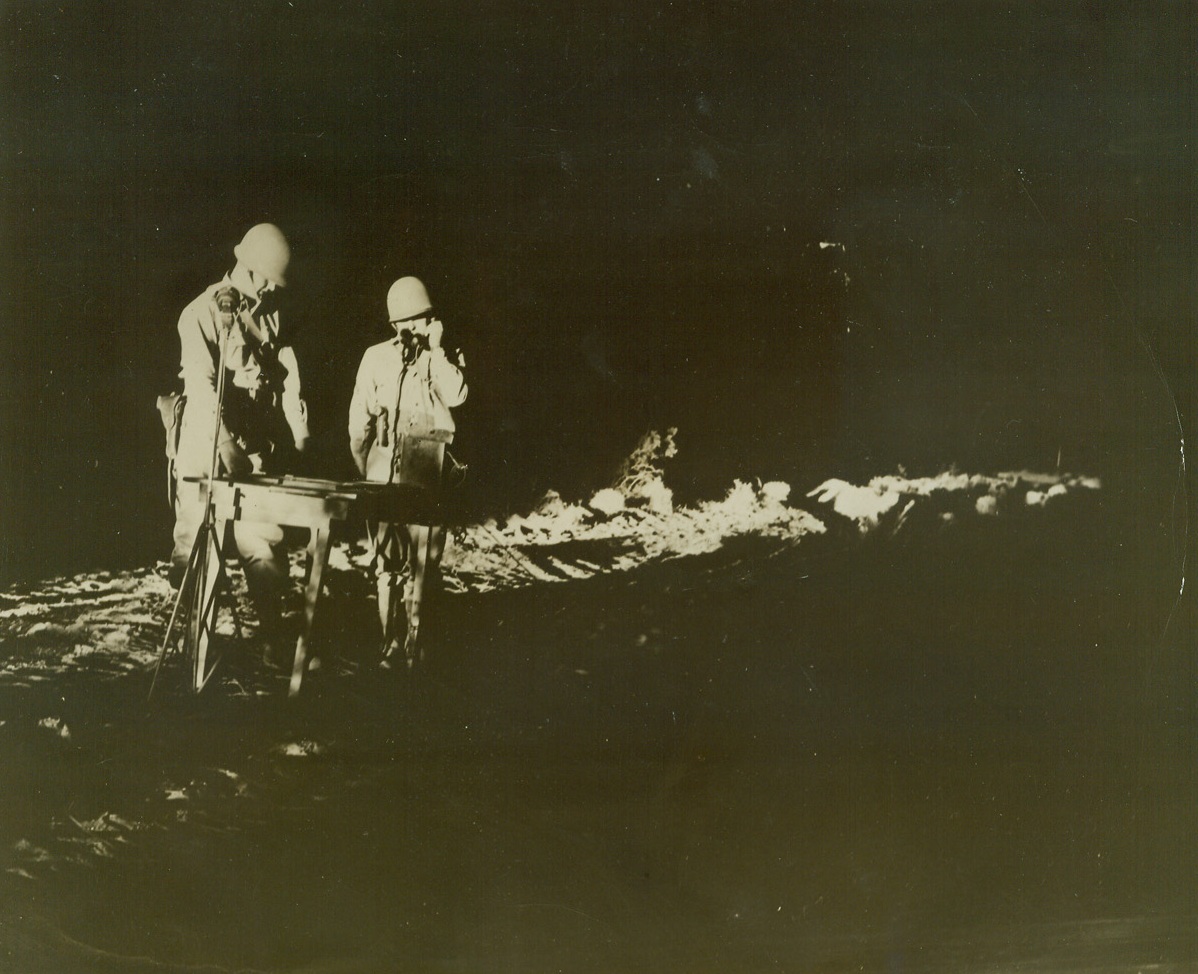
Keeping Tabs on Enemy Sky Raiders, 9/29/1942. California—The aircraft piloting crew of an anti-aircraft coast artillery unit holding a practice demonstration in the California desert (illegible portion of caption) during night maneuvers. They relay reports from the plane detector crews to a switchboard where the course of the enemy plane is (illegible word).Passed by Army censor.Credit: ACME.;
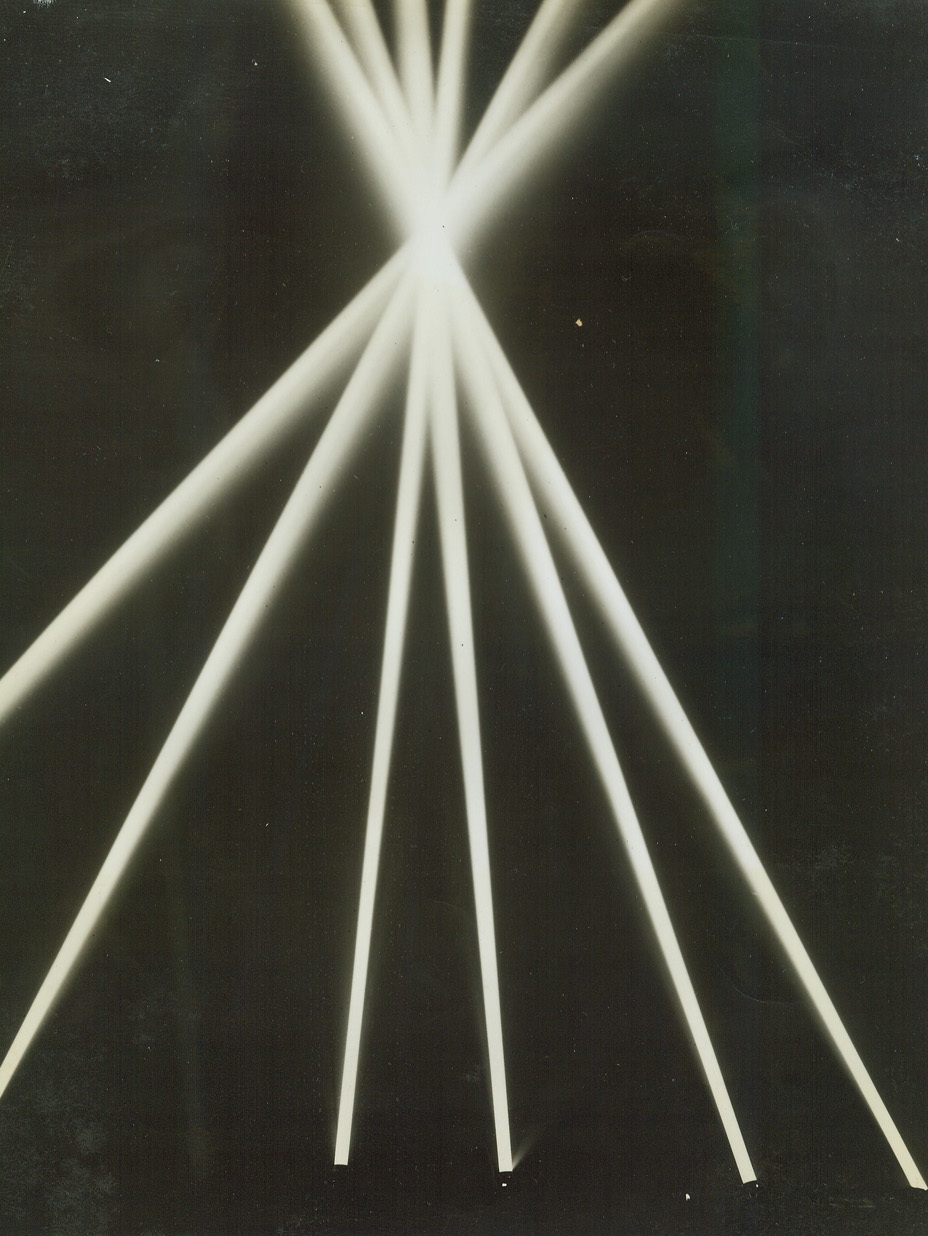
Defense Pattern, 9/29/1942. California—A half-dozen big searchlights of anti-aircraft coast artillery unit holding a practice demonstration in the California desert are converged on a point to show how a number of beams can spot a plan and follow it in flight after it has been located by the unit’s sound detectors.Passed by Army censor.Credit: ACME.;
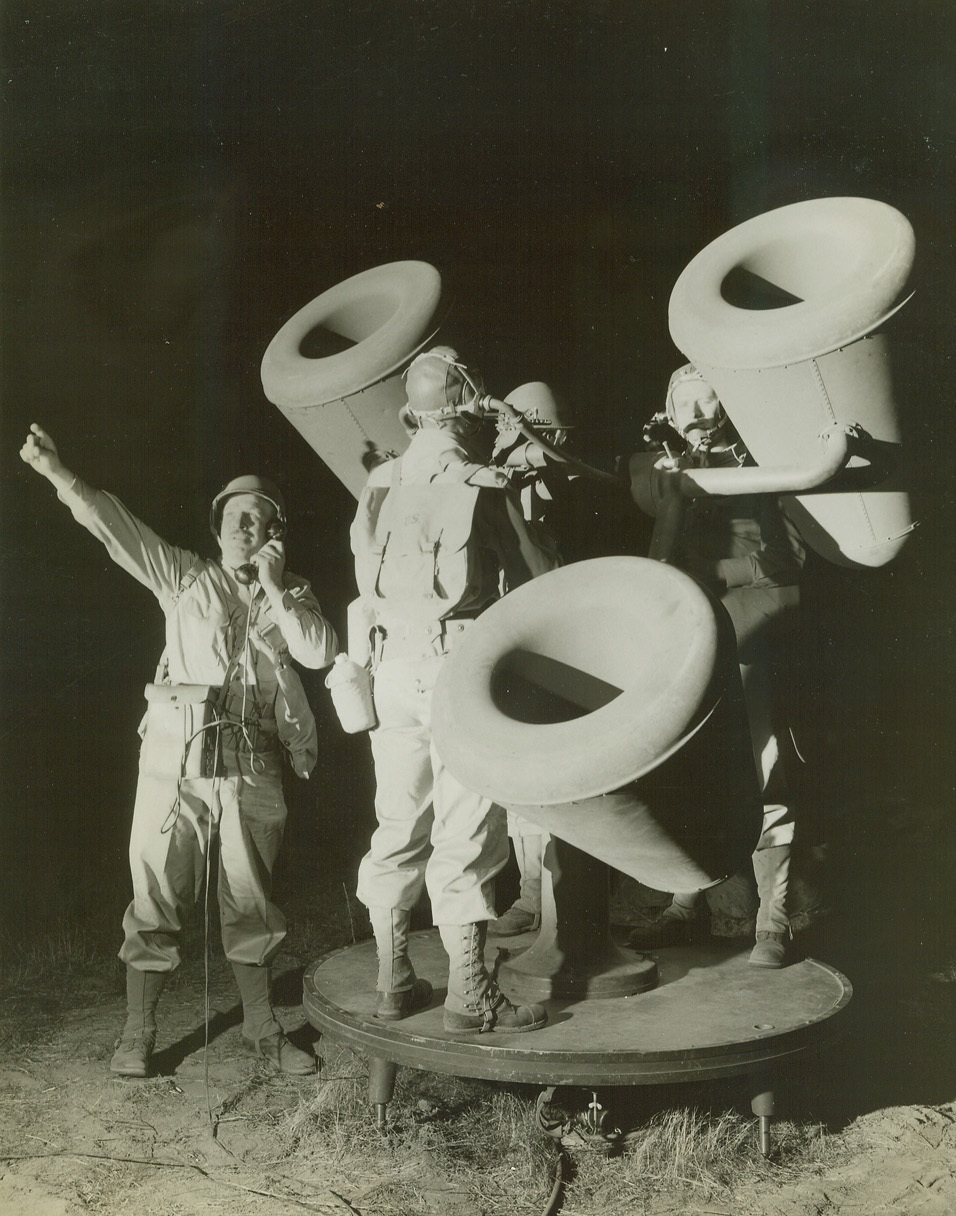
Night Plane Detectors, 9/29/1942. California—The sound detector crew of anti-aircraft coast artillery group operate their big instrument as it picks up the drone of aircraft motors during a practice demonstration in the California desert. The soldier with the portable telephone is the communications man, who reports the position of the plane to the field communications switchboard.Passed by Army censor.Credit: ACME.;
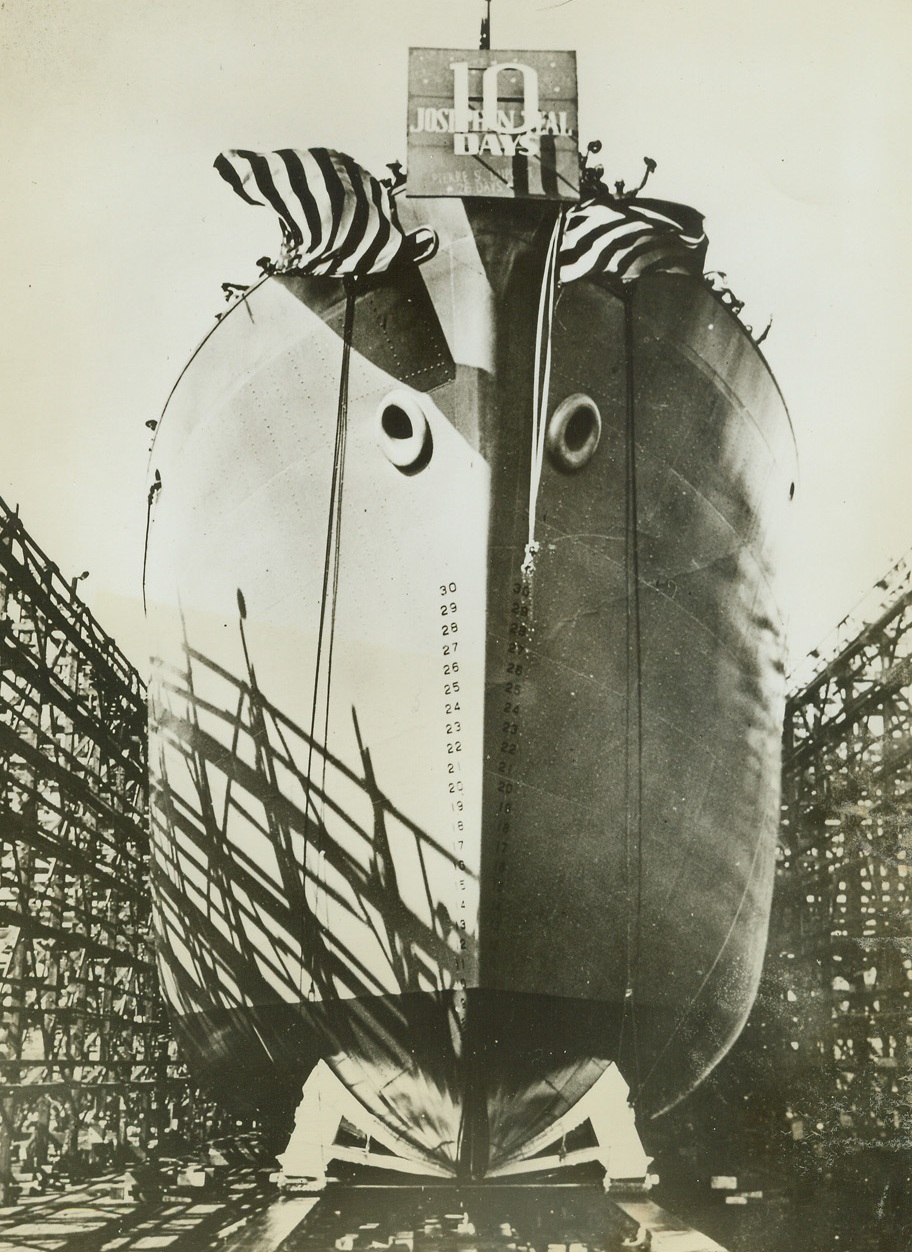
Kaiser Ten-Day Miracle Ship, 9/25/1942. Portland, Oregon—Henry J. Kaiser topped all world ship building records when his Joseph N. Teal hit the water ten days after the laying of the keel. Kaiser indicated that in the future ships may be built in even less time than it took to fashion this 10,500 ton Liberty ship.Credit: ACME.;
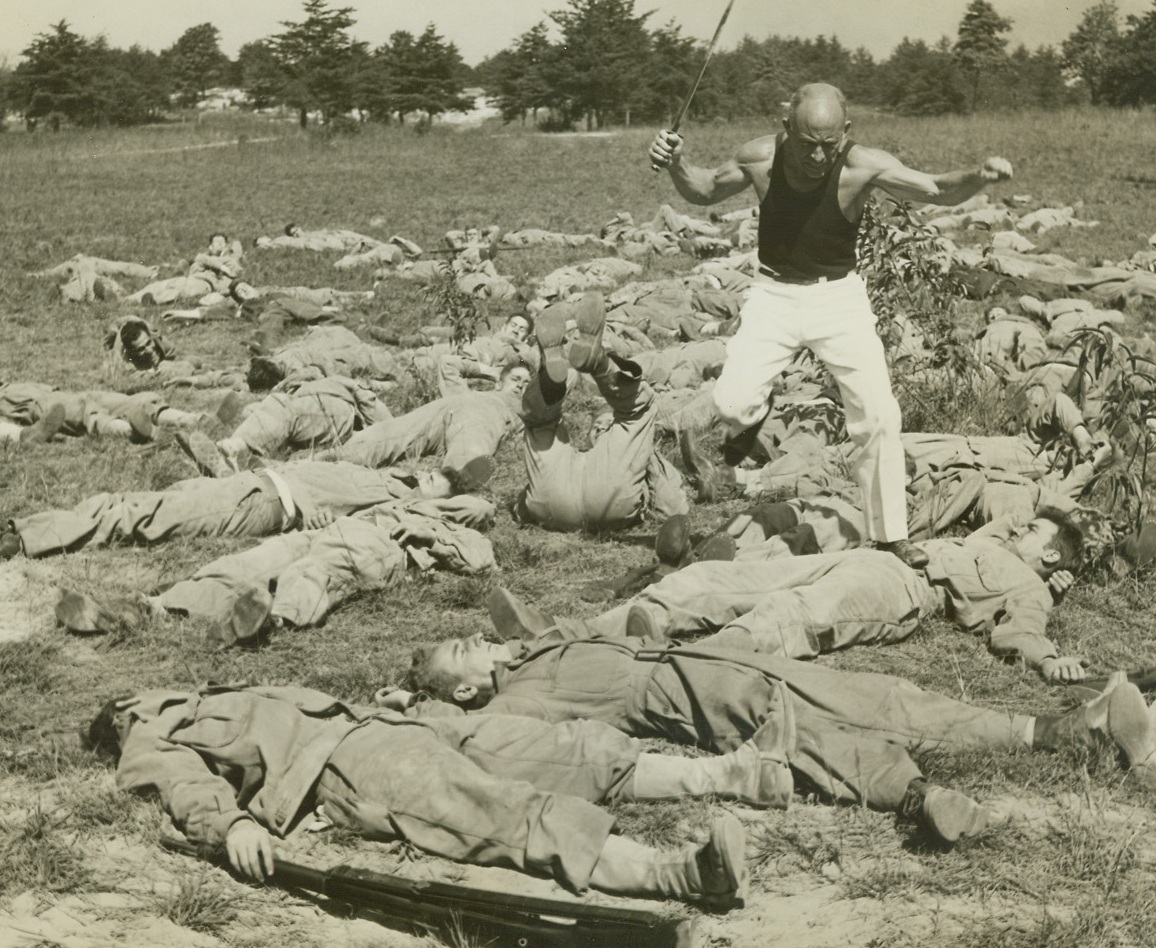
Potential Rangers Undergo Training, 9/25/1942. Fort George G. Meade, MD.—Under the instruction of Major Francois D’Eliscu (above), numbers of American soldiers are undergoing training in preparation for Ranger attacks on our enemy. Here the Major charges over some of the trainees to harden them for future duty.Credit: ACME.;
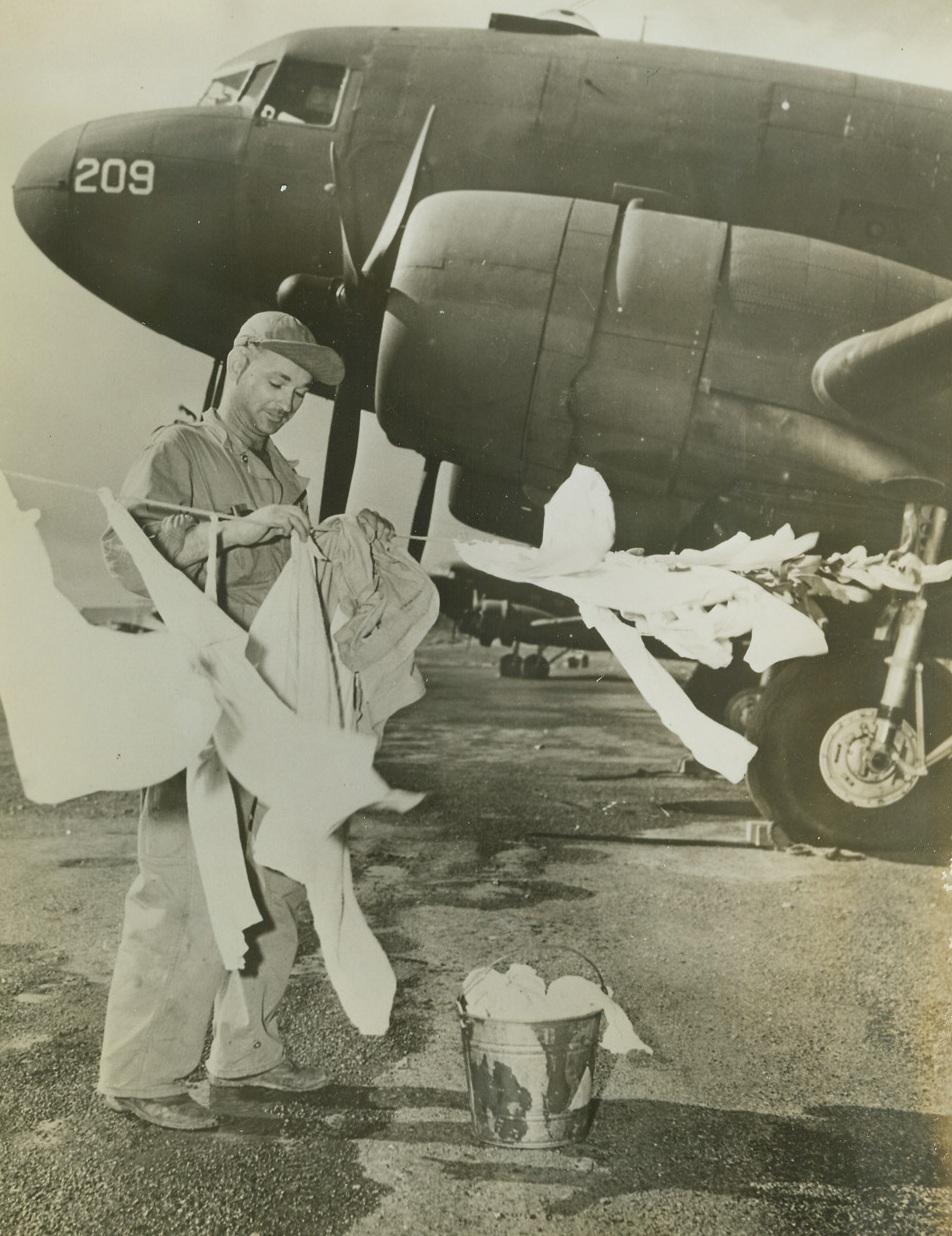
Any Day is Wash Day, 9/12/1942. Washington, D.C.—Sergeant Roland L. Judd, to whom crossing the Atlantic is all part of a day’s work in the Air Transport Command, is hoping his wash will dry before he heads for one of the many North Atlantic bases, from which a steady flow of American bombers is pouring into the United Kingdom.Credit: Official Army photo.;
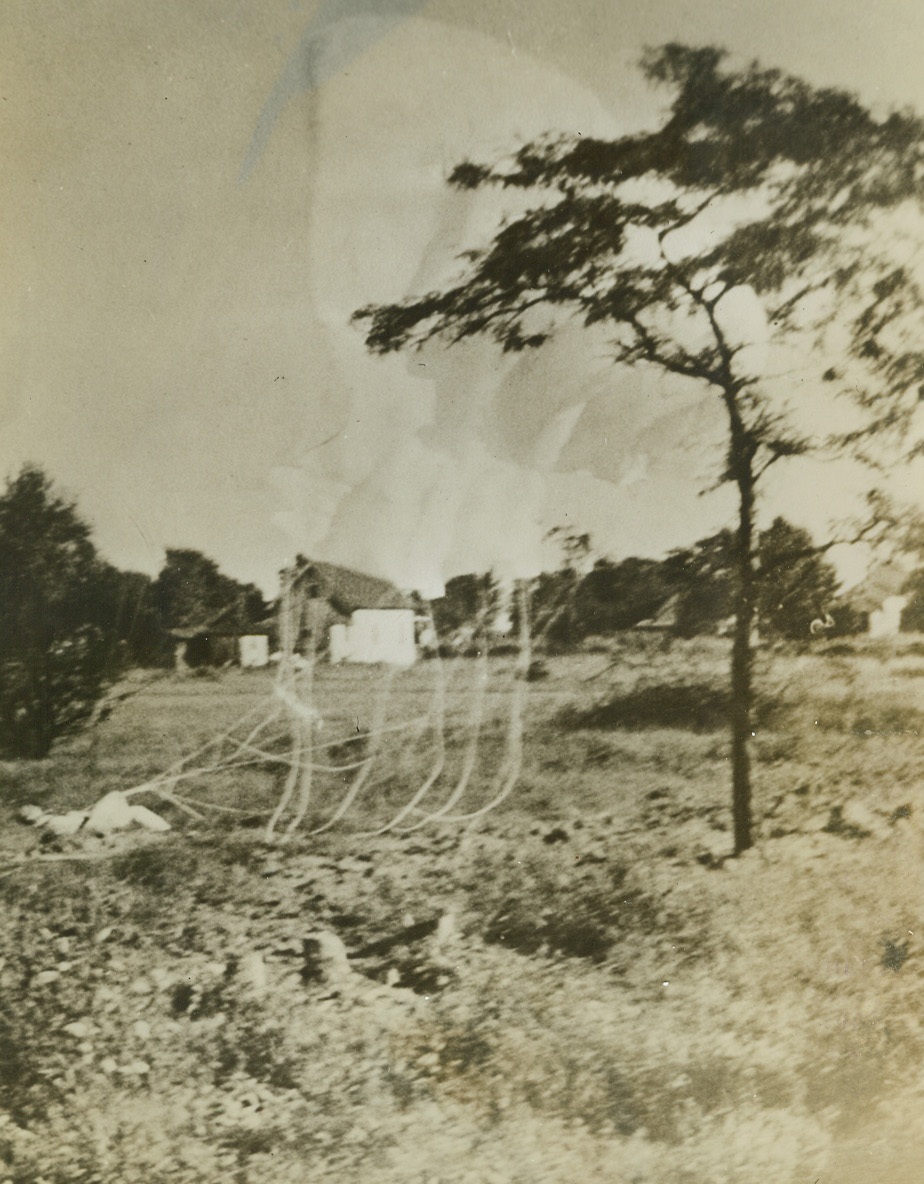
Pilot Escapes Death in Army Plane Crash, 9/12/1942. Buffalo, NY—This dramatic photo shows test pilot J. Bertrand Purnell parachuting to safety after his burning Curtiss plane crashed through the roof of a Curtiss-Wright Airplane Division plant building in Buffalo two miles away. Purnell suffered severe burns and the crash caused 12 deaths and injured 37 persons, 8 of them critically. The FBI is making an inquiry to determine whether sabotage was involved. Pilot Purnell could not explain why the plane caught fire.Credit: ACME.;
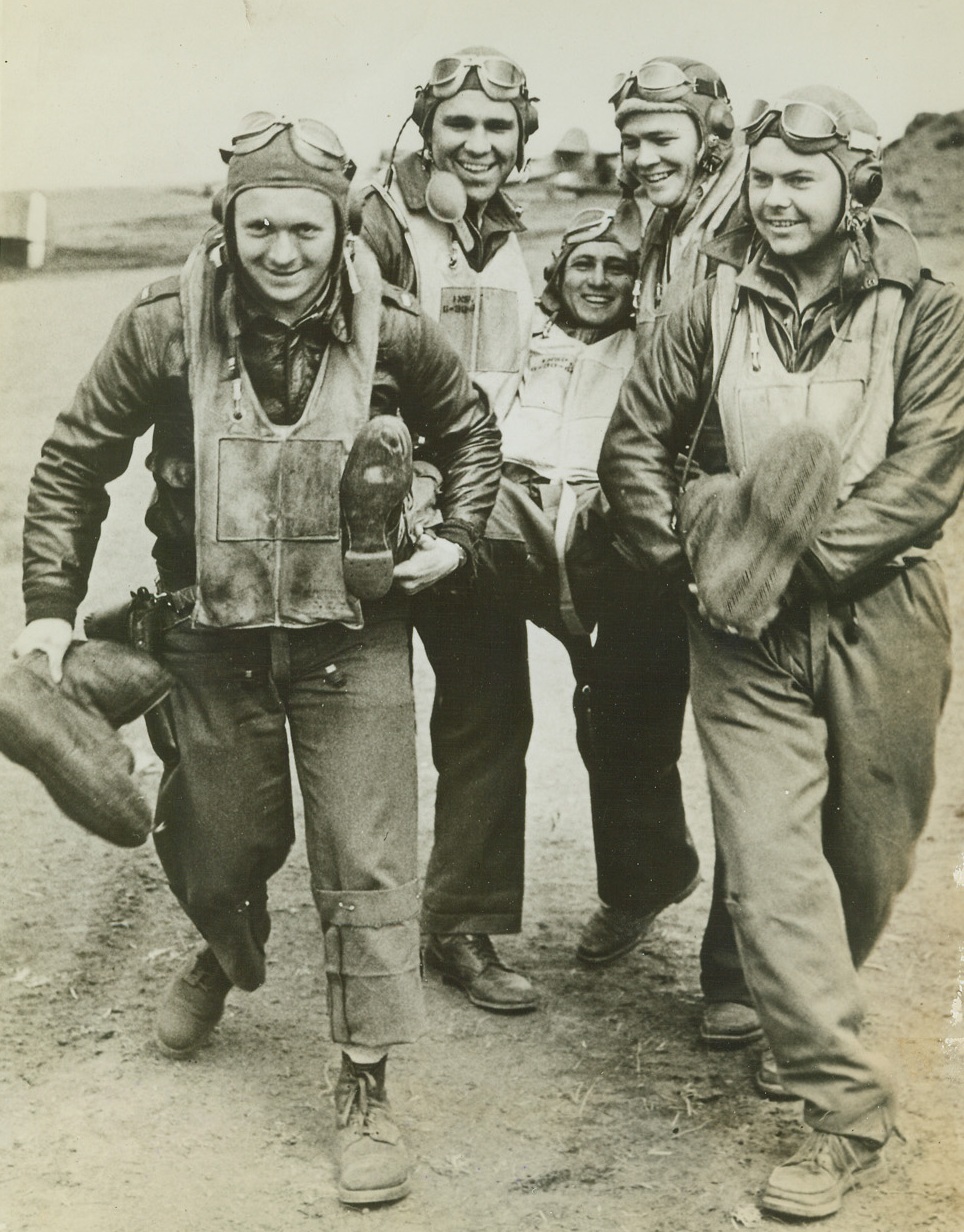
Flying Tigers in Alaska, 9/15/1942. Kiska, Alaska—A squadron of “Flying Tigers” has been formed in Alaska under the command of Major John Chennault, son of General Chennault, leader of the famed “Flying Tigers” in China. Here, members of Major Chennault’s “Flying Tigers” gave one of their buddies a boisterous accolade for shooting down a Jap dive bomber—maybe he shoulda stood in his plane. Left to right: Lt. H.B. Barnard; Lt. M.J. Buku; Lt. W.E. Brinkeman; Lt. R. Dale; and Lt. M.S. Fetz.Credit: Army Signalcorps photo from ACME.;
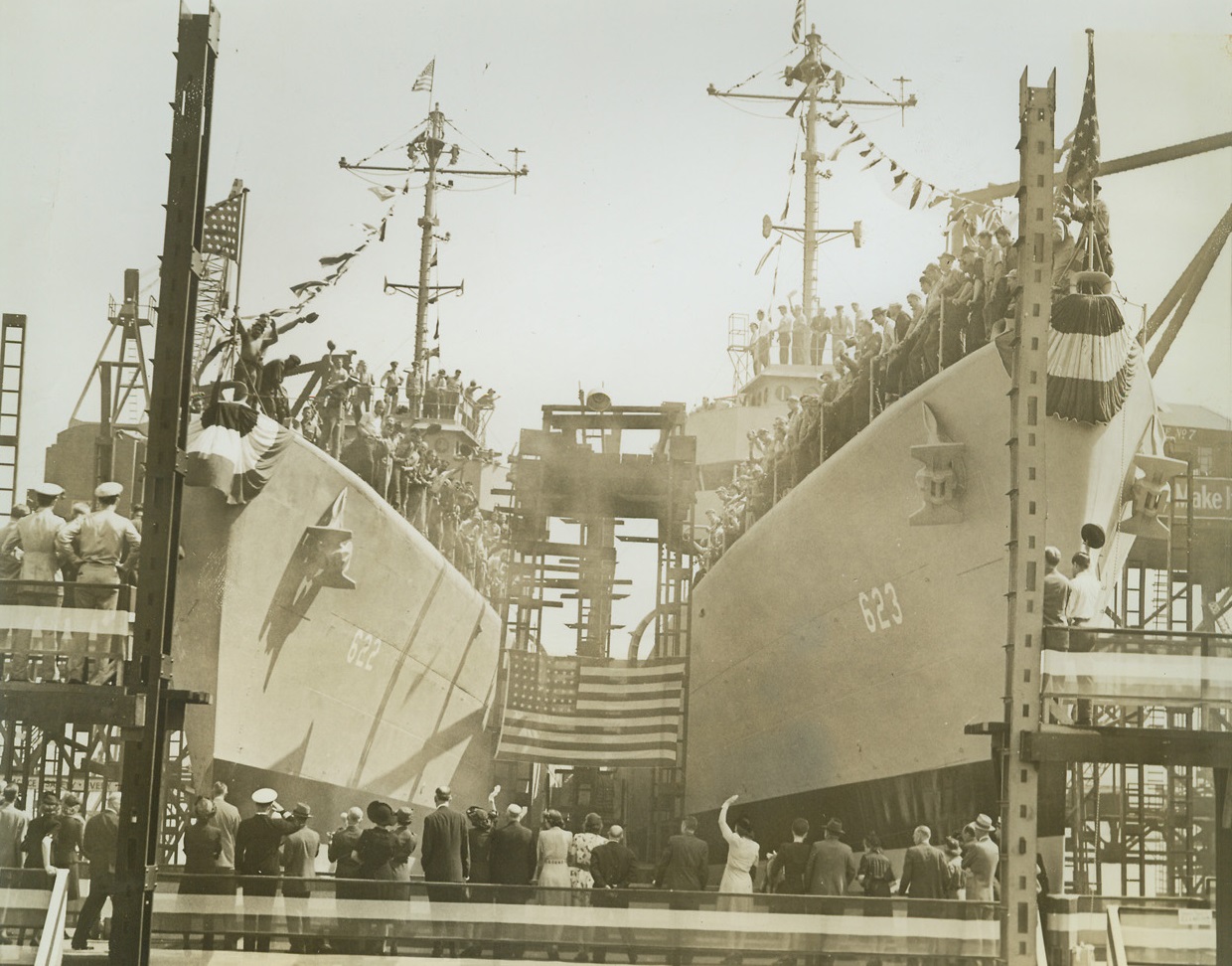
Two Destroyers Launched at Kearny, 9/15/1942. Kearny, N.J. – The U.S.S. Maddox, named in honor of the late Capt. William A. T. Maddox of the Marine Corps, slides down the ways at the Federal Shipbuilding and Dry Dock Company Yards Sept. 15. The U.S.S. Nelson, which was launched a few minutes later, can be seen on the right. Credit: ACME;
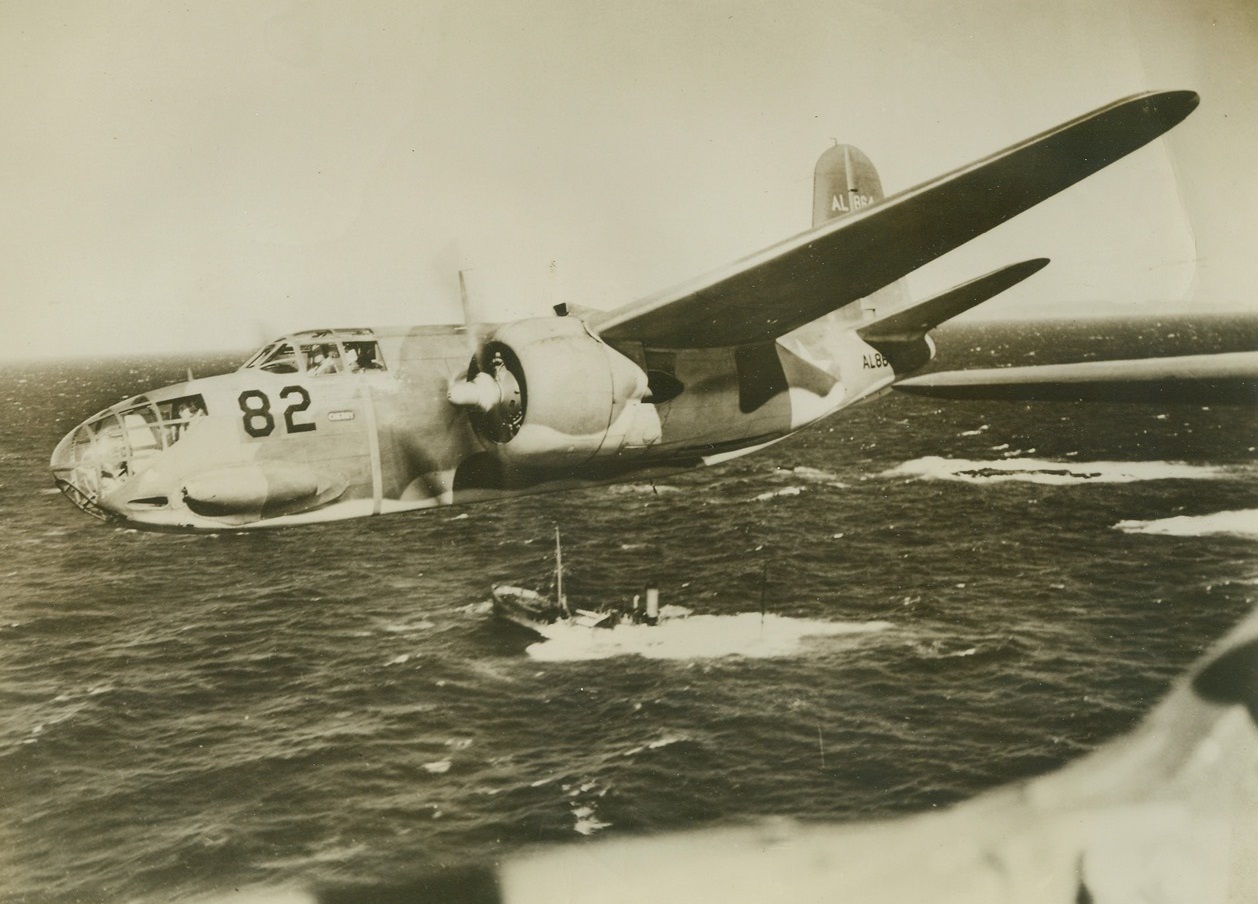
Hawk-Eyed Rescue, 9/18/1942. Washington – The battered hulk of a merchantman, rapidly breaking up on an Atlantic coastal reef, brings a Douglas A20 Bomber zooming down in a 452 mph dive. Lieut. C. T. Baumgarner, U.S.A., of North Carolina, pilots the light fighter bomber over the rocky North Atlantic coast, and leads a sweep of similar planes, on the look-out for submarine damage. Passed by Censor Credit: ACME;
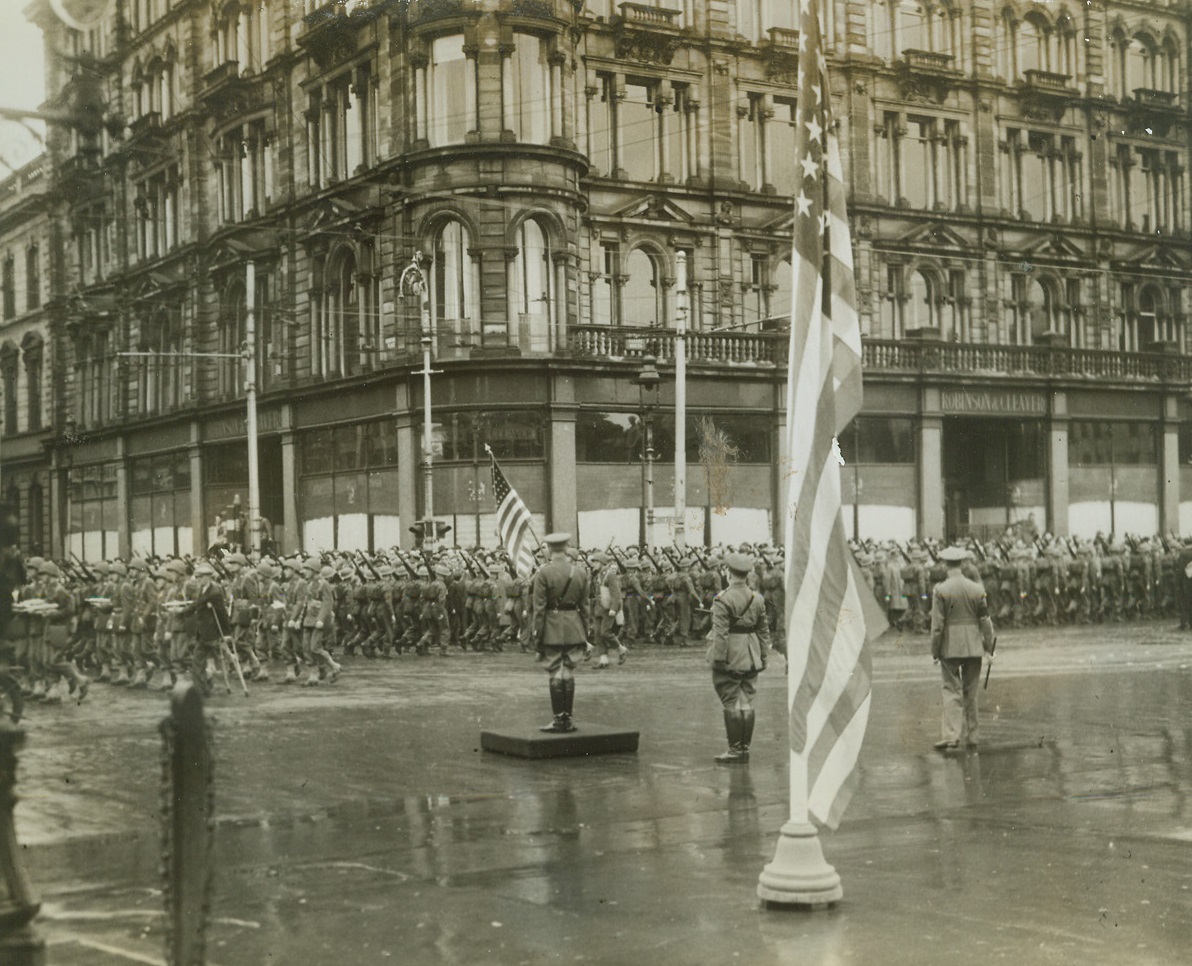
“Tanks For Attack” Parade In Belfast, 9/18/1942. Northern Ireland – American troops pass the saluting base during the “Tanks for Attack” Campaign Parade in Belfast, which was organized by the Belfast War Savings Council so that Belfast savers could have the name of their city on 25 heavy tanks to be built from proceeds of the campaign. British troops took part in the opening parade together with American troops stationed in Northern Ireland. (Passed by Censor) Credit: ACME;
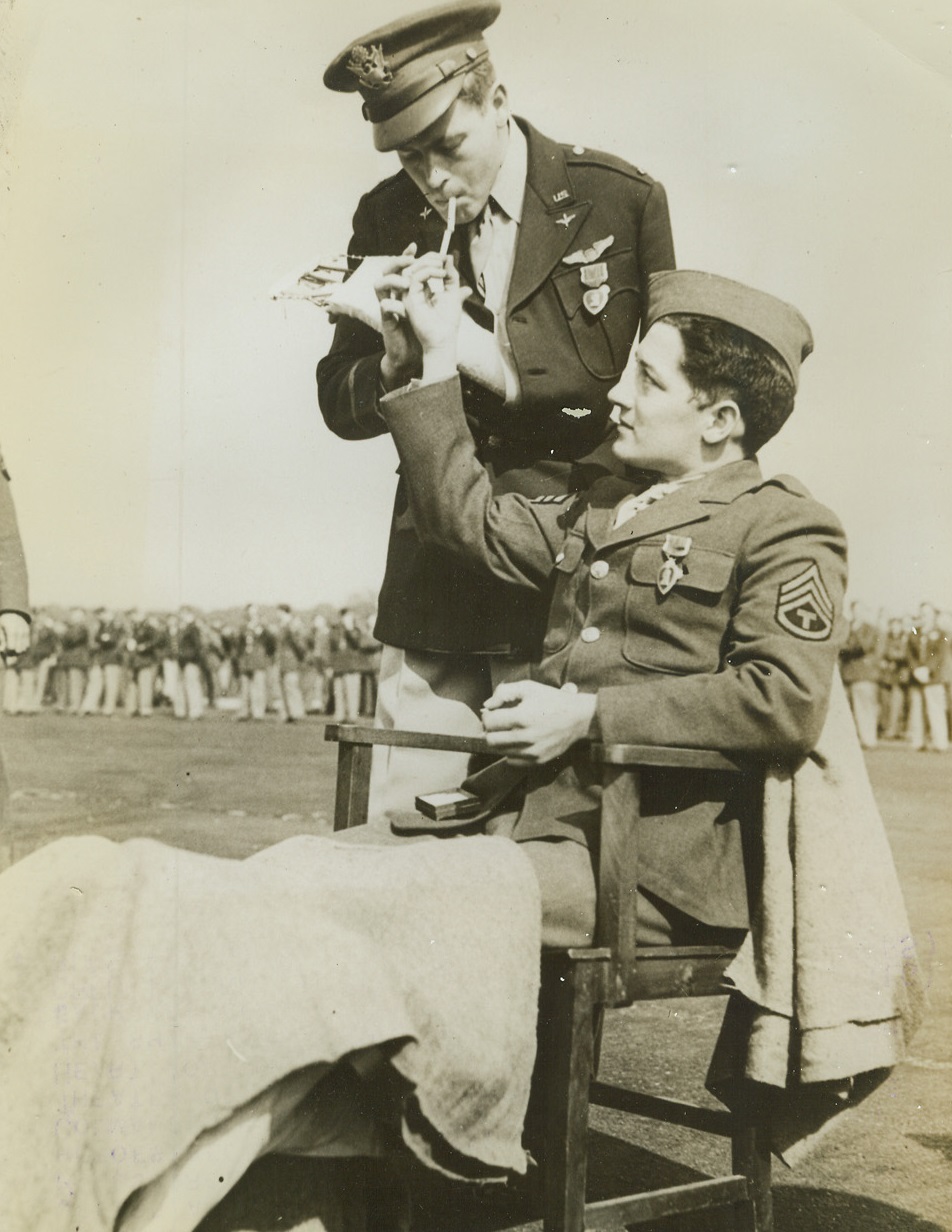
Heroes Both, 9/17/1942. England – Sgt. Frederick J. Rich, of Erie, PA; offers a light to Lt. Eugene M. Lockhart, of Hillsboro, S.C., after ceremonies at which both heroes received from Maj. Gen. Carl Spaatz, Commander of U.S. Army Air Forces in European Theater of Operations, the Order of the Purple Heart for their part in a daylight attack on the shipyards at Le Trait, France during which each was wounded. (Passed by Censors) Credit: ACME;
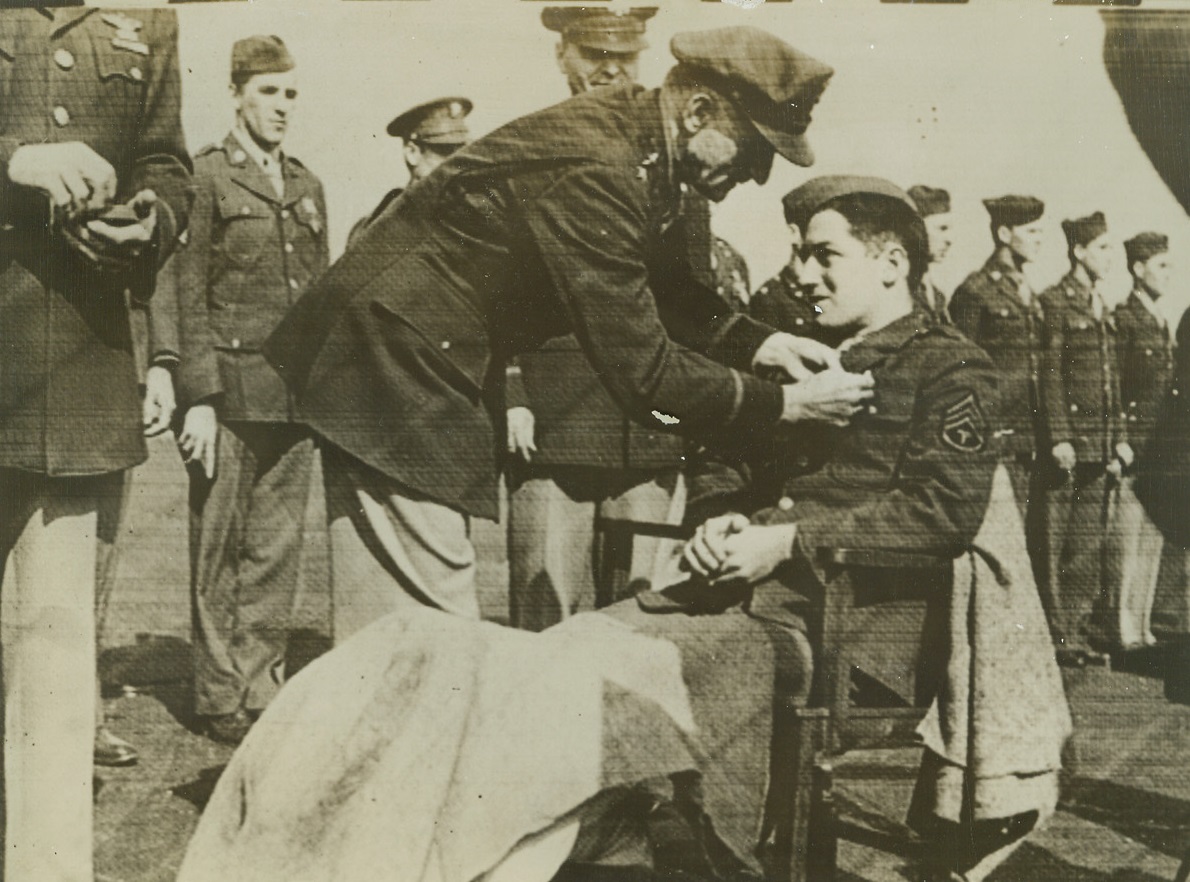
Gen. Spaatz Decorated Wounded Airman, 9/17/1942. England – Maj. Gen. Carl M. Spaatz, Chief of the U.S. Army Air Force in Europe, pins the Purple Heart on Sgt. Frederick J. Rich of Erie, PA at an Air Field somewhere in England in recognition of his “extraordinary valor” in action against the enemy over Europe. Sergeant Rich was wounded while taking part in a daylight bombing of shipyards in Le Trait, France by U.S. Flying Fortresses. Photo was cabled to New York from London today. Credit: ACME Cablephoto;
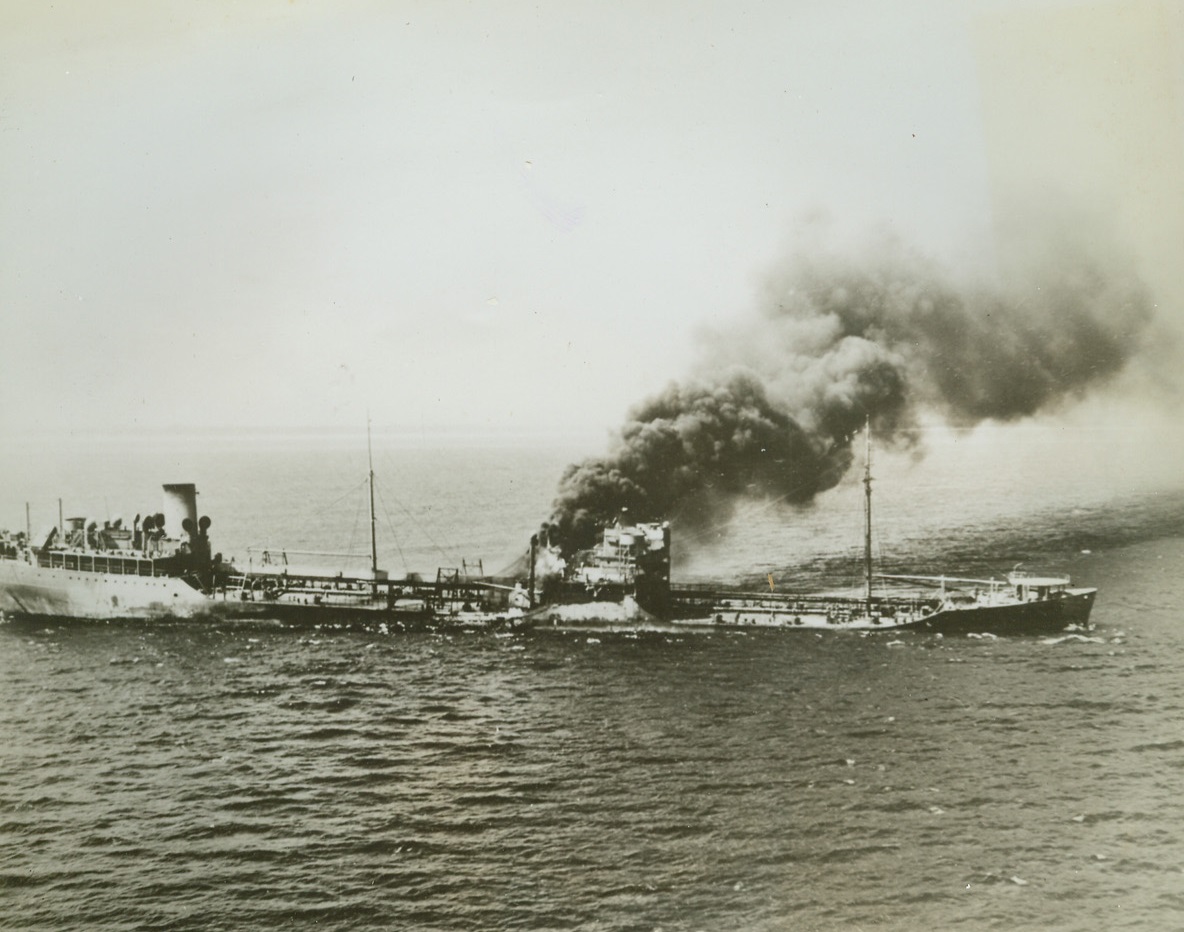
Torpedoed In Battle of Atlantic, 9/29/1942. Billowing black smoke issuing from the amidships on the port side of a Tanker show where an Axis torpedo stuck the vessel in the still-continuing Battle of the Atlantic. Despite the blow the tanker was salvaged. Photo was just released by the U.S. Navy Credit: Official U.S. Navy photo from ACME;
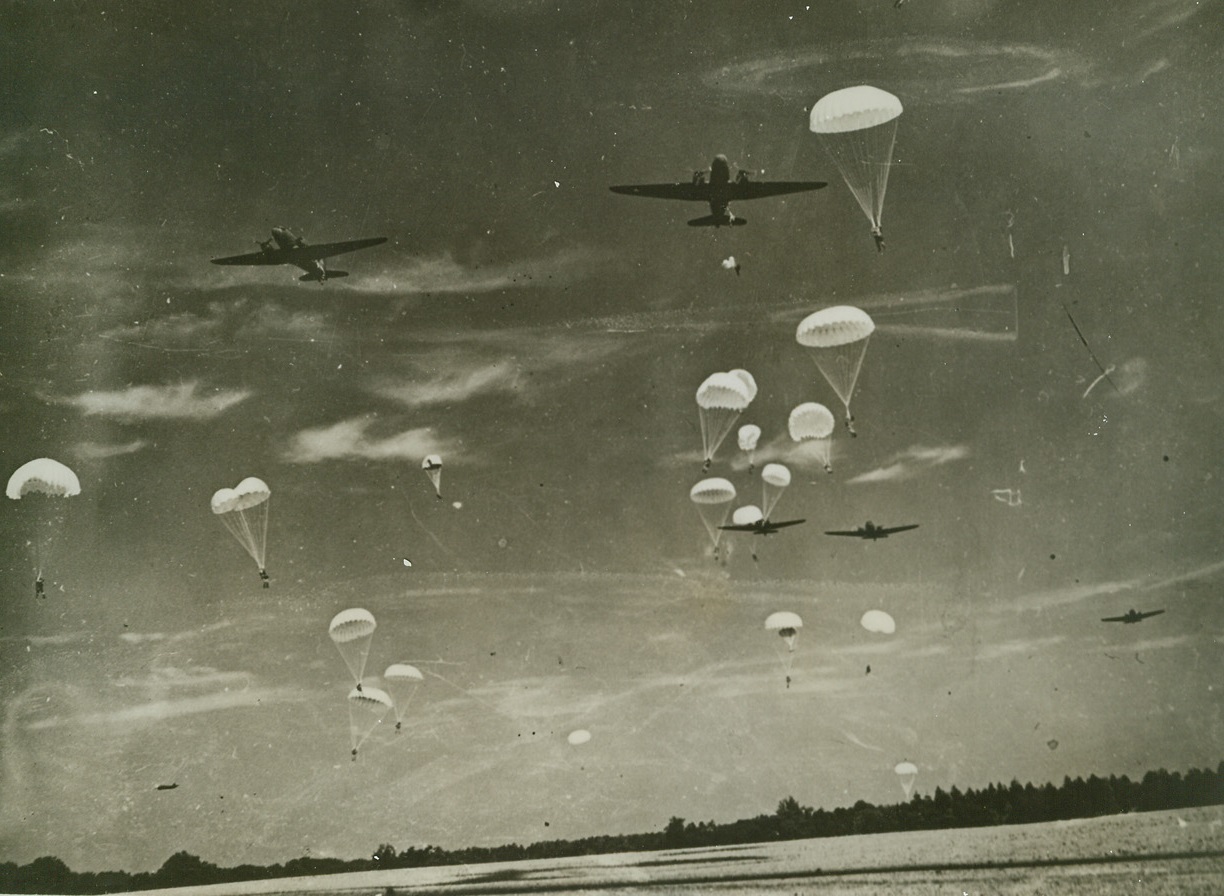
American Confetti, 9/27/1942. Somewhere in England – A ground level camera shot shows the low altitude dared on operational jumps, as American paratroops, whose presence has just been announced in England, practice invasion tactics. This is one of the first photos to show American paratroops in action. Drawn mostly from the southern states, the sky commandos are commanded by Lieut. Edson D. Raff, New York City. Passed by censor. Credit: ACME;
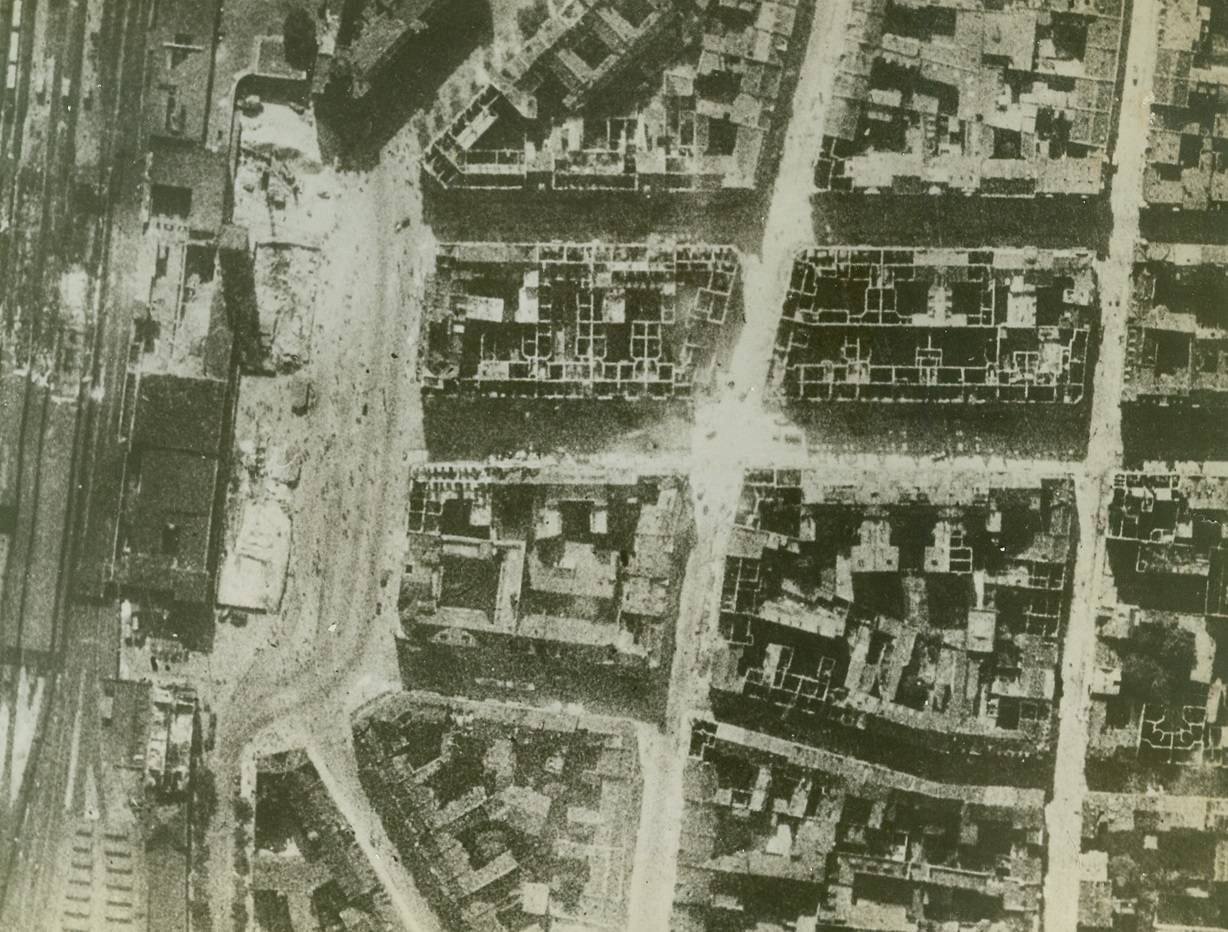
R.A.F. Bombs Blast Dusseldorf, 9/27/1942. England—A hundred yard diameter hole marks damage done to the Dusseldorf main railway station, where the main track and sheds were also blasted by R.A.F. bombs, the night of Sept. 10. Few roofs are left on buildings west of the station. The day following the night raid, thick smoke from still-burning fires made a damage estimate impossible. When the smoke cleared, this R.A.F. reconnaissance photo showed that British aim was accurate. Passed by censor. Credit: ACME.;
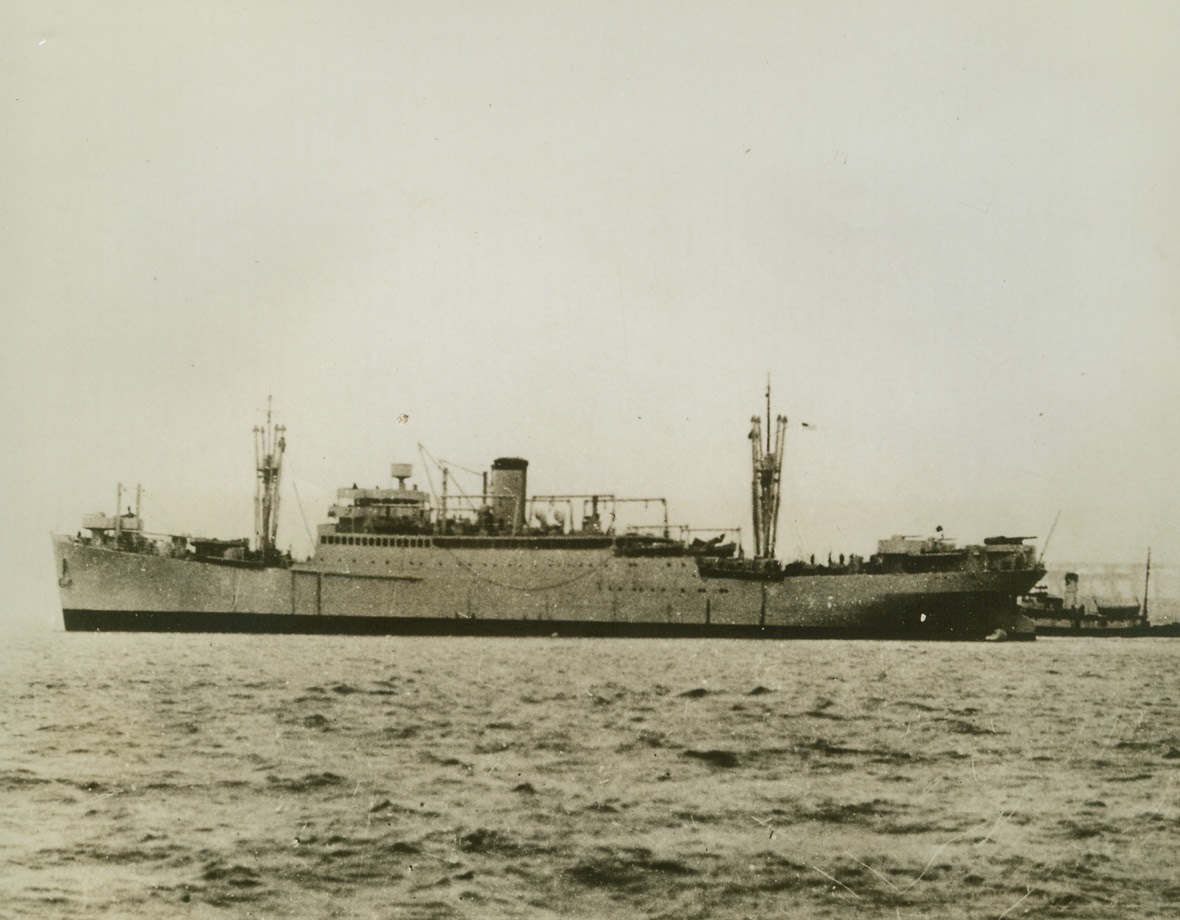
Sunk Off Solomon Islands, 9/30/1942. Washington, D.C.—The U.S. Navy transport George Fox Elliott, formerly the 8,378-ton liner city of Los Angeles, which has been lost in the Solomon Islands operations, according to an announcement by the Navy department in Washington, Sept. 30. It was also announced that the auxiliary transport Gregory, a converted 1,060-ton flush-desk destroyer, was lost in the same operations. Credit: U.S. Navy photo from ACME.;
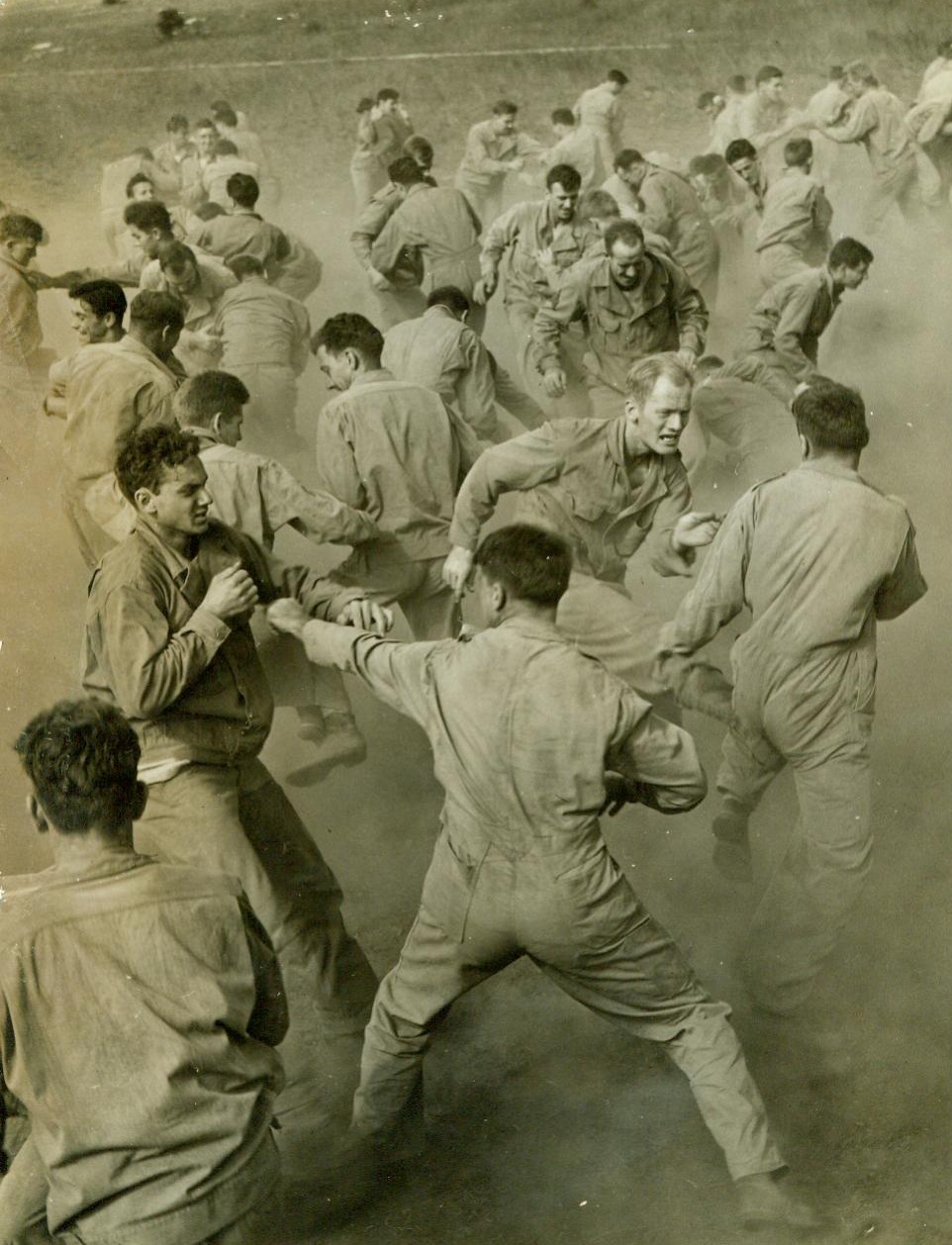
Potential rangers undergo training, 9/25/1942. FORT GEORGE G. MEADE, MD. – Kicking up the dust trainees under the instruction of Major Franco O’Eliscu are undergoing rigorous workouts in preparation for ranger attacks against our enemy. Here the group engages in hand to hand combat. CREDIT LINE (ACME) 9/25/42;
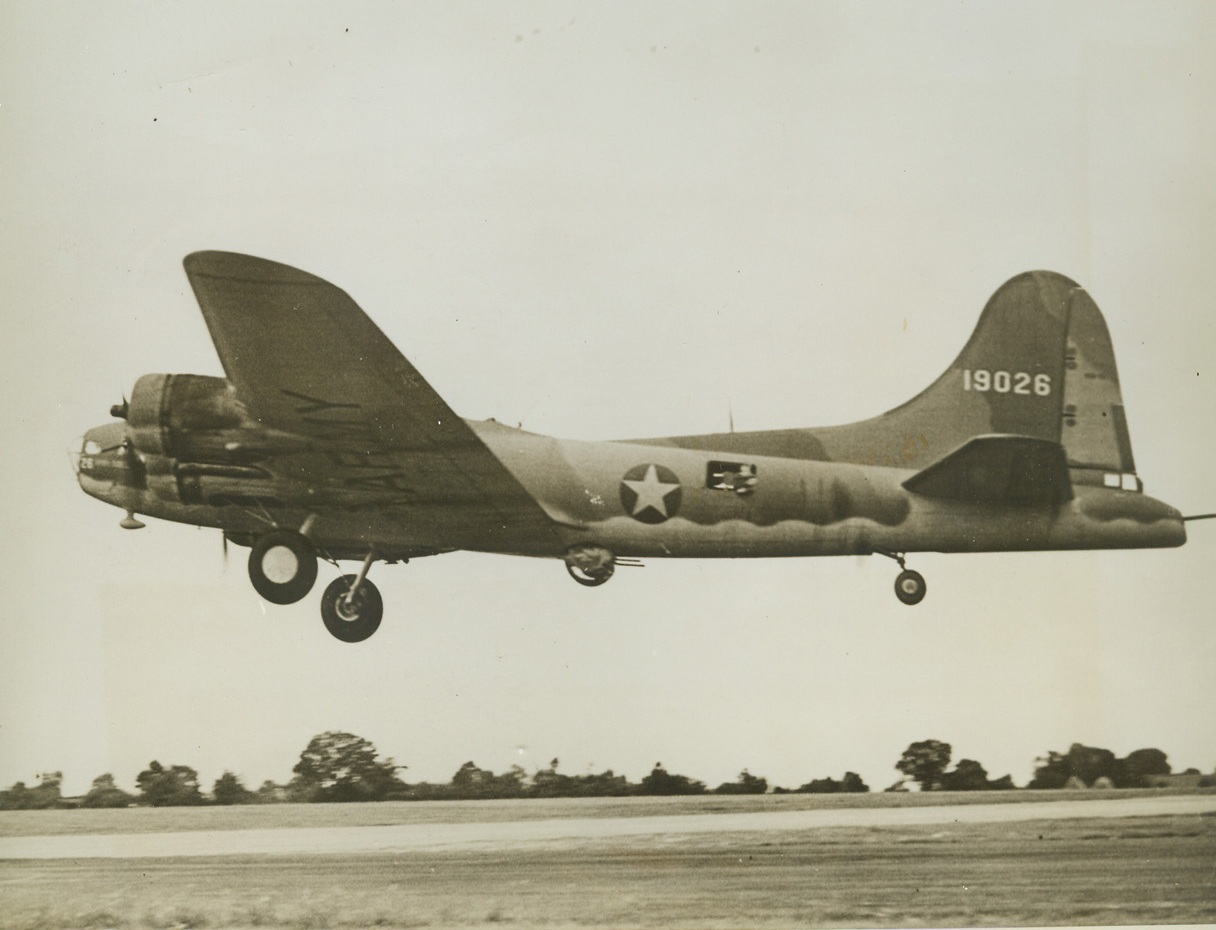
MIGHT ON THE WING, 9/11/1942. ENGLAND—Bristling with guns and mottled with camouflage, a U.S. “Flying Fortress” heavy bomber roars aloft in a take-off from an American Bomber Training Station “somewhere in England.” Credit Line (ACME);
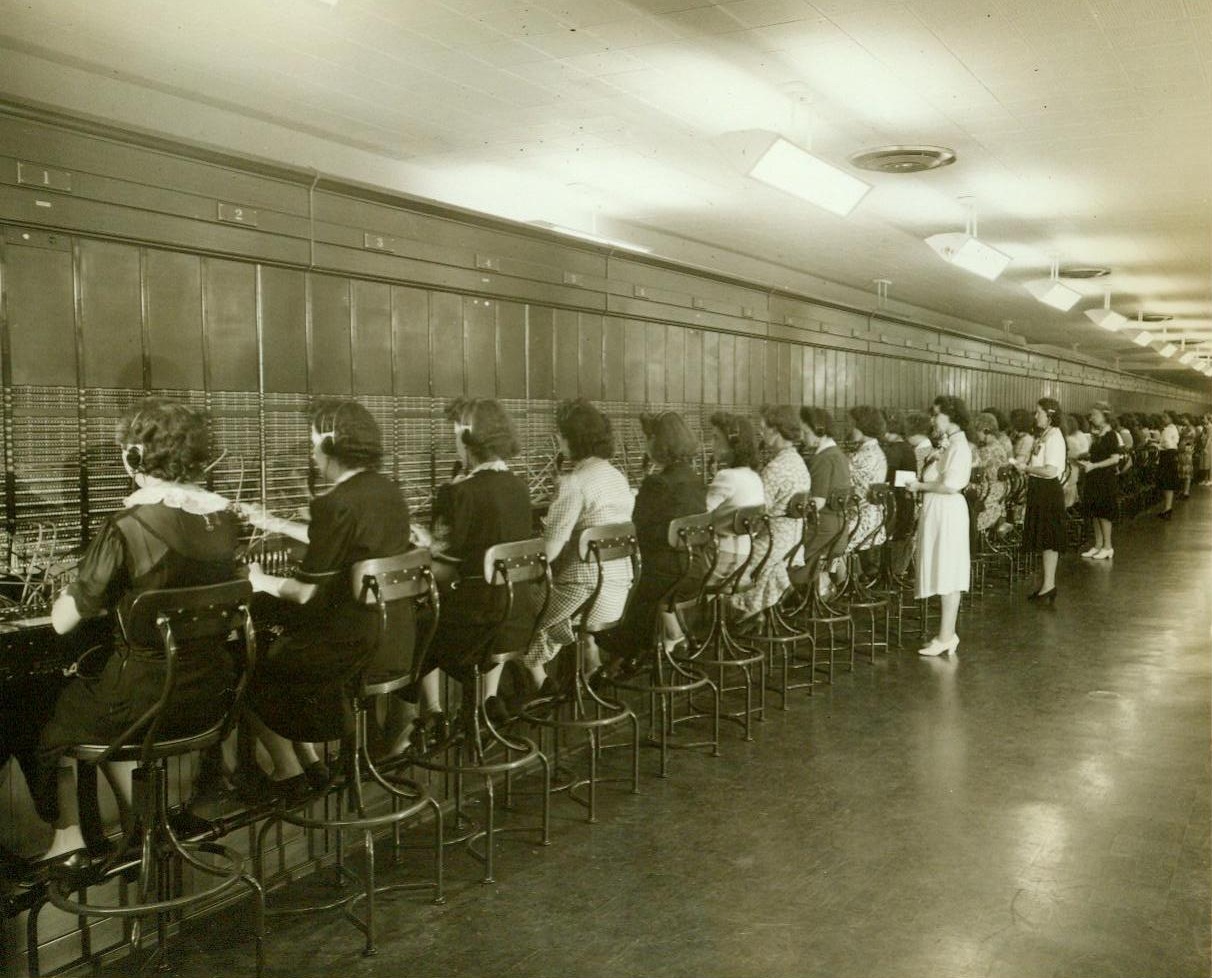
Phones of War at Work, 9/15/1942. Arlington, VA.—View of a section of the switch-board at the telephone exchange in the War Department’s new office building here, just across the Potomac from Washington. In this building and others it occupies in the District of Columbia, the War Department has four times the telephone facilities it used in the First World War—An exchange large enough to serve a city the size of Erie, PA. 9/15/42 (ACME);
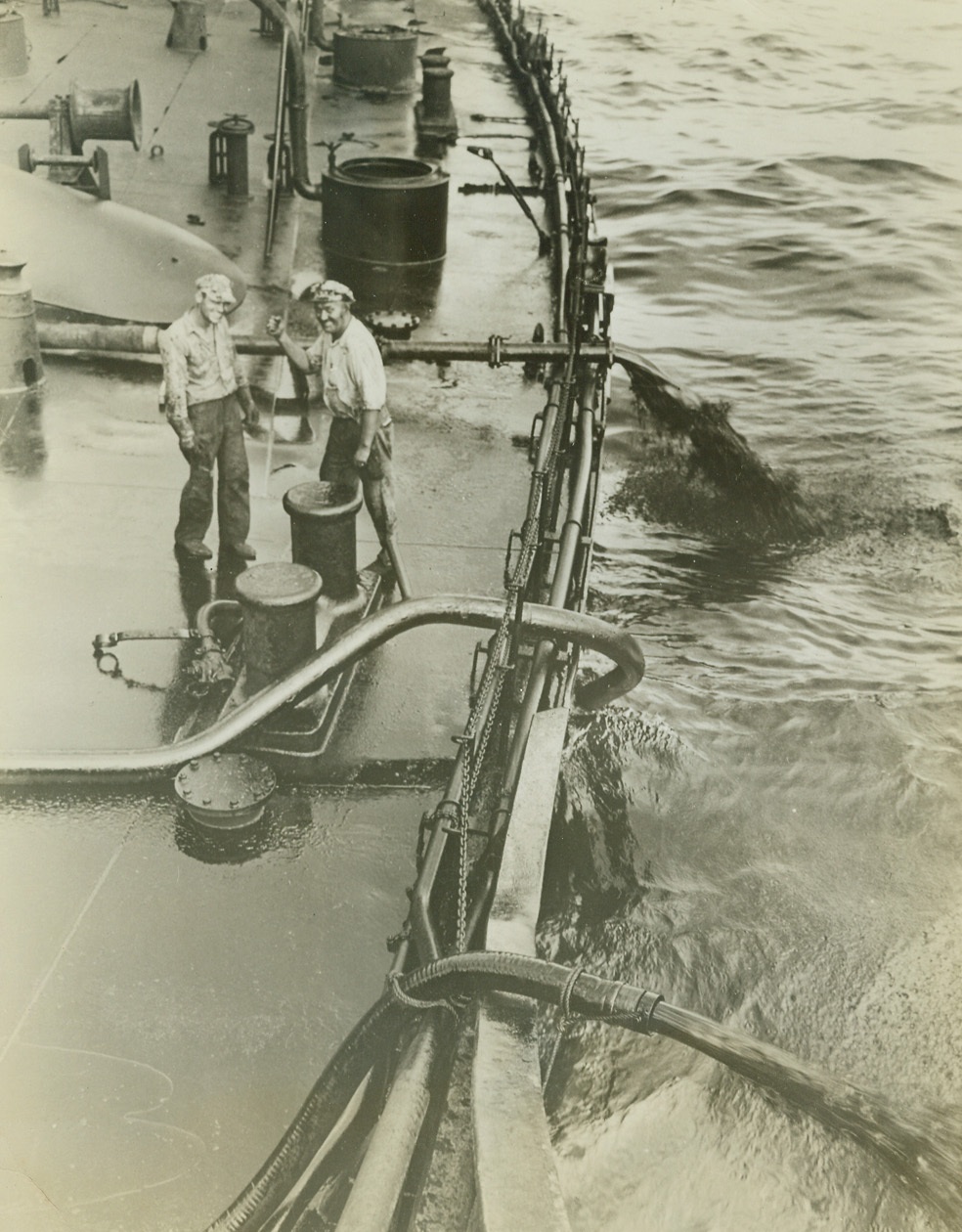
Saga of the Atlantic, 9/28/1942. Somewhere in the Atlantic – After being torpedoed by an Axis submarine, seamen, in order to keep the ship on even keel after the fire, pump oil out of the ship to spread itself in the vast expanse of the ocean. Note the clenched fist of the seaman on the right—another indication that the American Merchant Sailors are determined to carry on. Credit: Official U.S. Navy photo from ACME For release in A.M. of September 30, 1942;
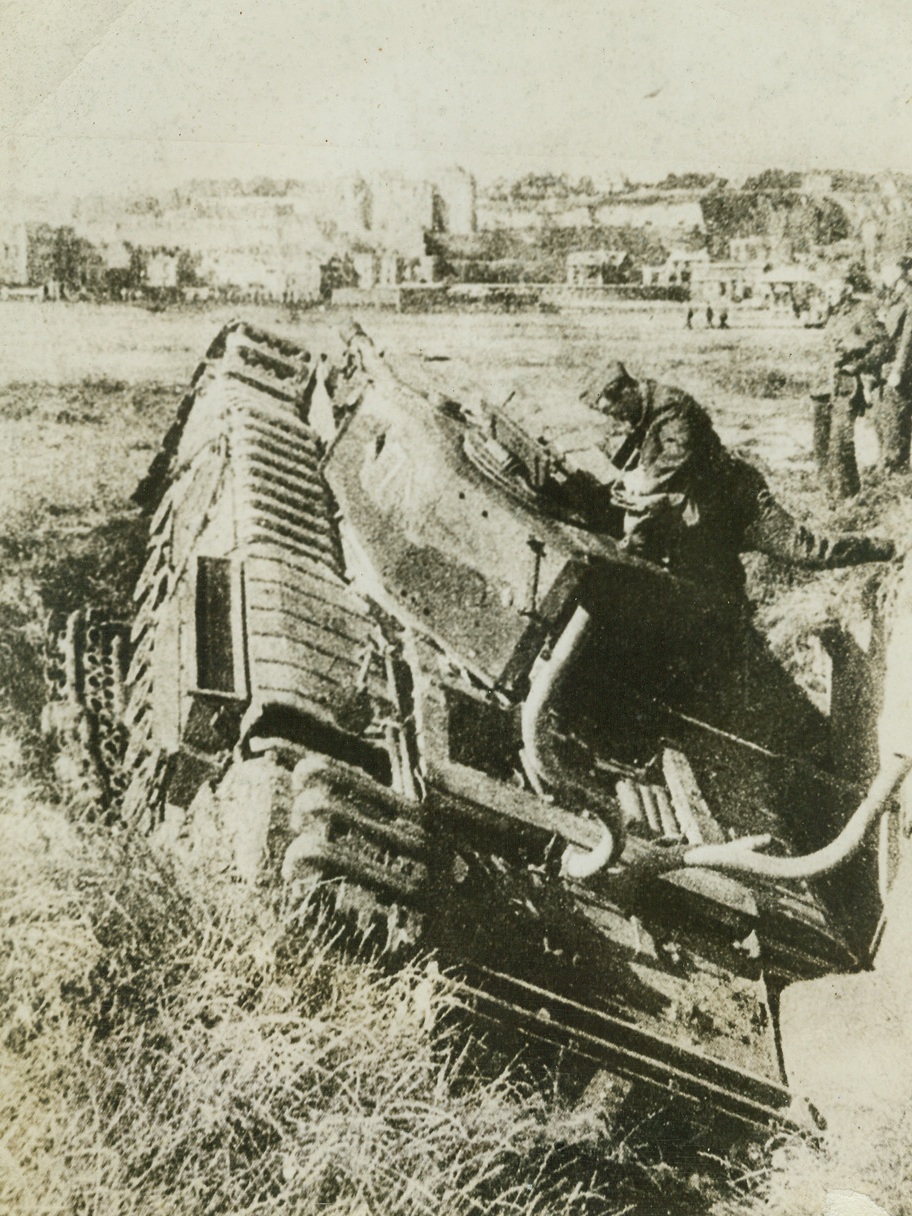
Tank Left at Dieppe Say Germans, 9/10/1942. Dieppe, France – According to the original caption on this photo, which was received in London from enemy sources, Nazi soldiers are examining a ditched Allied tank, which was damaged and left behind by Commandos during the Dieppe raid. Photo has just arrived in New York by Clipper. Credit: ACME;
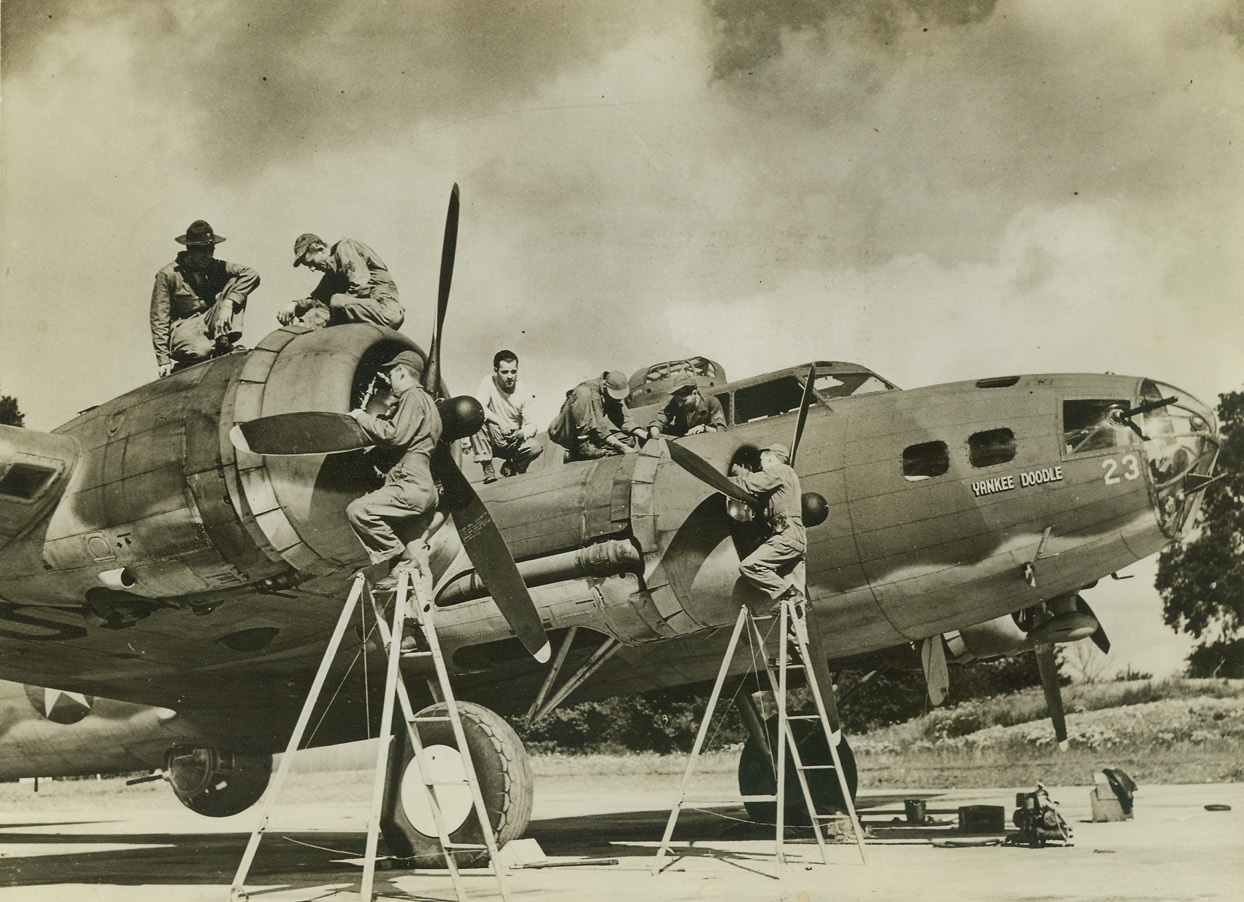
Skilled Technicians On The Ground, 9/11/1942. England – Skilled technicians of the ground crew at a U.S. Bomber Training Station “somewhere in England” service a deadly Flying Fortress heavy bomber of the U.S. Army Air Forces. Passed by censors. Credit: ACME;
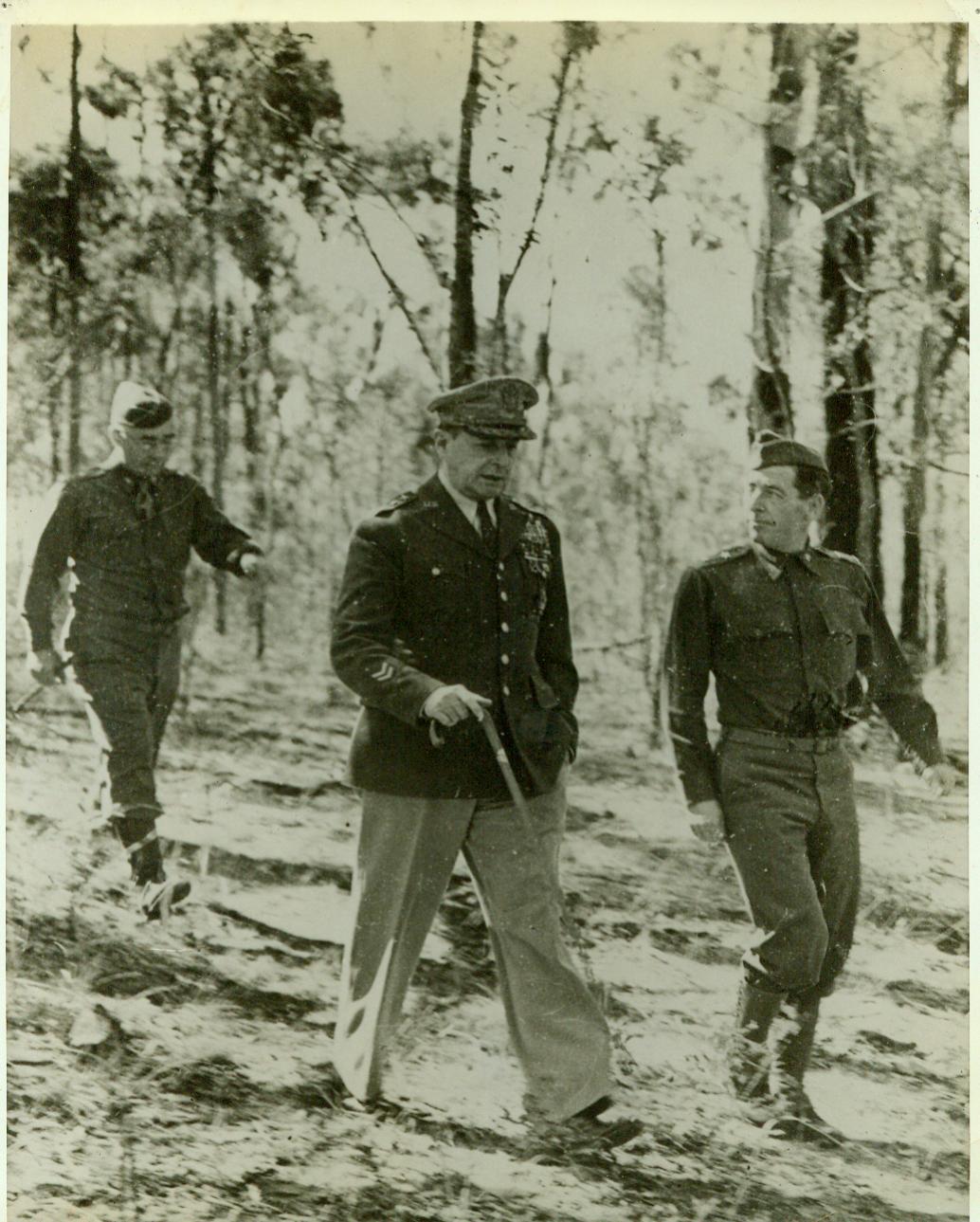
MacArthur Goes on Inspection Trip, 9/6/1942. General Douglas MacArthur (center) walks with officers of an American Division during an inspection trip “somewhere in Australia”. 9/6/42 (ACME;
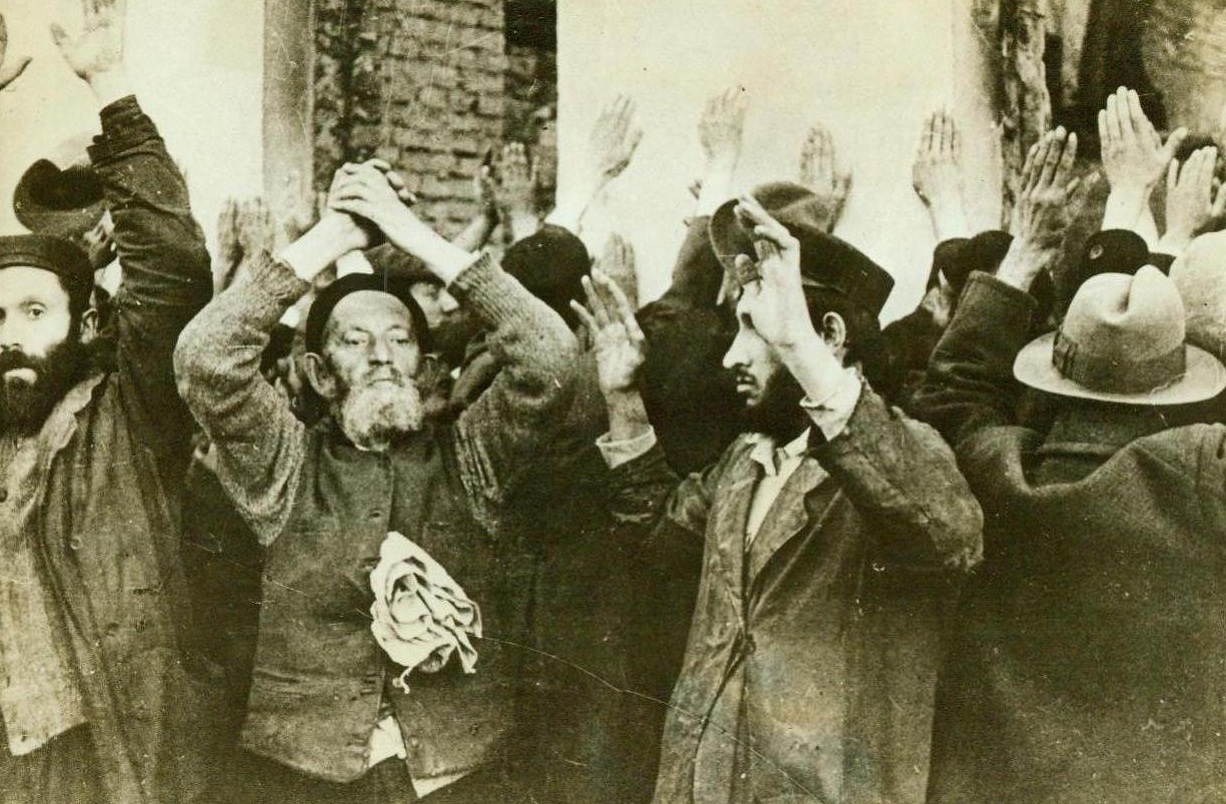
Jews Rounded Up In Warsaw, 9/10/1942. Warsaw, Poland -- Under the threat of Nazi guns, these defenseless Jews hold their hands high and line up against a wall, during a round-up in Warsaw's Ghetto. Out of Nazi-occupied Poland have come horrible tales of torture and separation of family units suffered by the Jews at the hands of the hated Gestapo. Photo was found on the body of a German officer, evidently a participant in this round-up, who was killed before Moscow 9/10/42 (ACME);
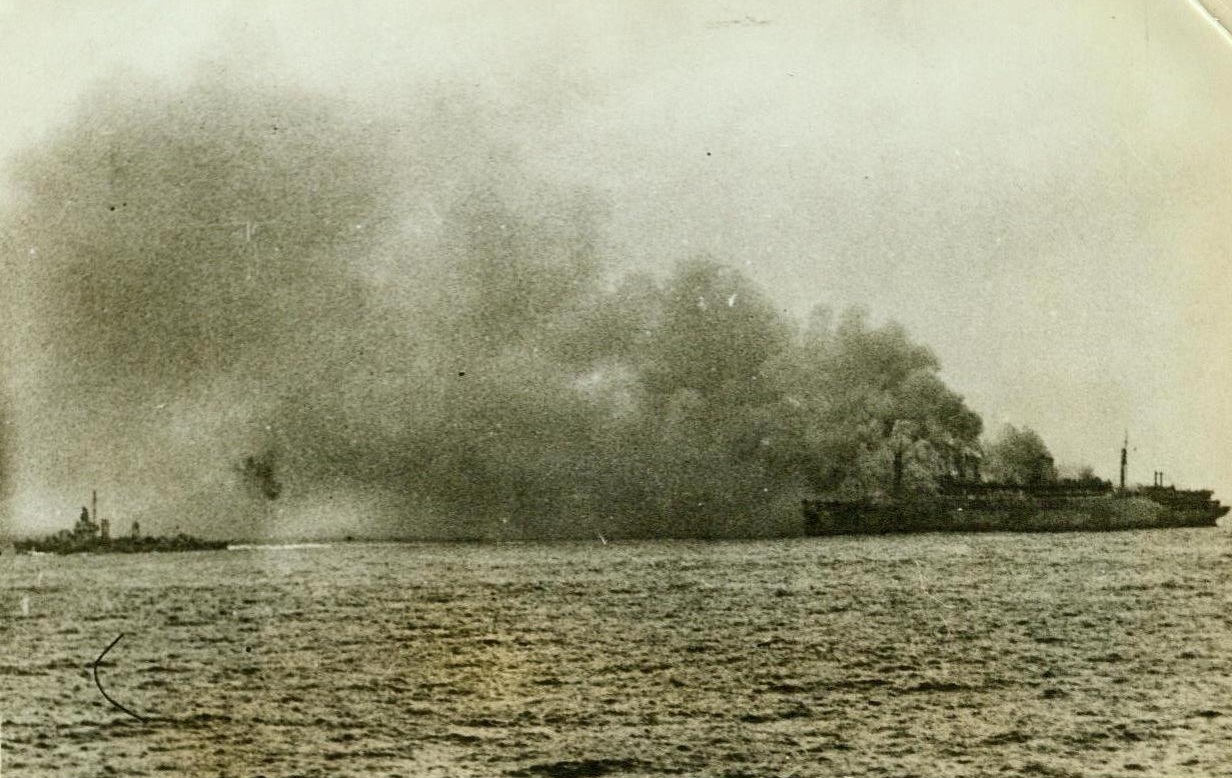
U.S. Transport Wakefield Afire At Sea, 9/9/1942. Washington, D.C. -- Smoke is blown to the Lee side of the U.S. Transport Wakefield as fire swept the vessel, Sept. 3, while it was returning to its home port with a convoy. At left is a destroyer, one of many ships that participated in the rescue of some 1600 passengers and crew members. The Wakefield, formerly the luxury liner S.S. Manhattan, has been salvaged and is now in an Atlantic port. 9/9/42 (ACME);
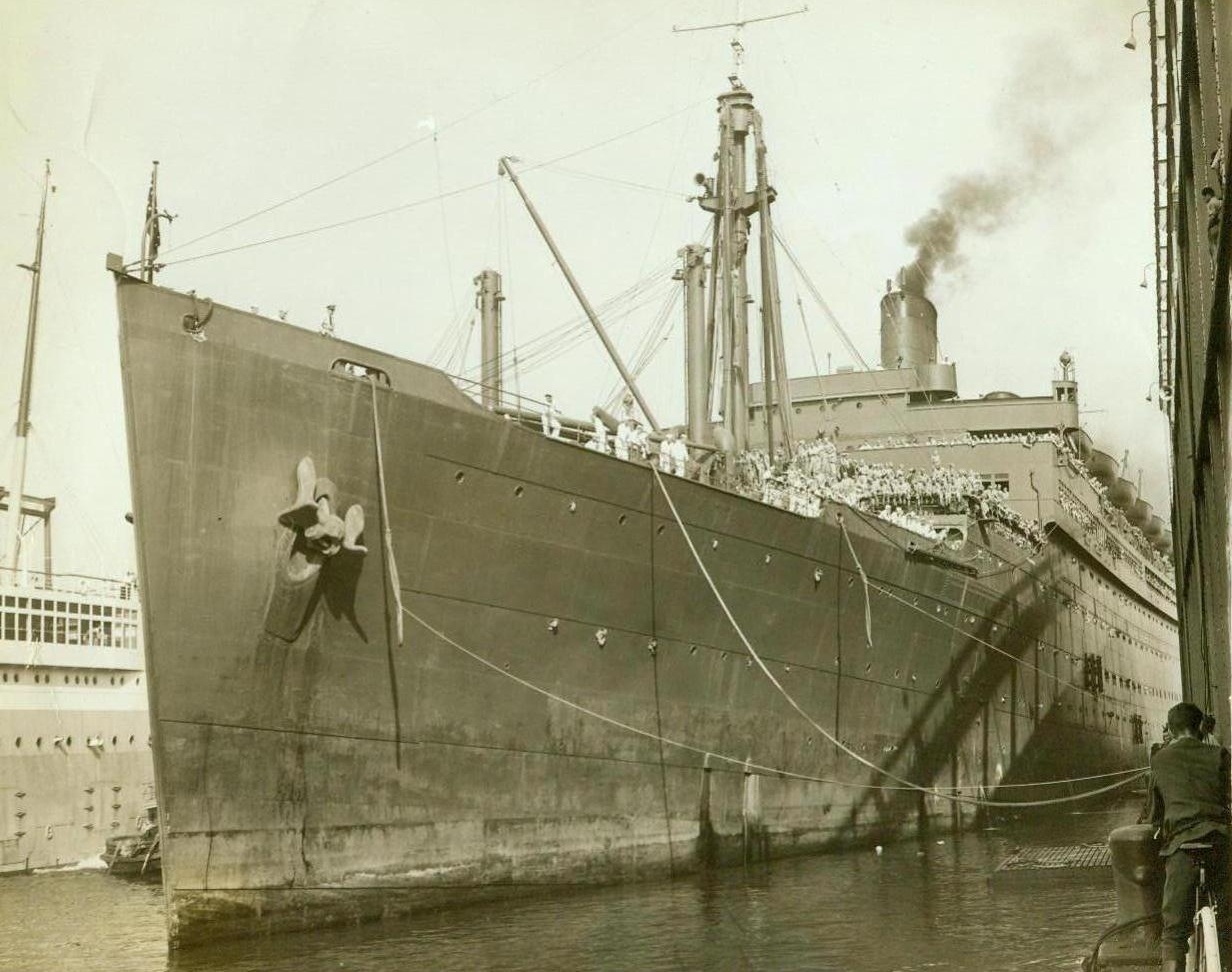
Burned At Sea, 9/9/1942. Washington, D.C. -- Abandoned on the Atlantic, after approximately 1,600 crew members and passengers were rescued, the 24,289 ton Naval Transport Wakefield, has now been salvaged and towed to an east coast port. Flames enveloped the vessel shortly after a fire of undetermined origin broke out on one of the deck levels, Sept 3. Photo shows Wakefield, in battleship gray, preparing to leave an eastern port with her load of troops;
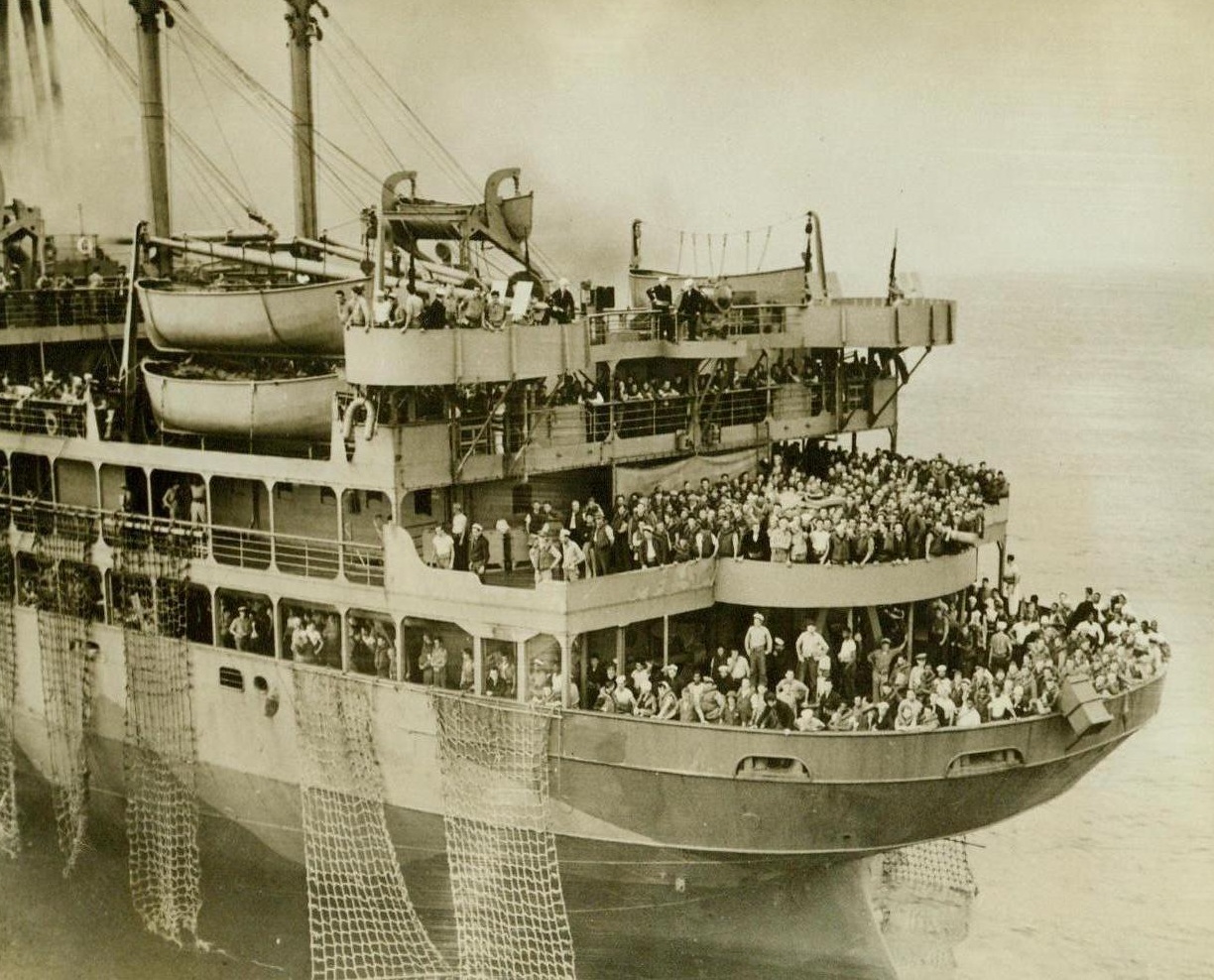
Rescue Of Wakefield Passengers, 9/9/1942. Washington, D.C. -- There is no trace of panic among these courageous passengers and crew members on the burning U.S. Transport Wakefield as they quietly wait on the stern decks of the ill-fated ship for rescue aboard the cruiser from which this photo was taken. Note rope ladders that have been let down over the sides. Orderly conduct of the survivors permitted the rescue of some 1600 persons. Though fire swept completely through the former luxury liner S.S. Manhattan the evening of Sept. 3, the vessel is reported to have been salvaged and is now safe in an Atlantic port. 9/9/42 (ACME);
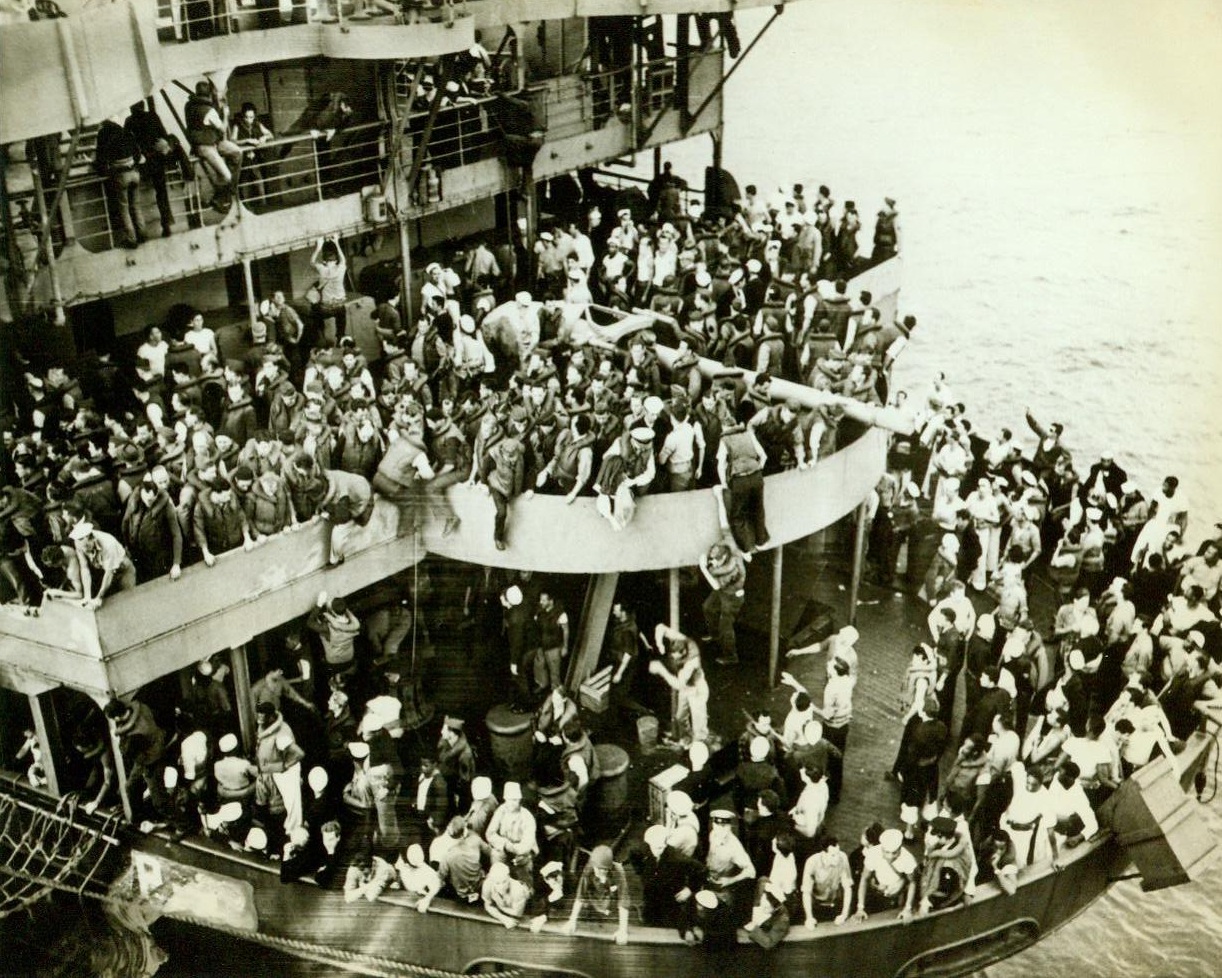
Passengers On Wakefield Awaiting Rescue, 9/9/1942. Washington, D.C. -- Passengers and crewmen wait calmly on the stern decks of the burning U.S. Transport Wakefield-- Formerly the luxury liner S.S. Manhattan -- As the cruiser from which this photo was taken nears to take them off. Warships that came to the rescue of passengers on The Wakefield, on which fire broke out Sept 3, saved approximately 1600 persons. The vessel has been salvaged and is now in an Atlantic port. 9/9/42 (ACME);
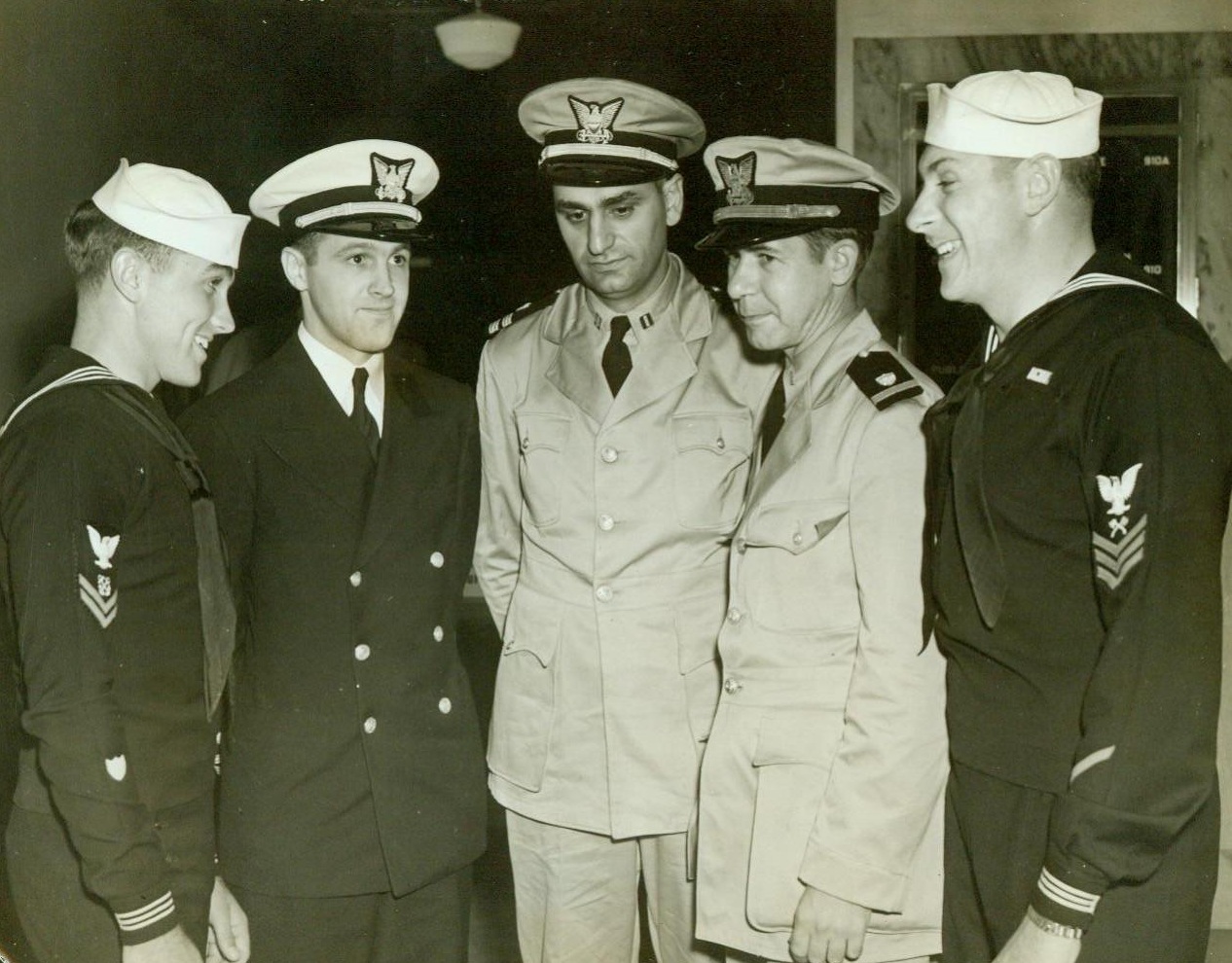
Saved From Burning Naval Transport, 9/9/1942. East Coast Port: -- These Coast Guardsmen were among the approximately 1,600 passengers and crew members aboard the 24,209-ton Naval Transport Wakefield, formerly the liner Manhattan, who were rescued when the vessel caught fire at sea the evening of Sept. 3. The ship has now been salvaged and towed to an American Atlantic port. Left to right: Boatswain's Mate (2nd Class) D.R. Fraser, of Buffalo, N.Y.; Lieut. H.P. Kniskern, Jr., New York City; Lieut. J. Mazzotta, Senior Deck Officer, of Cape May, N.J.; Ensign J.A. Mahrley, St. Paul, Minn., And Carpenter's Mate (1st Class) C. A. Buchert, Glenside, Pa. 9/9/42 (ACME);
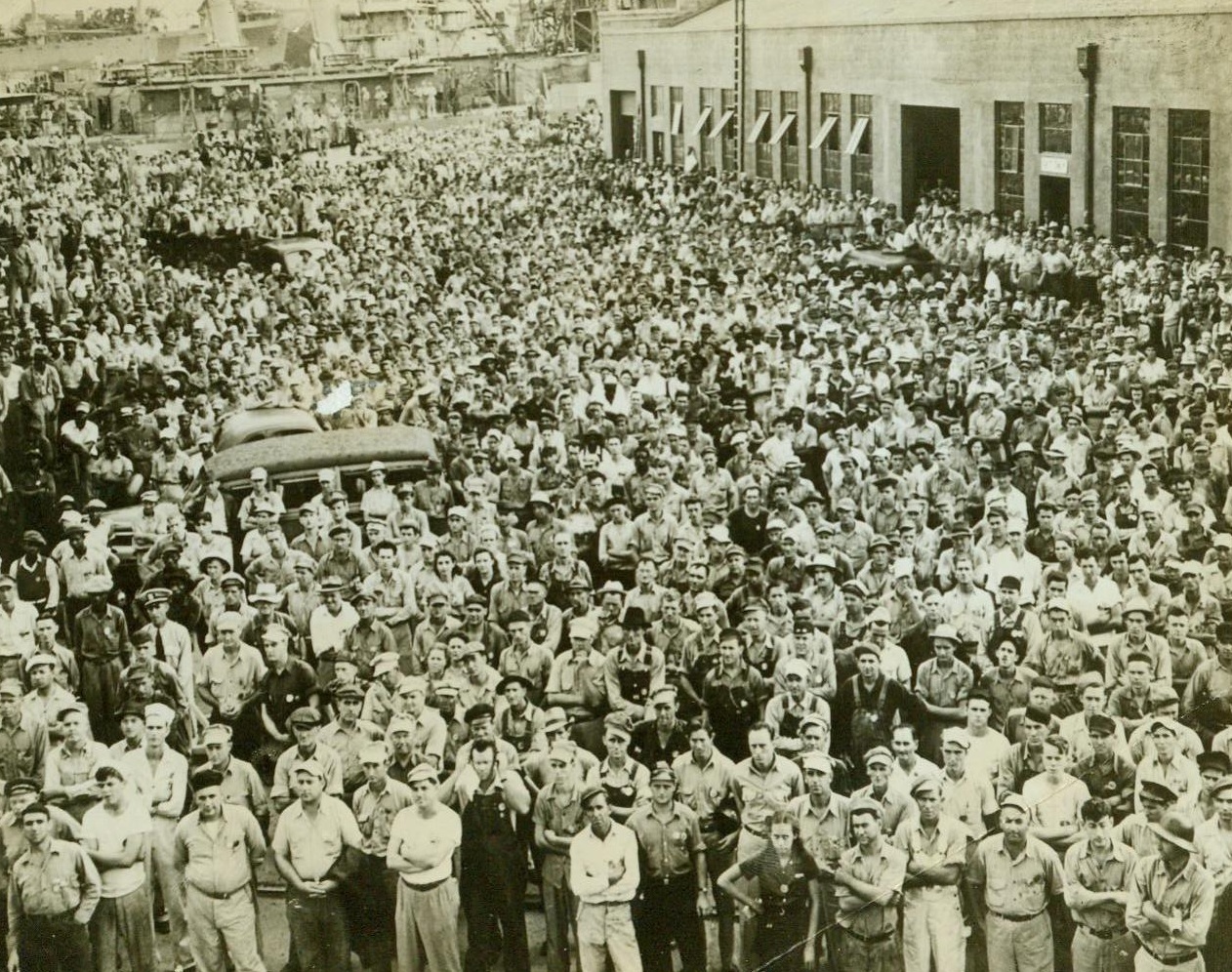
Charleston Navy Yard Workers' Labor Day Meeting, 9/8/1942. Charleston, S.C. -- Here's part of the large crowd of workers which attended the Labor Day celebration at the Charleston Navy Yard -- After day's work was over. Celebration included the laying of two keels for landing ships. Workers at the yard pledged to build more ships, better ships, and buy more bonds to finance ships. 9/8/42 (ACME);
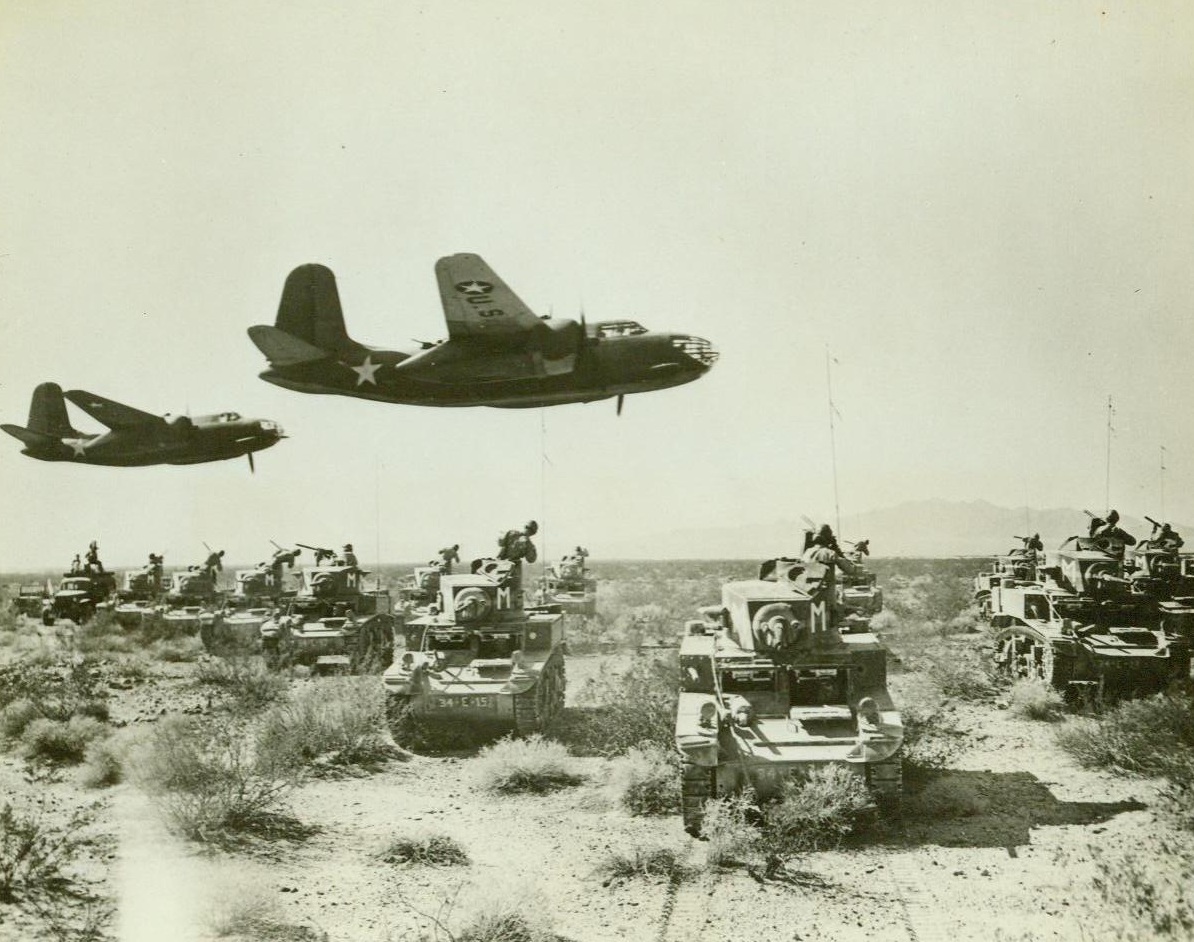
Grim Rehearsal In The Desert, 9/24/1942. Far out on the Badlands of California’s deserts, Air and Armored Forces of the U.S. Army are engaged in grim rehearsal for the day when they will meet the battle-wise and merciless forces of the Axis Powers. Soldiers are learning tough living, and tough fighting tactics. Here, light tanks of the armored forces have met with attack bombers of the ground-air support command, which represent the “enemy”. Every machine gun on the tanks is bearing on the planes, while gunners in the planes are ready to “strafe” the tanks when they can bring their guns to bear. 9/24/42 (U.S. Army Photo From ACME);
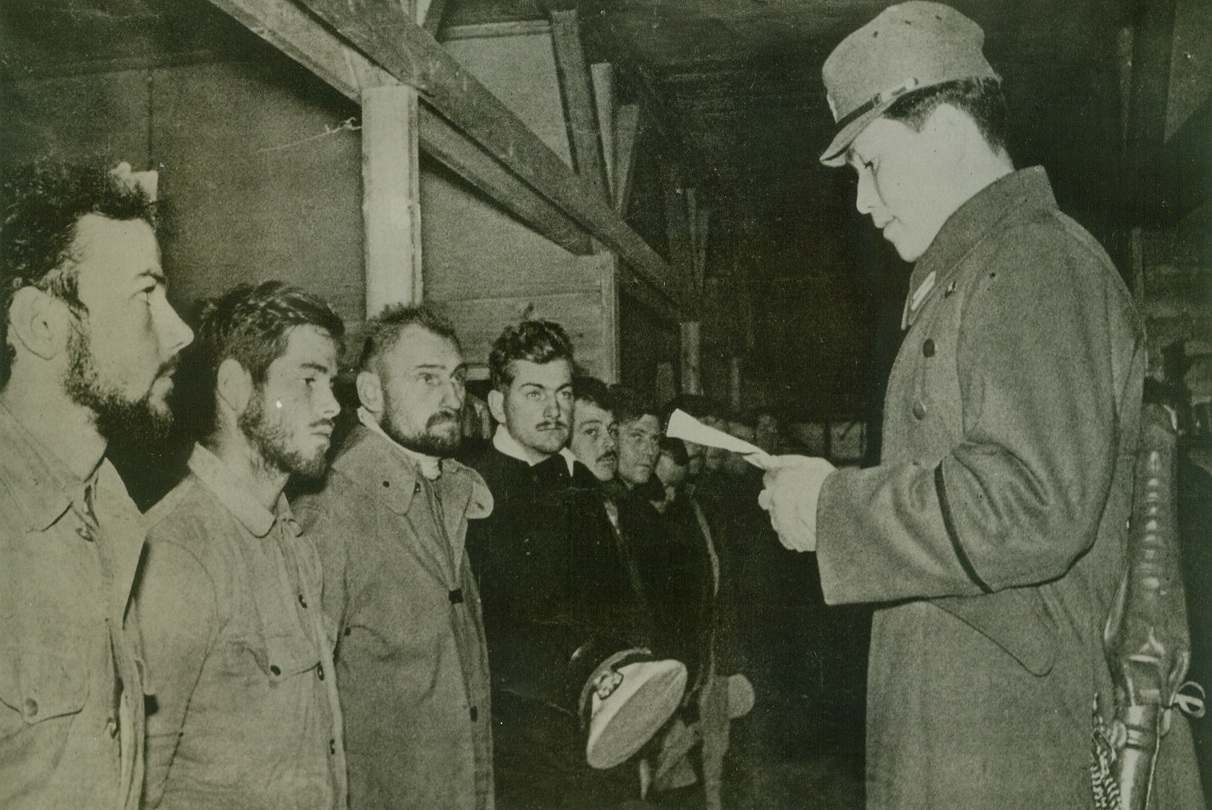
JAPANESE PROPAGANDA, 9/10/1942. Here is one of the pictures published in the Japanese propaganda magazine “Freedom,” published in Shanghai, the text of which was in English. Their version of the above photo follows: “Shortly after the historic fall of the British stronghold, Singapore, Lieut. Matsuda of the Japanese Military Press Bureau in Shanghai paid the internment camp a visit. The main object of his call was to tell officers and men of the camp of the smashing British defeat at Singapore. Bewildermen showed plainly on Anglo-American faces when Lieut. Matsuda read dispatches heralding further Nipponese successes in the South. The propaganda that their egoistic leaders had showered on them proved false.”Credit: Acme;
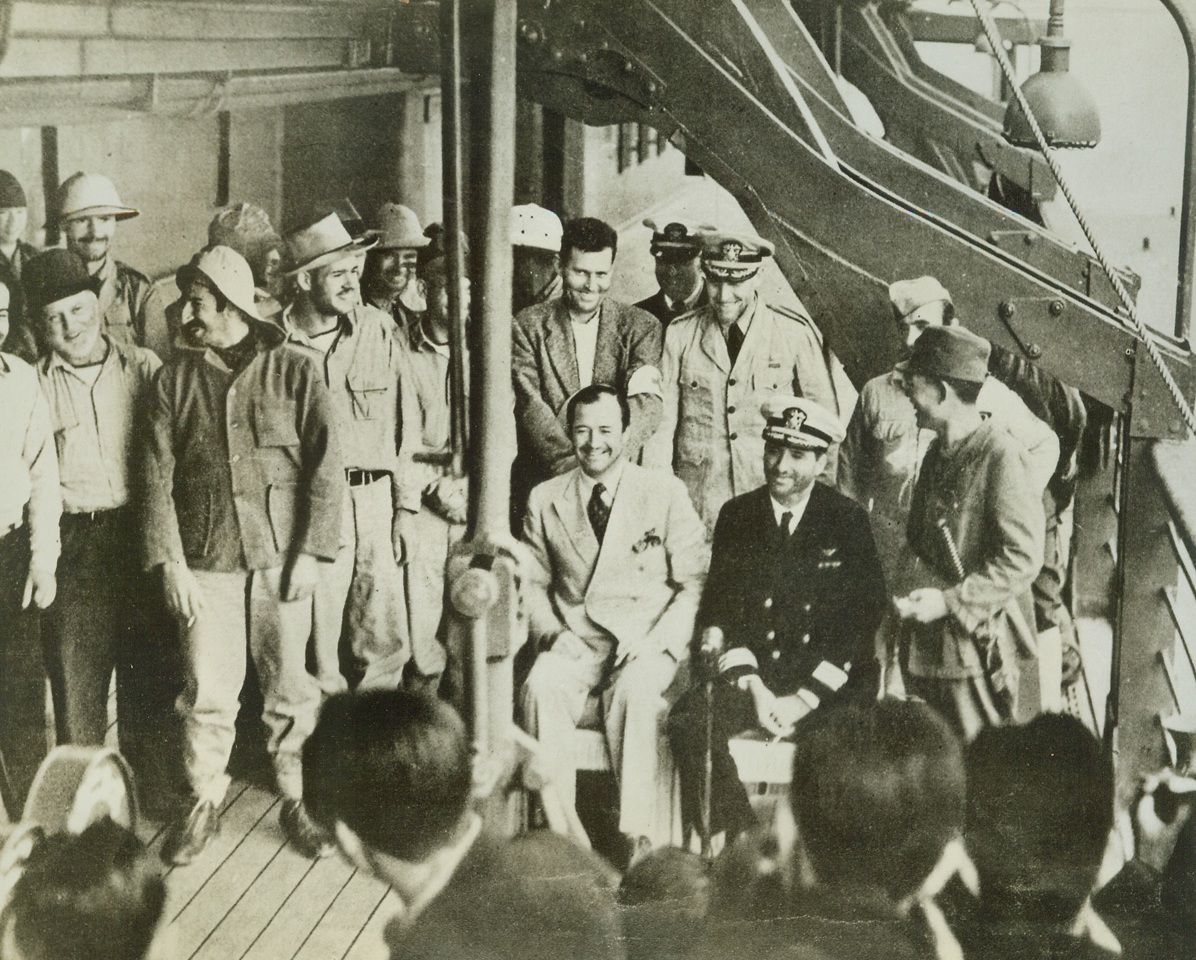
Japanese Propaganda, 9/10/1942. This picture reproduced from an English-Language propaganda Magazine titled “Freedom” published by the Japanese at Shanghai; which was brought back to the United States by a U.S. citizen interned by the Japanese after declaration of war December 7, 1941, and repatriated aboard the diplomatic exchange ship Gripsholm, gives the Japanese version of the internment of U.S. subjects pending their exchange for Japanese taken into custody in the U.S. Returning evacuees have indicated that in several instances statements incorporated by the Japanese in their story of the internment were obtained under duress. – Japanese describe these as part of the 1,300 prisoners they claim were captured at Wake Island and say that they are shown en route to Zentsuji Prisoners Camp in Kawaga Prefecture. Black uniformed American Officer is identified as Comdr. Winfield Scott Cunningham, Ex-Garrison Chief at Wake Island. Japanese caption describes men as “smiling broadly as if they had not a care in the world.” Credit: ACME;
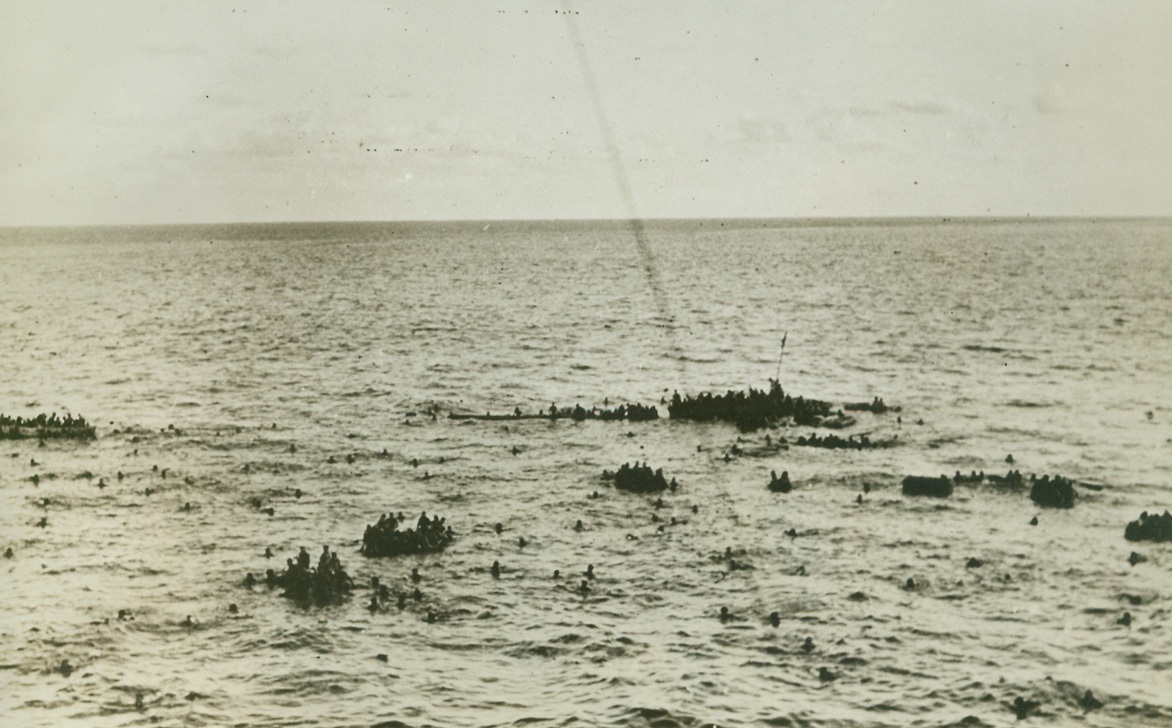
Rescue of Survivors from H.M.S. Dorsetshire Indian Ocean, 9/8/1942. Indian Ocean -- Hundreds of survivors of H.M.S., Dorsetshire cling to floating bits of wreckage, awaiting lifeboats from a rescuing British destroyer. The Dorsetshire was one of two cruisers sunk during action in the Indian Ocean. Credit Line (ACME);
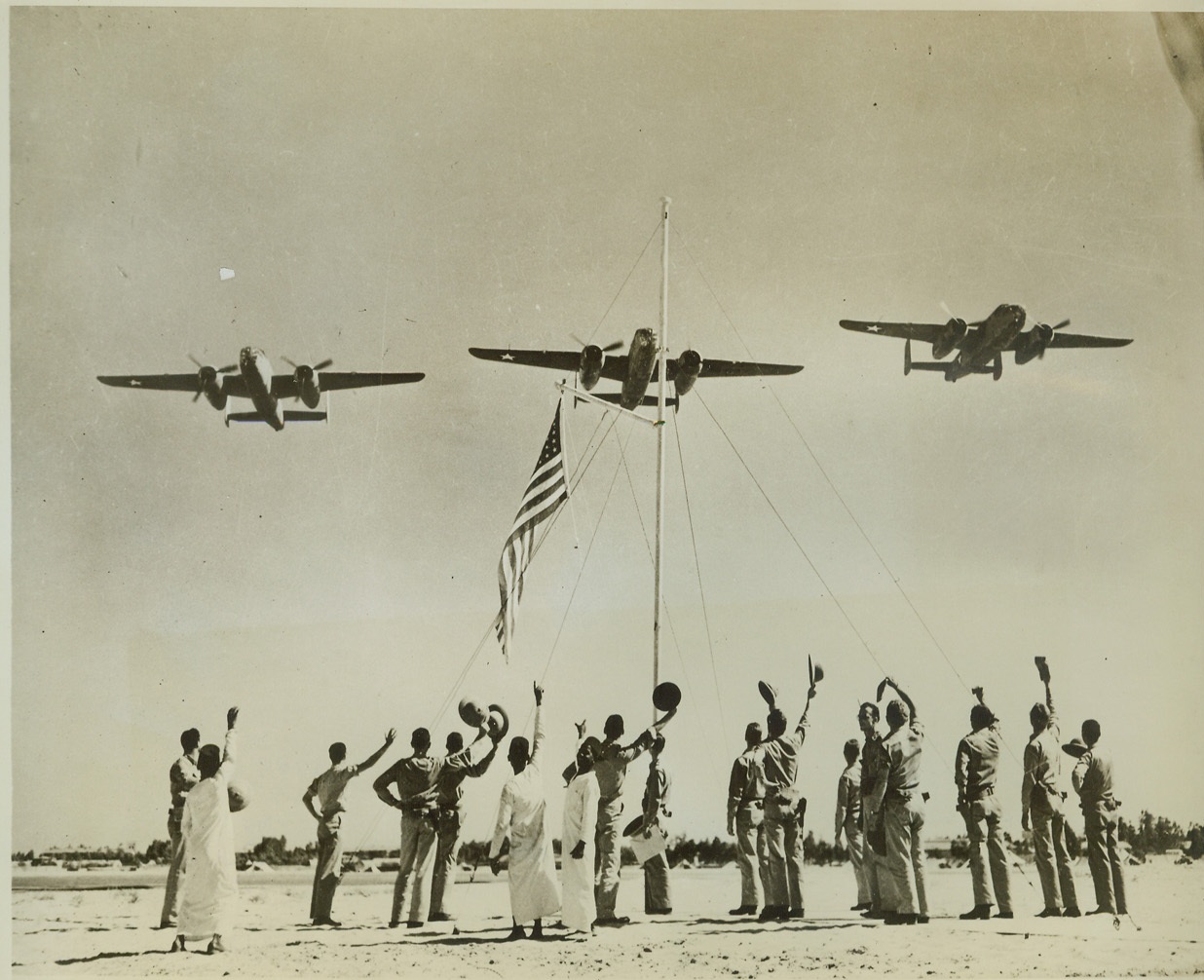
American Bombers Get Welcoming Committee, 9/12/1942. Middle East – Three U.S. medium bombers, B-52’s, get an enthusiastic welcome from their American ground crews after they have blasted Axis bases in the Middle East. The boys in native costume are mess attendants at the U.S. station. Credit: (ACME);
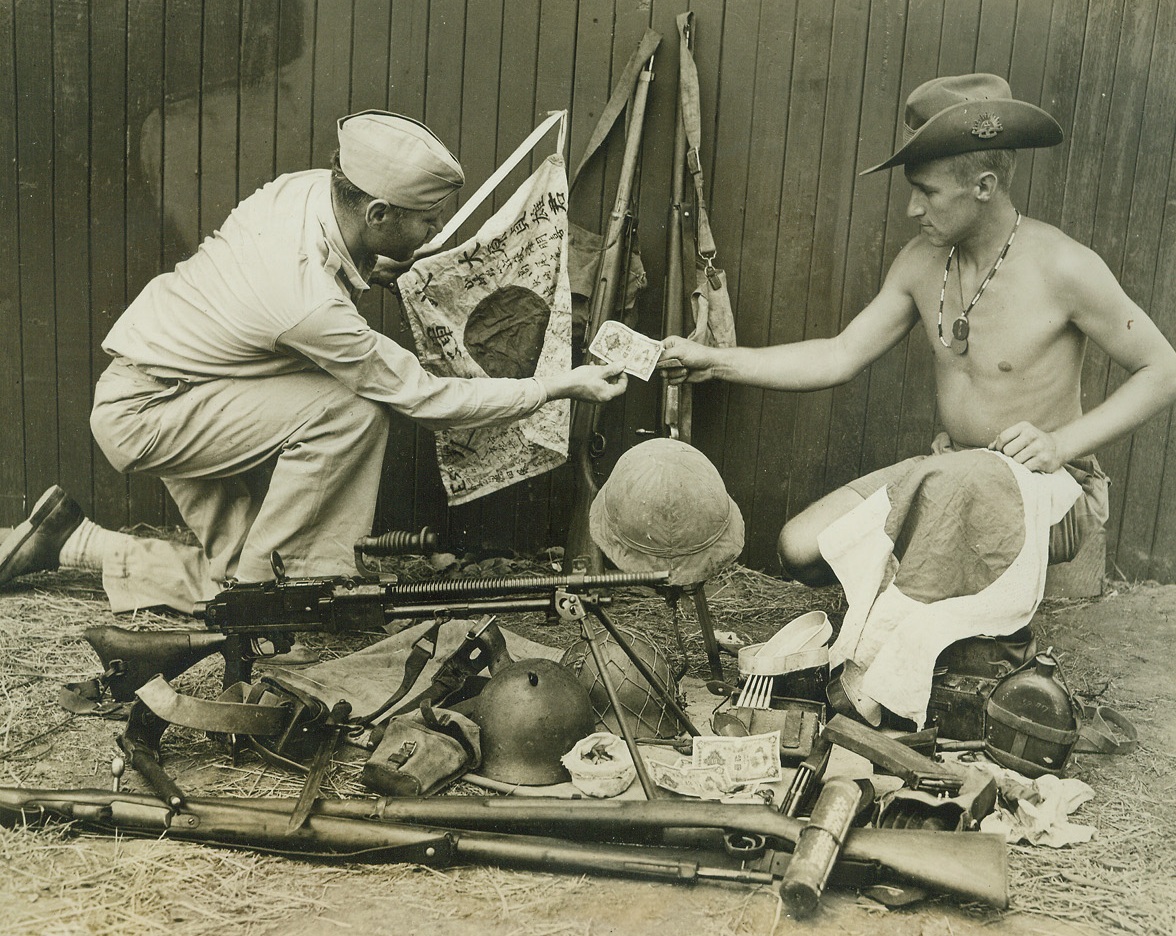
Jap War Trophies in New Guinea, 9/15/1942. New Guinea - - An American and an Australian solder, “somewhere in New Guinea”, are pictured as they examine some Japanese arms and other war equipment that were captured by allied forces during their operations against the Nipponese.Credit Line (ACME);
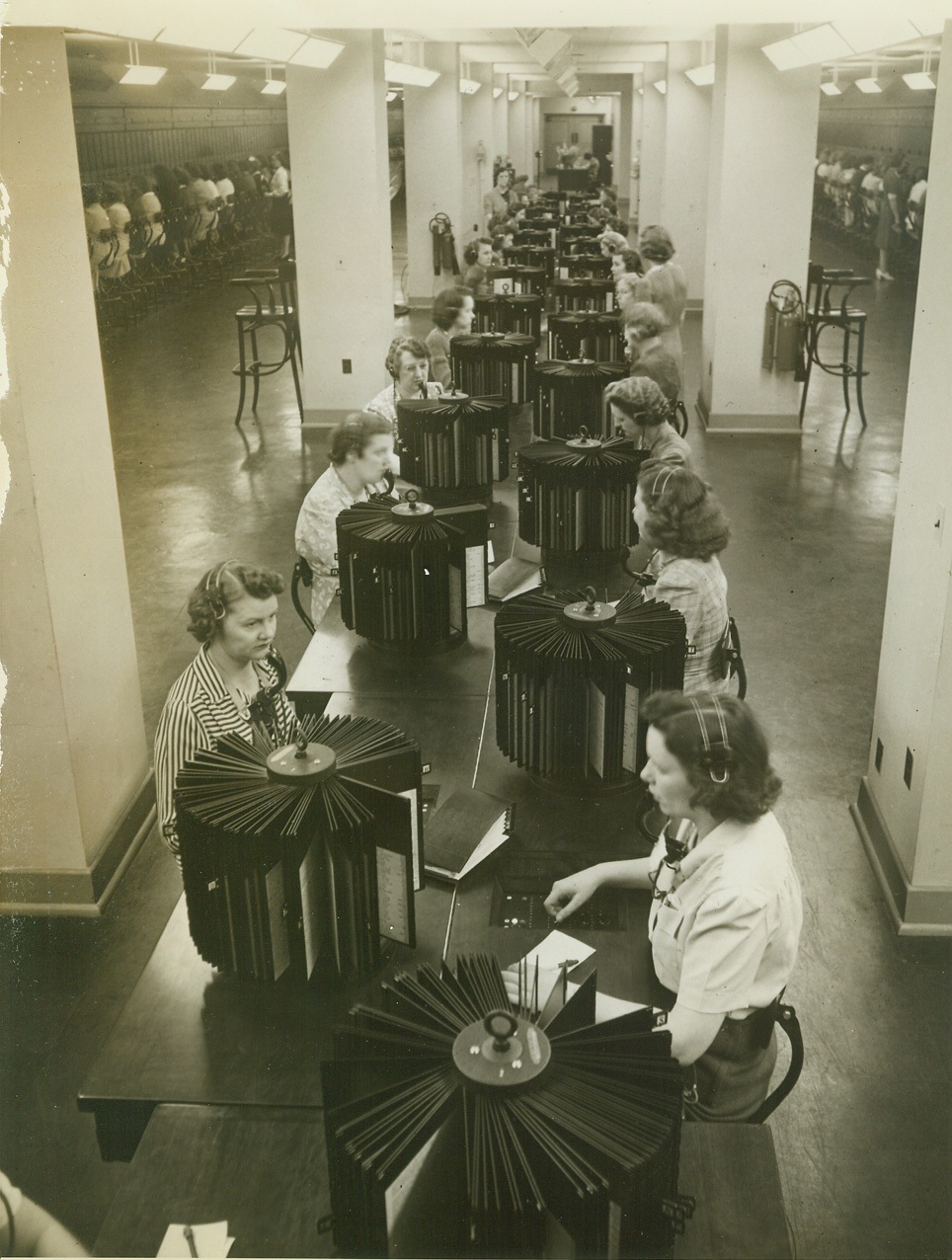
Phones of War at Work, 9/15/1942. Arlington, VA.—View of the information section in the telephone exchange of the War Department’s new office building at Arlington, just across the Potomac from Washington. It is in this section that operators look up and verify the correct branch or extension number for the many thousands of Army officers and civilians who work in the building. The exchange requires nearly 300 operators and supervisors; has more than 86,000 miles of trunk wires inside the building; has 370 incoming central trunk lines, 200 outgoing trunk lines, and 200 long distance loops. The 12 submarine canals which carry under the river to Washington weigh more than 250 tons. Credit: ACME.;
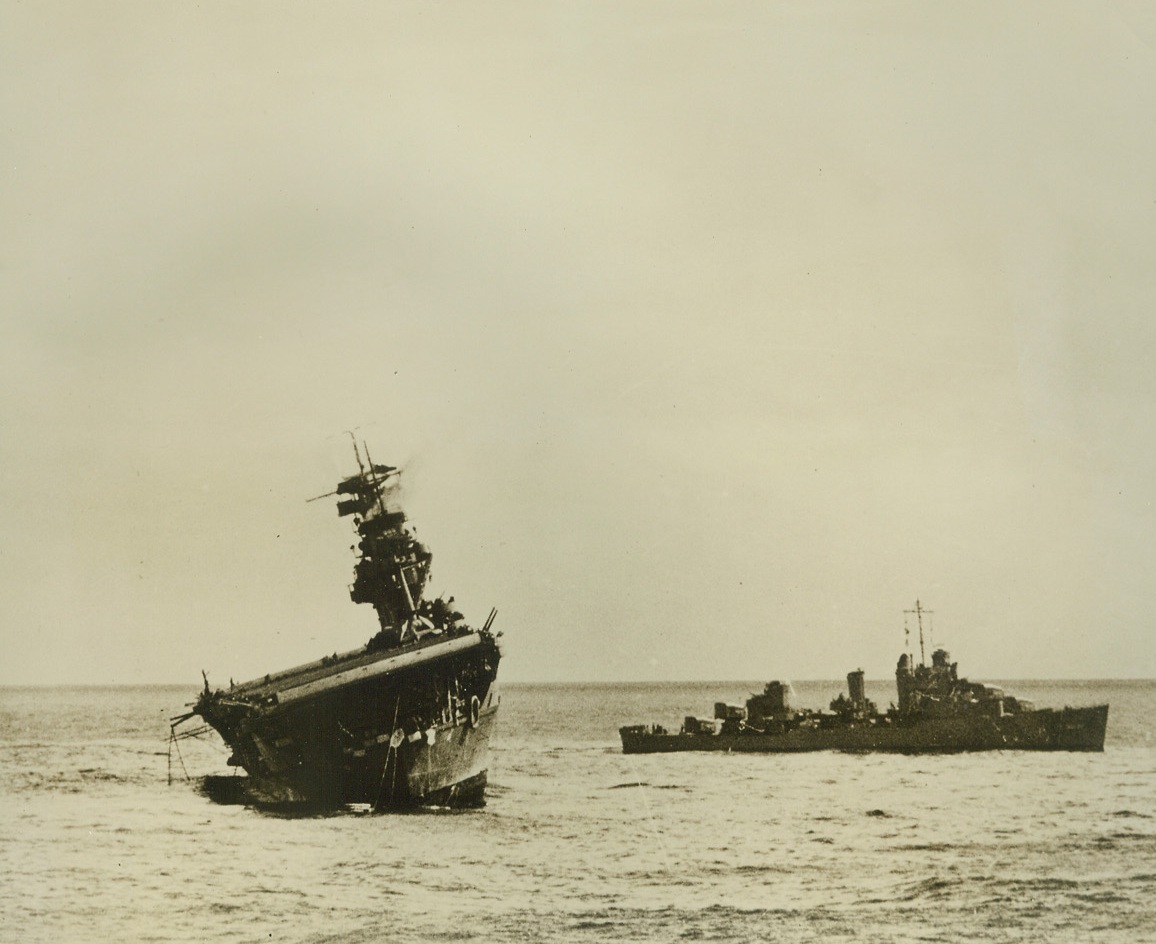
Stricken—But Still a Fighter, 9/16/1942. Washington, D.C. – An accompanying warship stands helplessly by as the stricken aircraft carrier U.S.S. Yorktown – her guns still pointed defiantly towards the sky from which Jap planes rained down bombs on her unceasingly – lists heavily toward the sea which finally claimed her. Two torpedoes from a relentless Jap sub finished off the 19,900-ton flat-top, which sank June 7th after it had gone through the worst of the battle of Midway island, and after planes that took off from her deck exacted a heavy toll on the Jap armada headed for Midway and the Hawaiian islands. Credit Line (Official U.S. Navy photo from ACME);
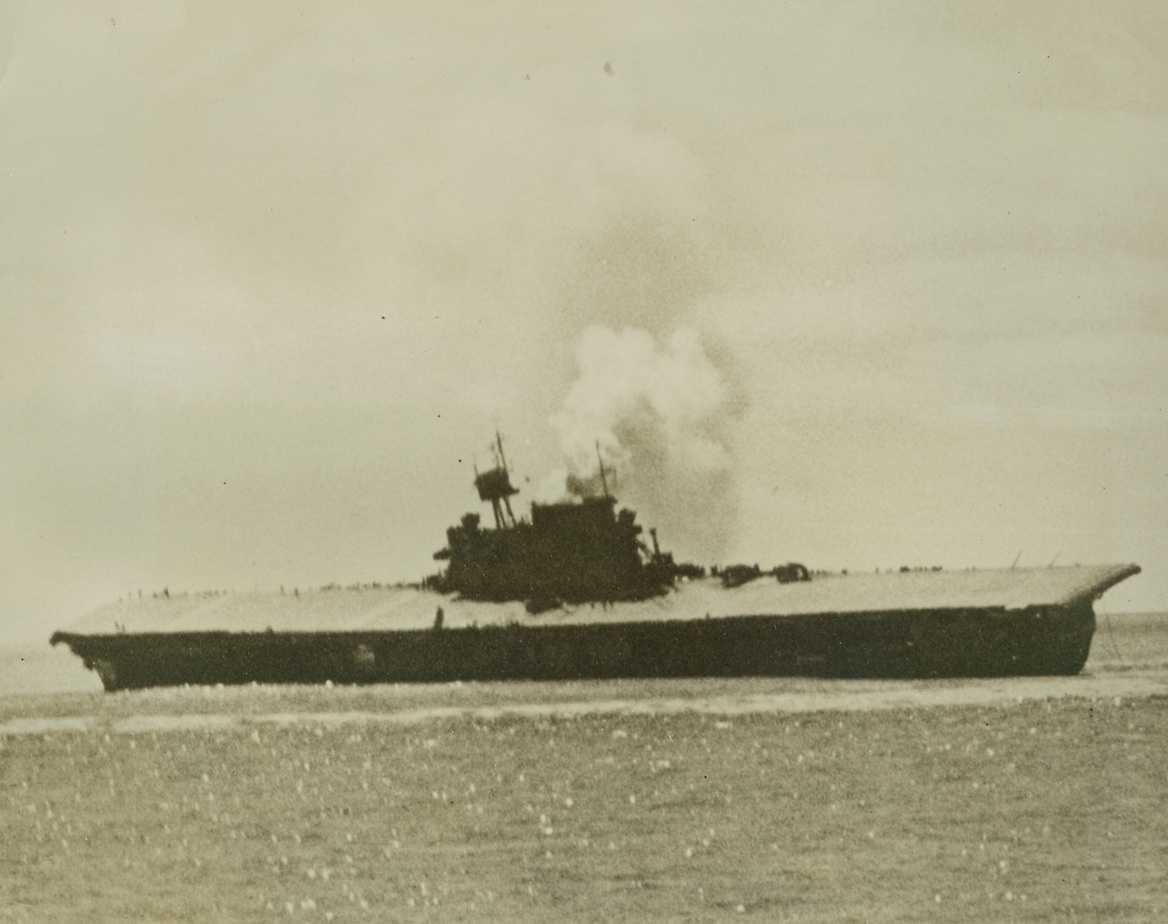
End of the Yorktown, 9/16/1942. Washington, D.C. – The flight decks are bare of planes and men as the aircraft carrier U.S.S. Yorktown, smoke billowing from her single funnel, lists heavily toward the gleaming Pacific. About 36 Jap bombers and torpedo planes swarmed around the 19,900-ton vessel through a hail of anti-aircraft fire, and knocked it out of action at the height of the battle of Midway island on June 4th. Even then it was thought that salvage would be possible, but a Jap sub sent two more torpedoes into her side and the veteran of the Coral sea battle finally capsized and sank on June 7th. Photos and story on the sinking were officially released by the Navy today.Credit Line (Officially U.S. Navy photo from ACME);
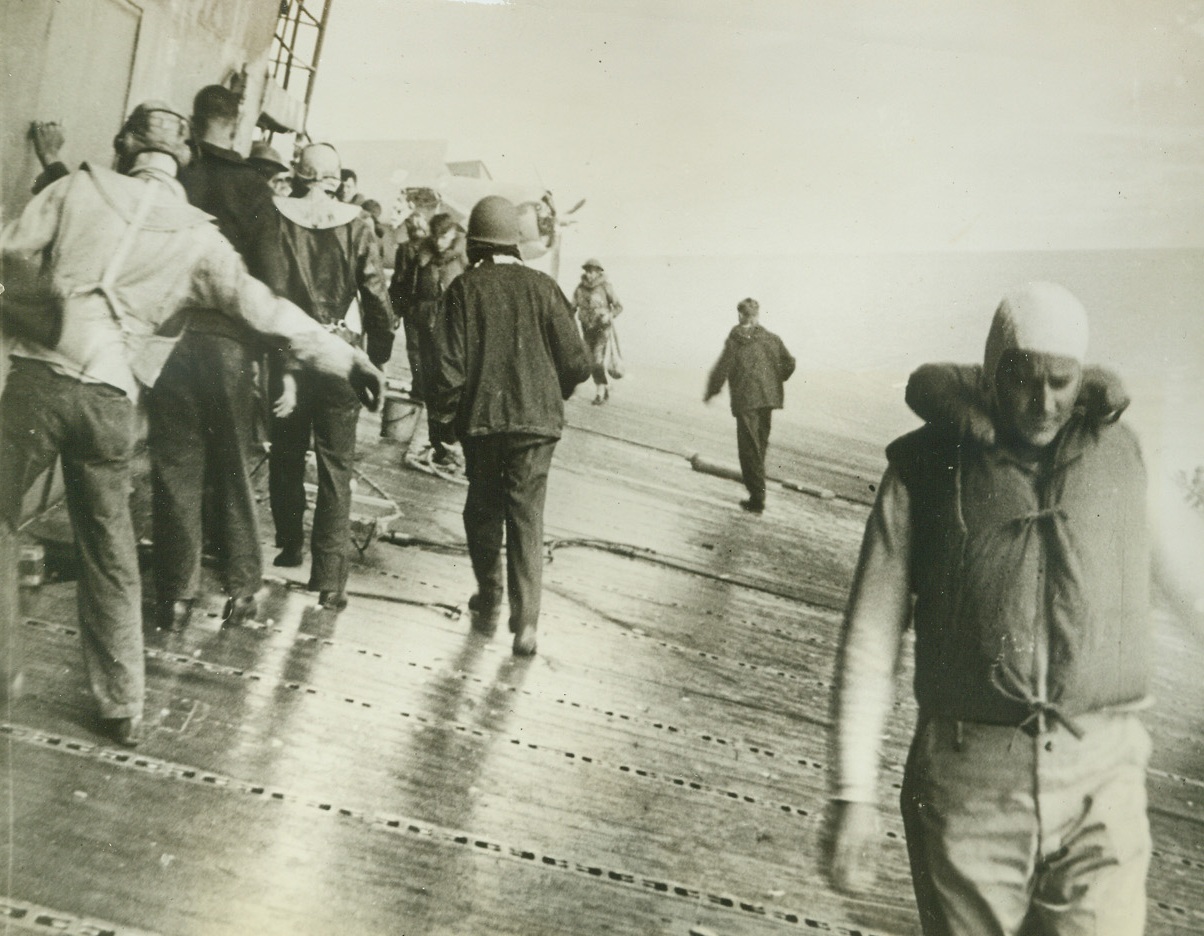
They’ll Remember the Yorktown, 9/16/1942. Washington, D.C. – Saddened crew members cautiously walk the sloping decks of their ship, the U.S.S. Yorktown—already listing toward the sea which marks her grave—after it was battered by a hail of Jap bombs and torpedos during the height of the battle of Midway island. The 19,900-ton flat-top finally sank on June 7th, but these men who saw their ship go down will remember –They’ll give the Japs reason to remember! The Japs got the veteran aircraft carrier, but only after it had been in at the death of at least a dozen Jap ships, and had played a major role in turning back the Japanese armada from an attempted invasions of Midway island and the Hawaiians.Credit Line (Official U.S. Navy photo from ACME);
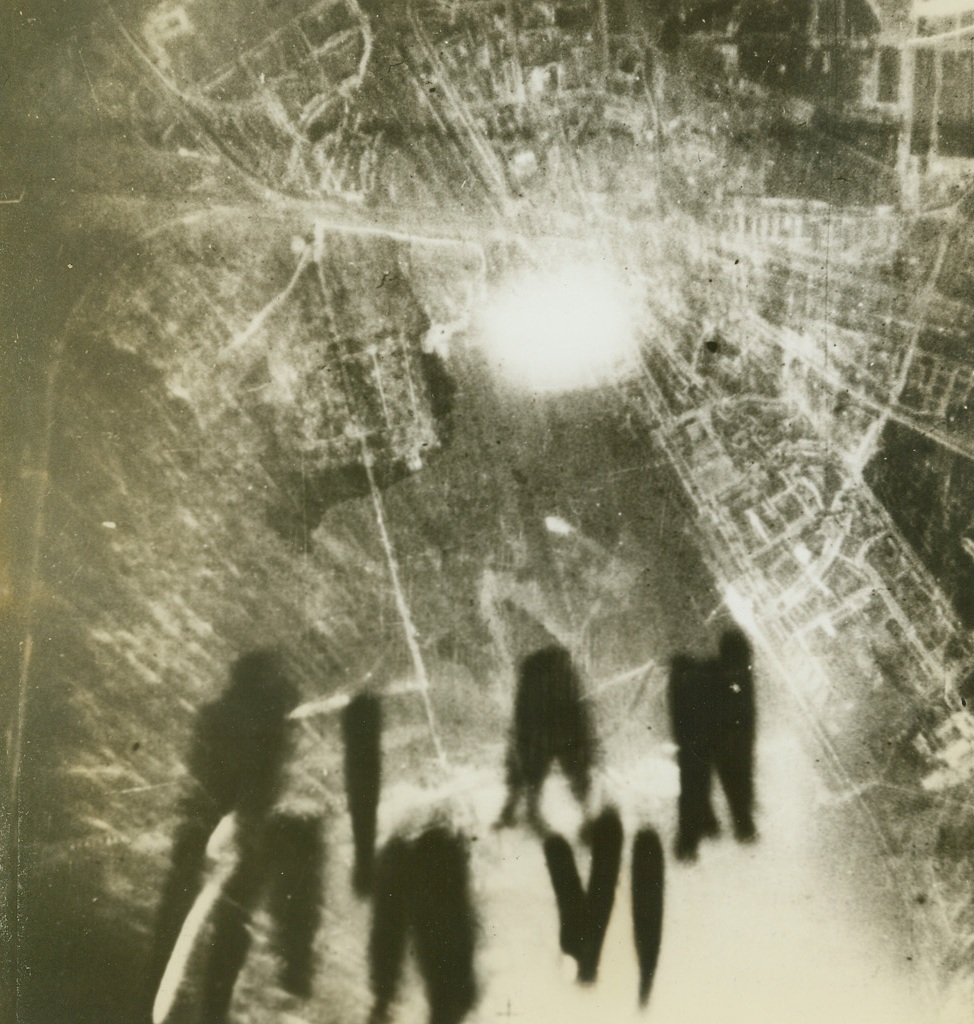
HELL IS EARTHWARD BOUND, 9/17/1942. NUREMBERG, GERMANY—Incendiary bombs, just released from one of the RAF planes during the night raid on Nuremberg on Aug. 28-29, are silhouetted against the glowing light from previously dropped bombs which suffused the area and made it an easy target. The brightest glow is caused by a raging fire near the famous Nazi Party rally ground in the city. The Germans made no mention of the raid, but this photograph does not lie. Photo arrived here by Clipper from London. Credit: Acme;
![KEEPING SUPPLIES FROM ROMMEL, 9/17/1942. SOMEWHERE IN THE MEDITERRANEAN—Towering plumes of smoke drift back from a derelict Axis supply vessel which was hit amidships and in bows by an RAF bomber. This vessel of medium size was carrying supplies to Rommel’s hard-pressed army when it was intercepted, and received two direct hits. The British are waging an [sic] relentless bombing effort to keep the supply route to Rommel closed. Credit: Acme;](/media/13760/9-17-42-2303.jpg)
KEEPING SUPPLIES FROM ROMMEL, 9/17/1942. SOMEWHERE IN THE MEDITERRANEAN—Towering plumes of smoke drift back from a derelict Axis supply vessel which was hit amidships and in bows by an RAF bomber. This vessel of medium size was carrying supplies to Rommel’s hard-pressed army when it was intercepted, and received two direct hits. The British are waging an [sic] relentless bombing effort to keep the supply route to Rommel closed. Credit: Acme;
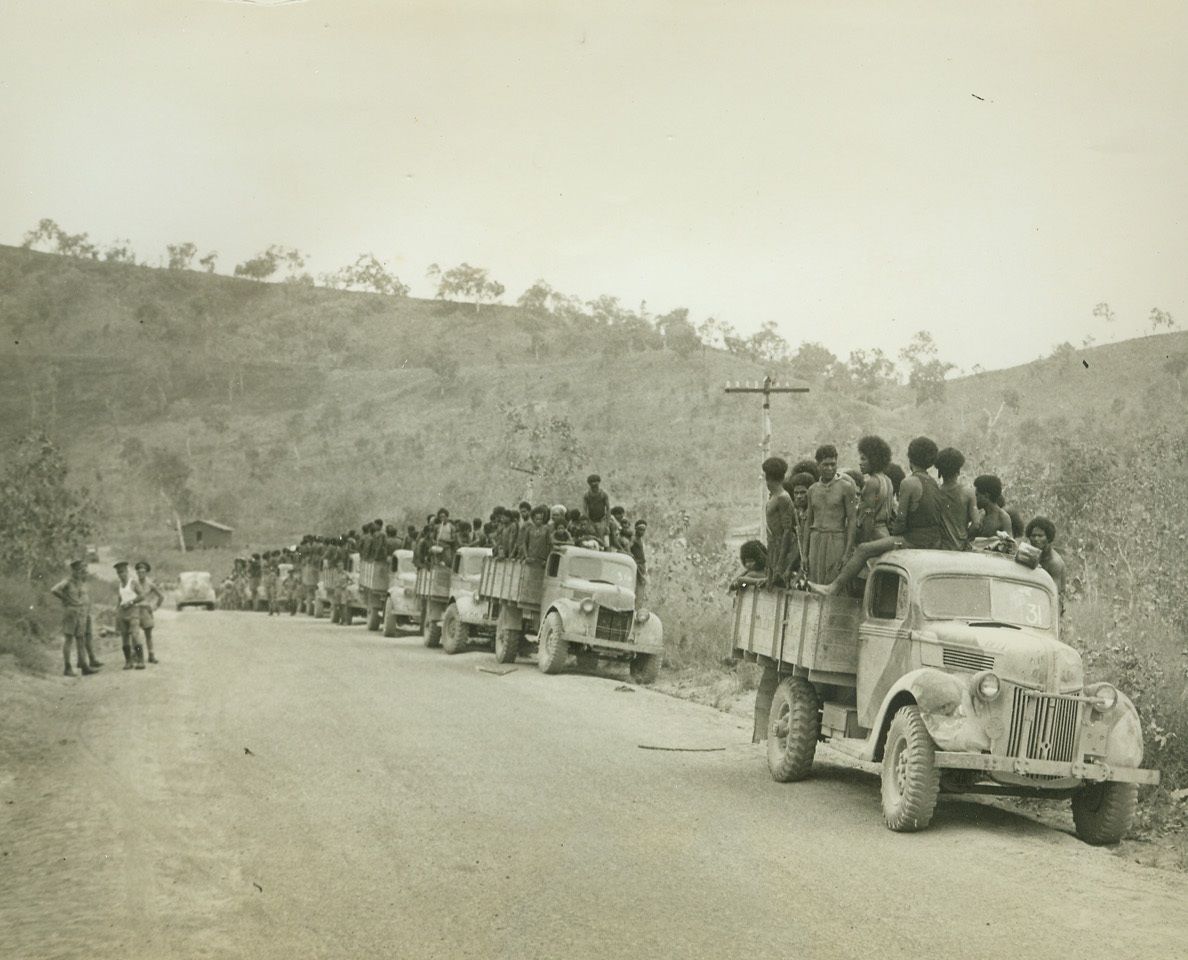
Caravan of Supplies to U.S. Troops in New Guinea, 9/17/1942. New Guinea – New Guinea natives ride on trucks to the starting point of foot trails over which they carry supplies to troops battling in back country. Each native can carry about 40 pounds of the necessary food and equipment.Credit Line (ACME);
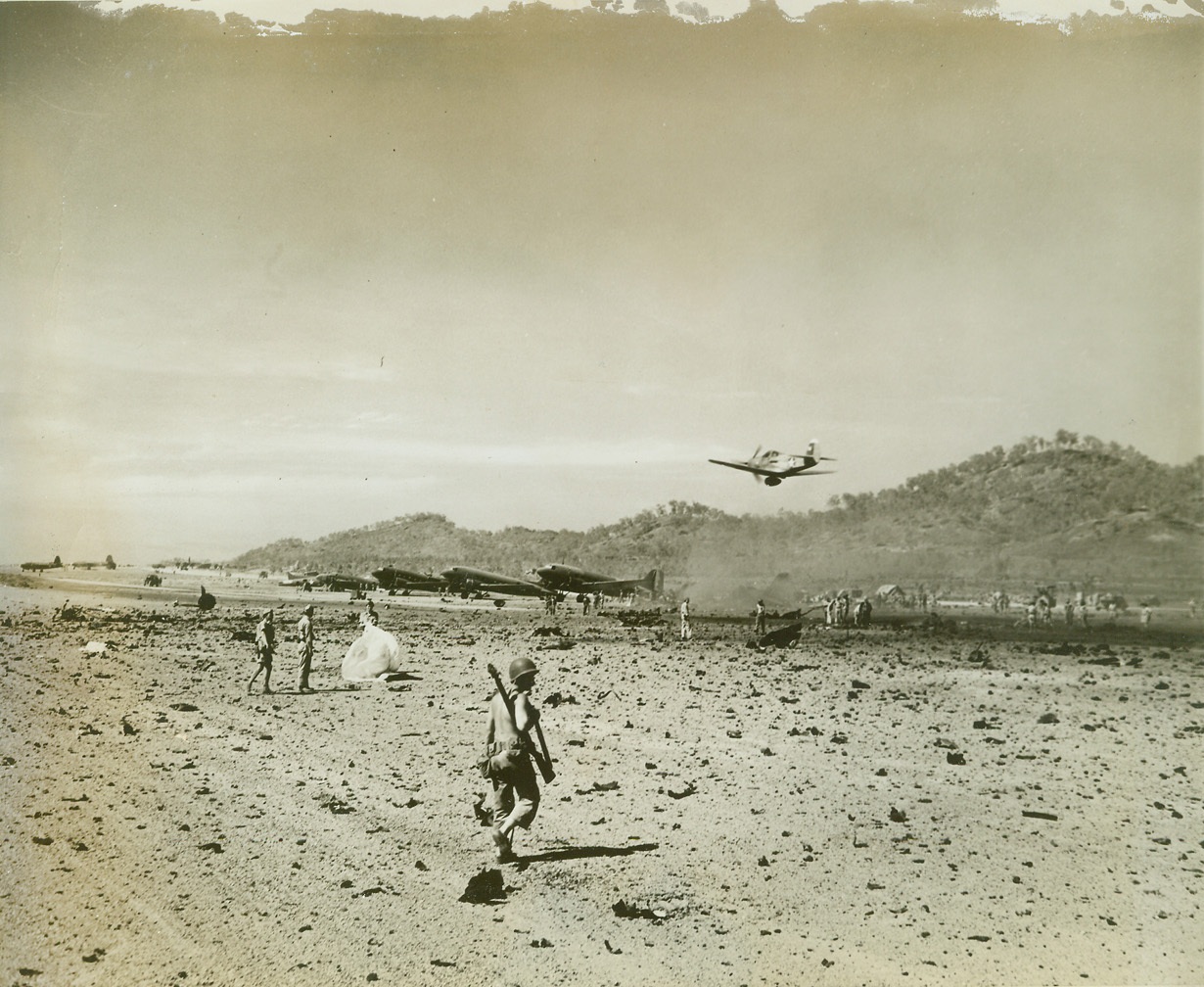
A debris-strewn airfield, 9/17/1942. New Guinea—A debris-strewn airfield marks the end of a surprise Jap raid on the Allied base of Port Moresby. An American P-39 circles low over the landing field to see if the terrain is in shape for a landing. American and Australian soldiers pick up scraps of wood and metal and repair damage which was not great. Credit: ACME;
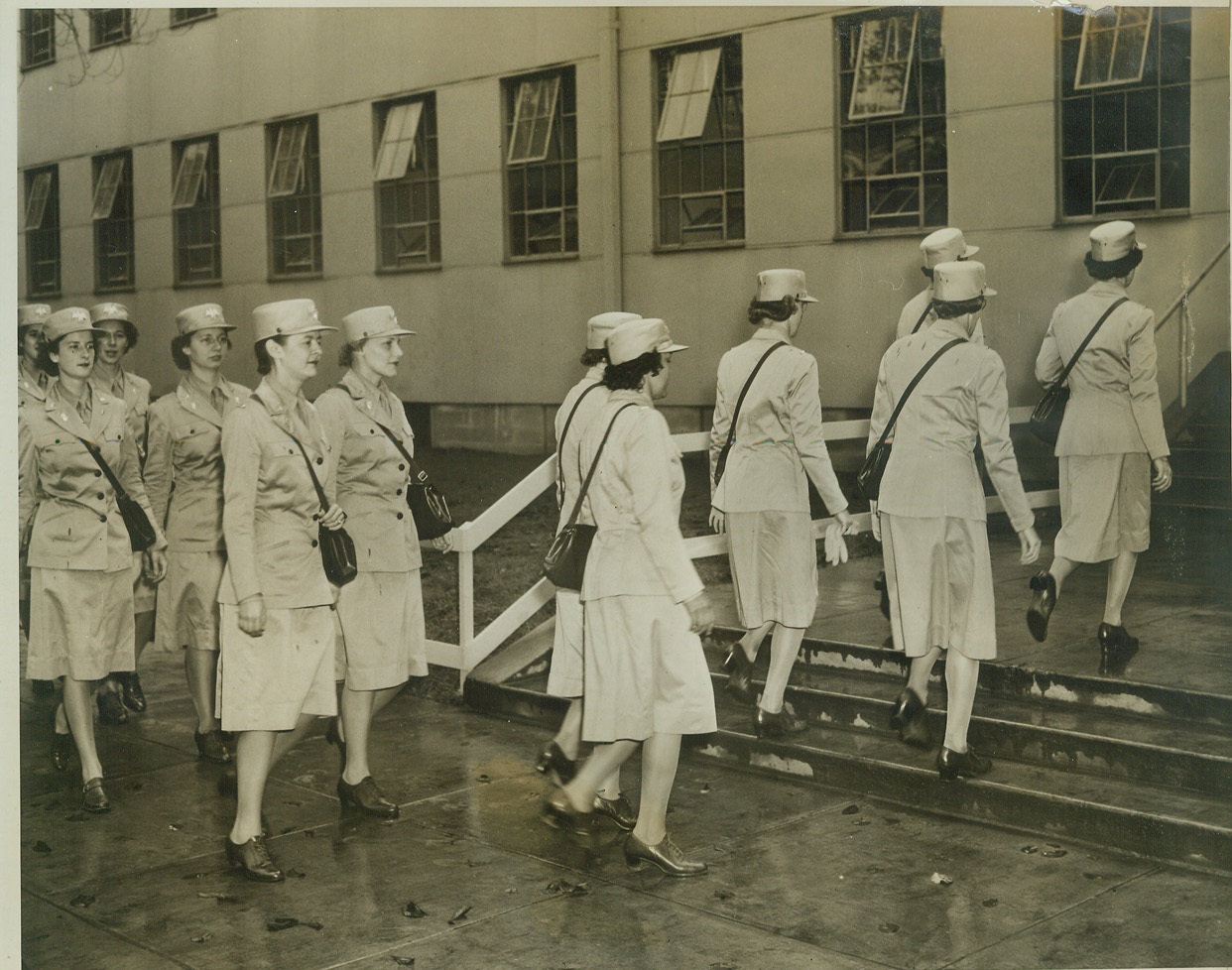
The WAACS Take Over, 9/18/1942. Washington, D.C. – A group of WAACs march into one of the War Department’s temporary buildings as they reported for duty on Sept. 18th to take the place of male officers in office work. Credit: (ACME);
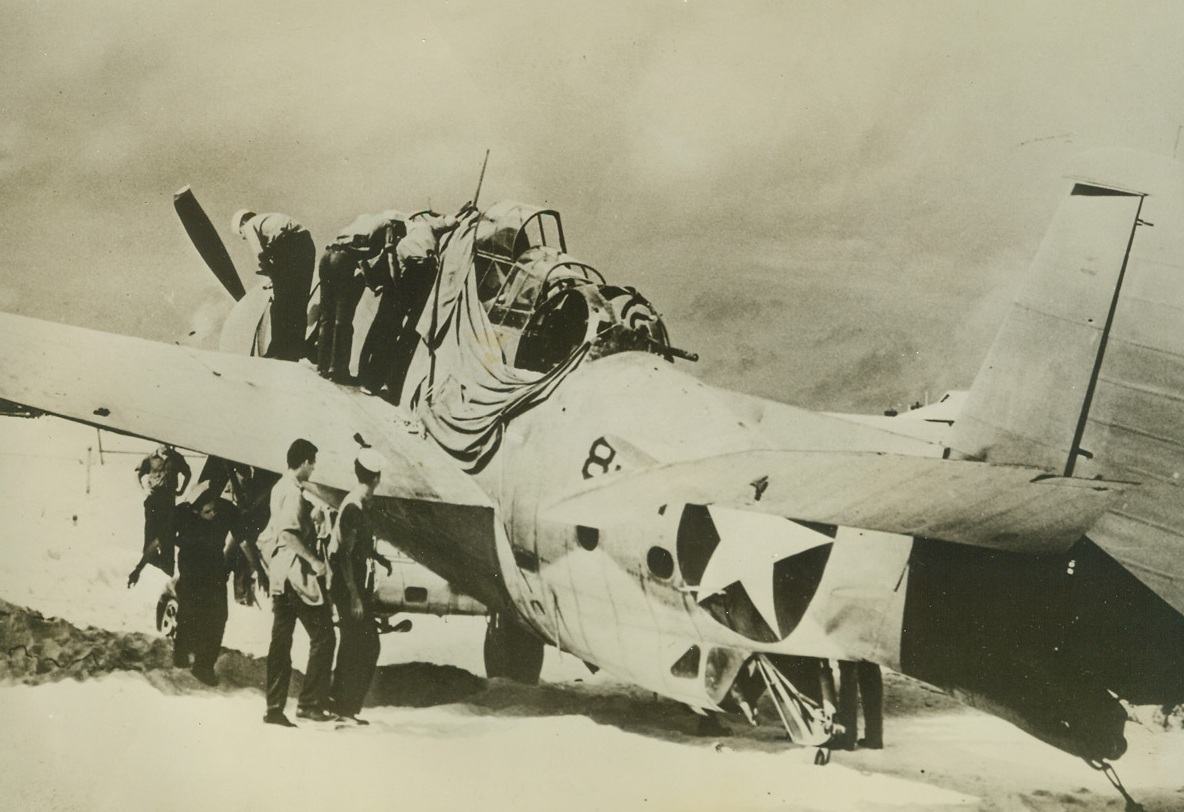
“Avengers” Can Take It, 9/18/1942. Midway Island – During the battle of Midway, Grumman torpedo bombers, known as “Avengers”, fought until disabled, but returned home. This one, although badly shot up, was ablet to get back to Midway under its own power. No orange crates, these “Avengers” are structurally sound and have great stamina.Credit Line (ACME);
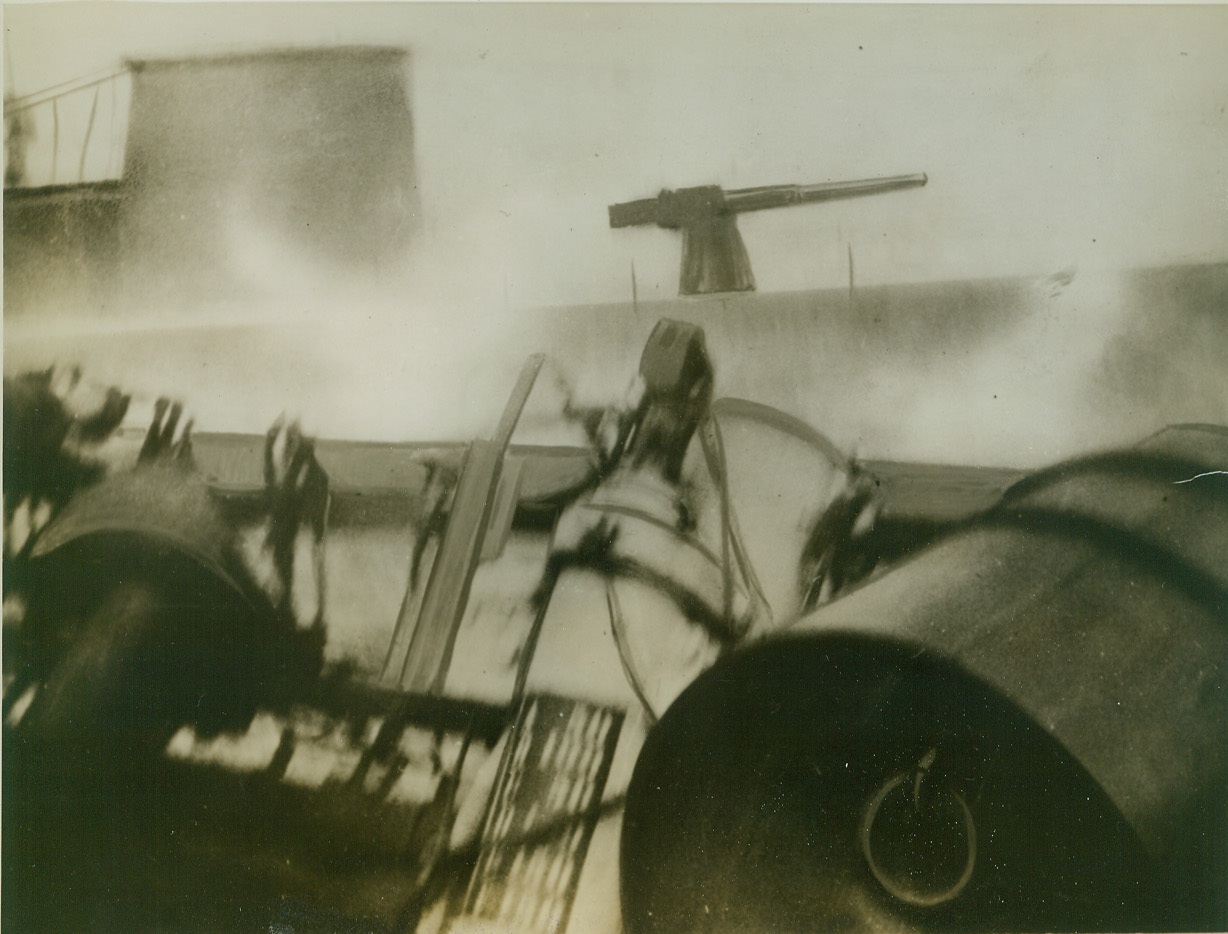
CANADIAN DESTROYER GETS A NAZI SUB, 9/19/1942. OTTAWA – Somewhere in the Atlantic the Canadian destroyer Assiniboine tangled with a German submarine and when the fog had lifted, the destroyer had rammed and sunk the sub, and captured most of the crew. Above dramatic picture was made as the submarine, gun and part of hatch seen in background slithered off the destroyer, part of rear of which can be seen in foreground. Credit: ACME;
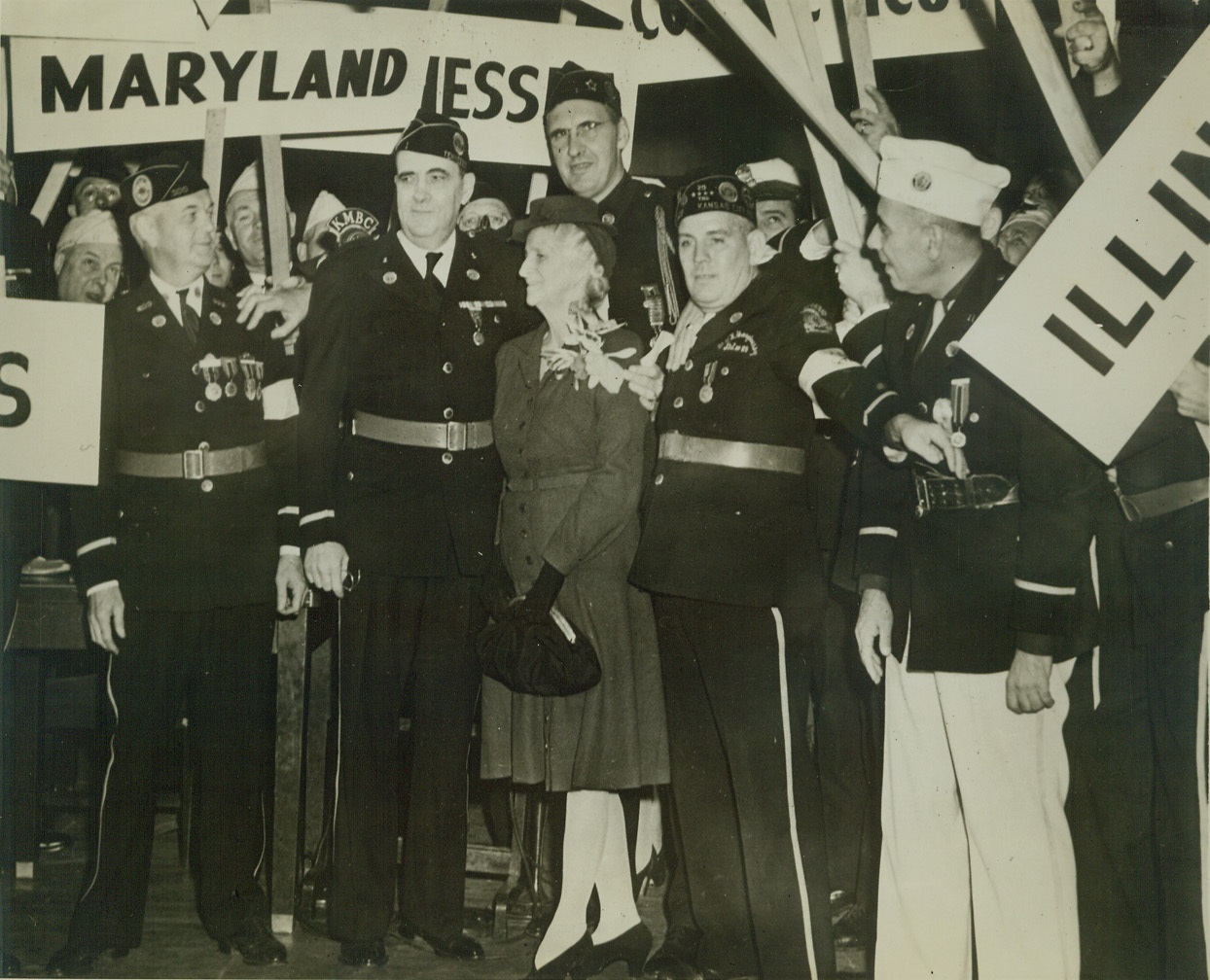
ROANE WARING NEW LEGION COMMANDER, 9/22/1942. KANSAS CITY, MO. – Col. Roane Waring of Memphis, Tenn., and his wife are shown standing on platform of Kansas City Municipal Auditorium after the American Legion had named him National Commander. The new Commander and wife are in center surrounded by delegates holding state standards. Credit: ACME;
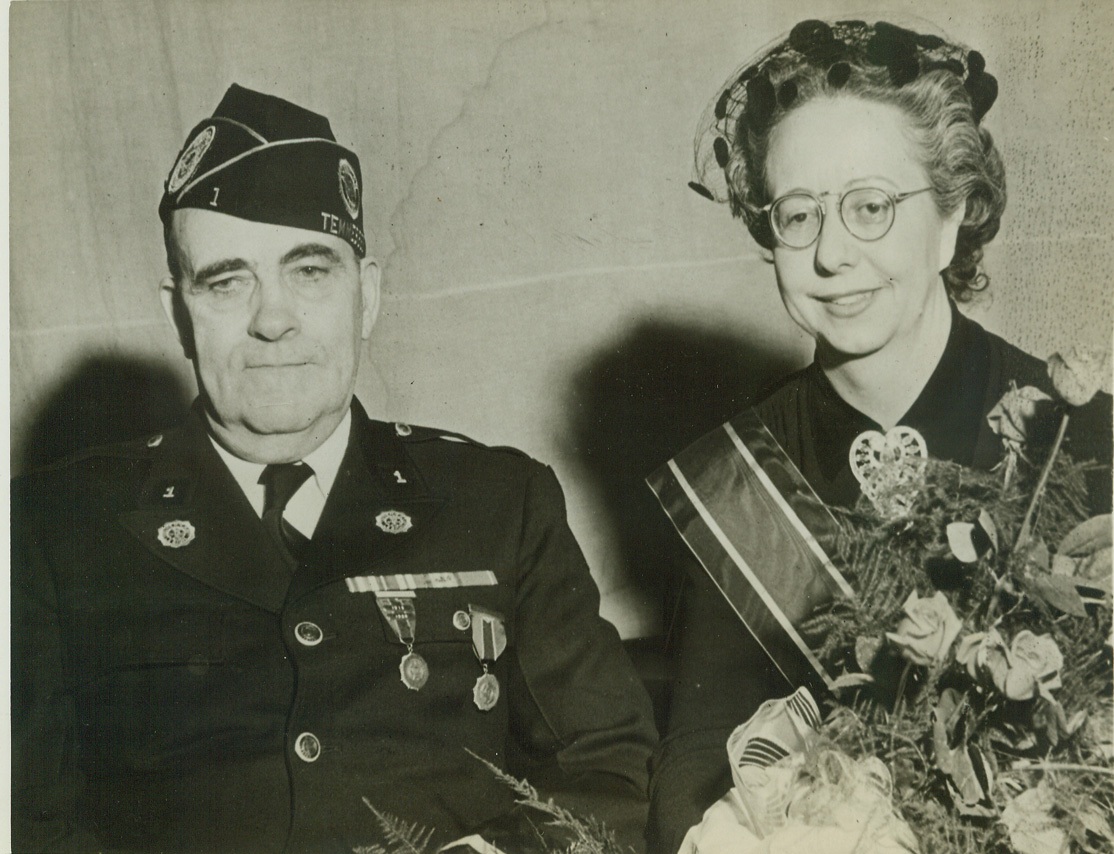
NEW LEGION AND AUXILIARY COMMANDERS, 9/22/1942. KANSAS CITY, MO. – Col. Roane Waring of Memphis, Tenn., new National Commander of the American Legion and Mrs. Alfred Mathebat of Alemeda, Calif., new President of the Legion Auxiliary, after their election at Kansas City convention. Credit: ACME;
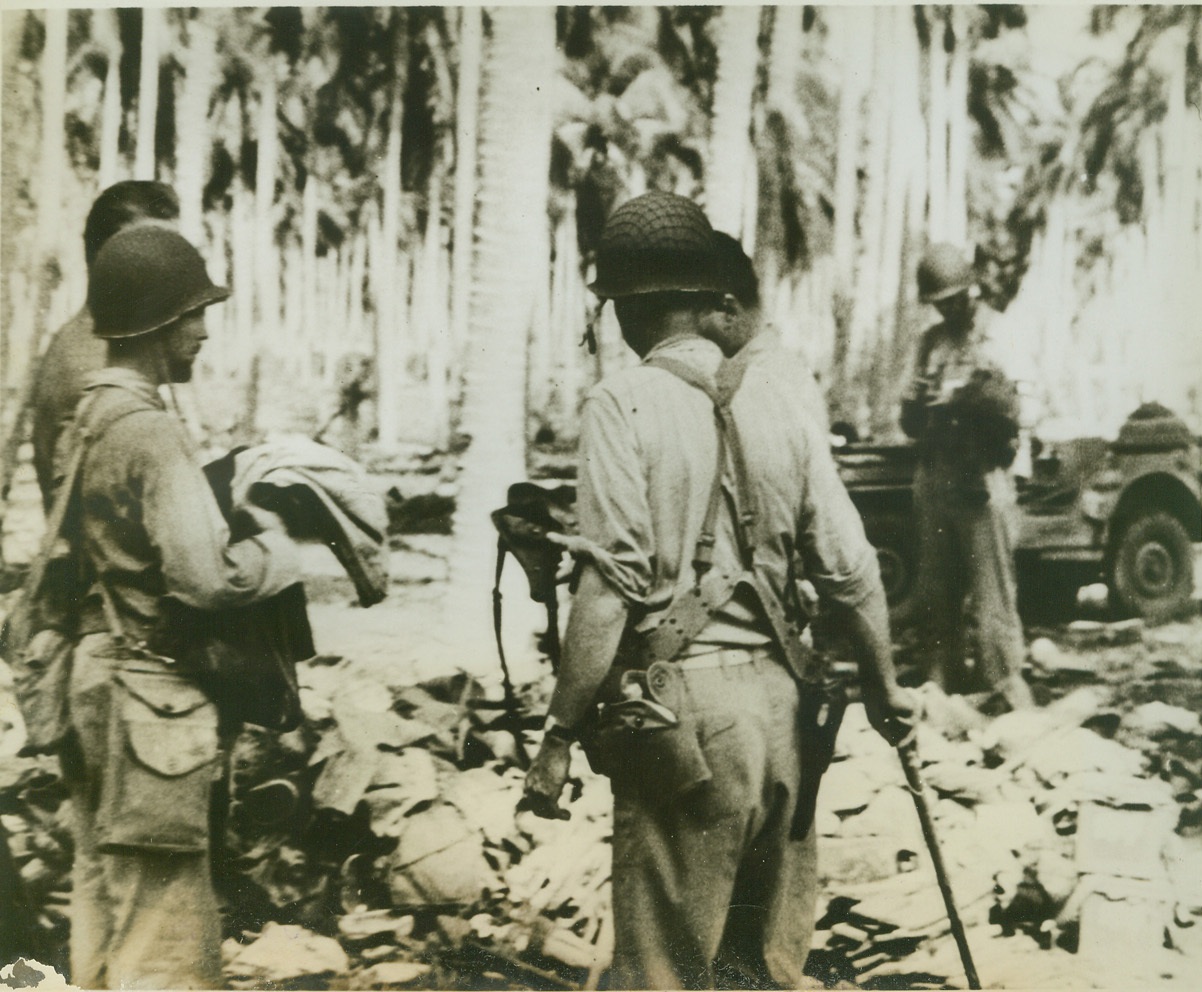
MARINES EXAM CAPTURED JAP EQUIPMENT, 9/22/1942. GUADALCANAL, SOLOMON ISLANDS – Five U.S. Marines look over equipment captured from the Japanese on Guadalcanal Island recently. Note American Jeep in background. (Passed by censors.) Credit: ACME;
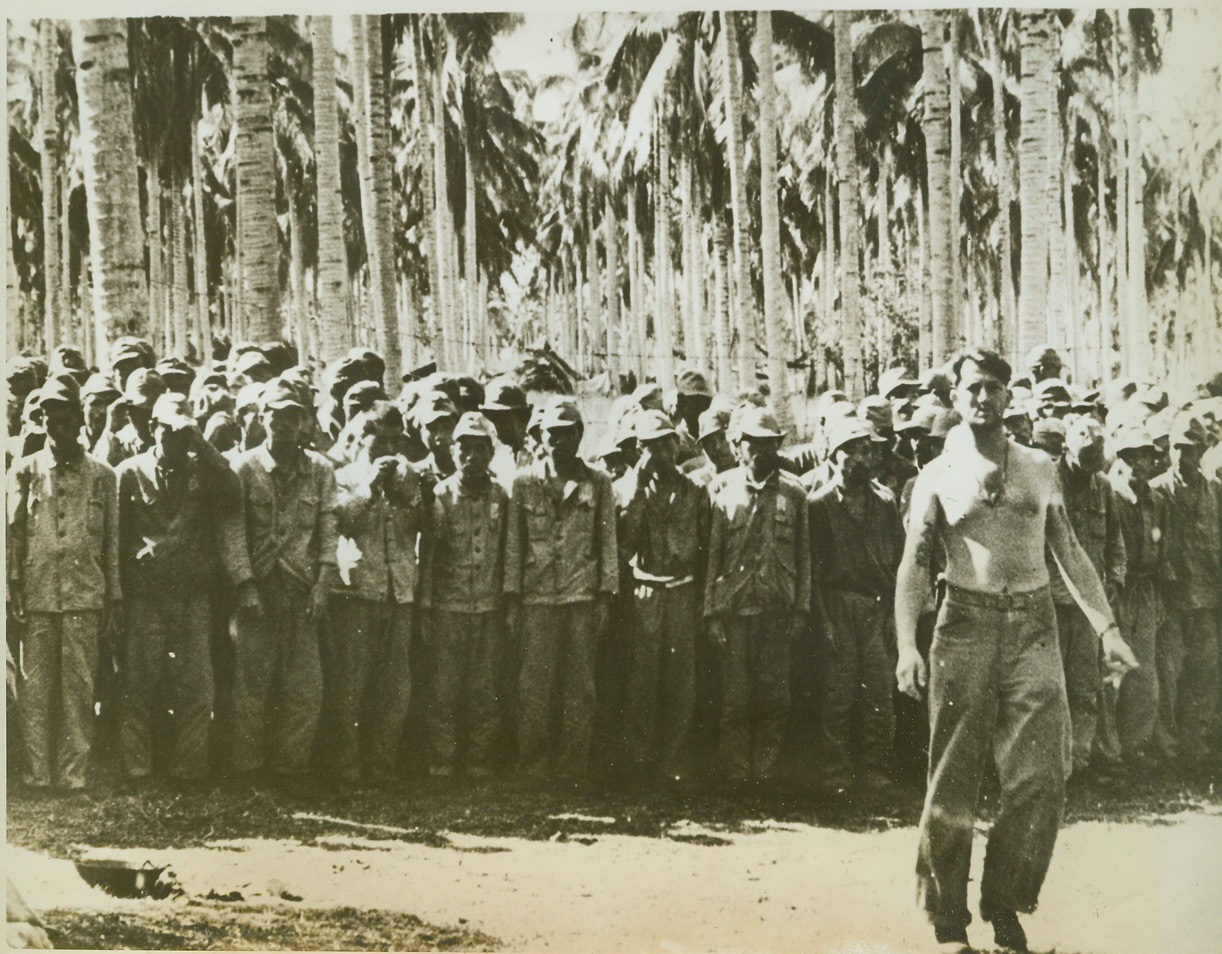
JAPS CAUGHT BY U.S. MARINES, 9/22/1942. GUADALCANAL, SOLOMON ISLANDS – A crowd of Japanese workers, who were captured by the U.S. Marines during the fighting on Guadalcanal Island recently, line up at a prison camp. The Japs had been building bases and installations on the island. (Passed by censors.) Credit: ACME;
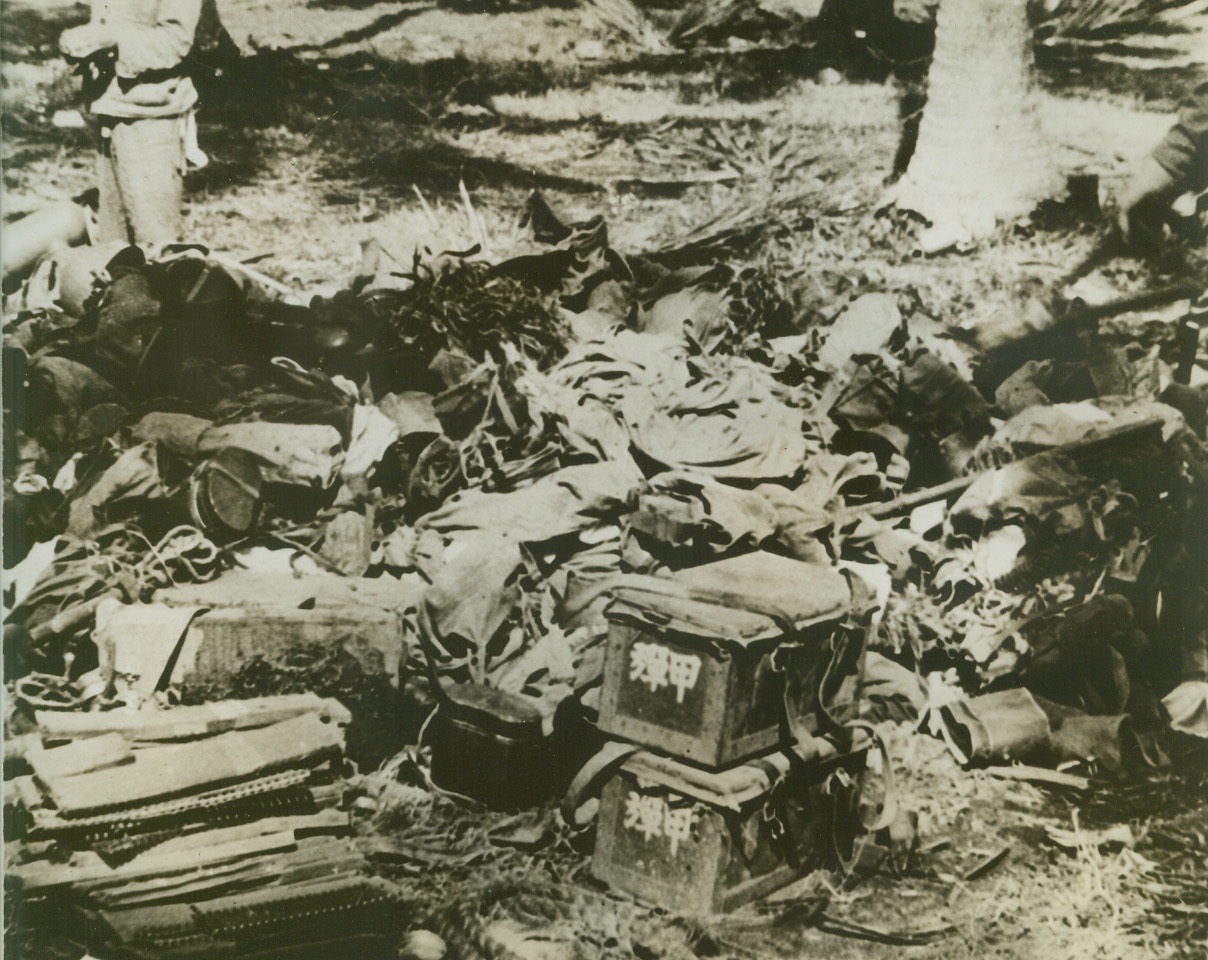
LOOT FROM THE JAPANESE, 9/22/1942. GUADALCANAL, SOLOMON ISLANDS—A large pile of military equipment and stores captured by the U.S. Marines in the hot action on Guadalcanal Island, recently. Ammunition belts can be seen in left foreground. Credit: Acme;
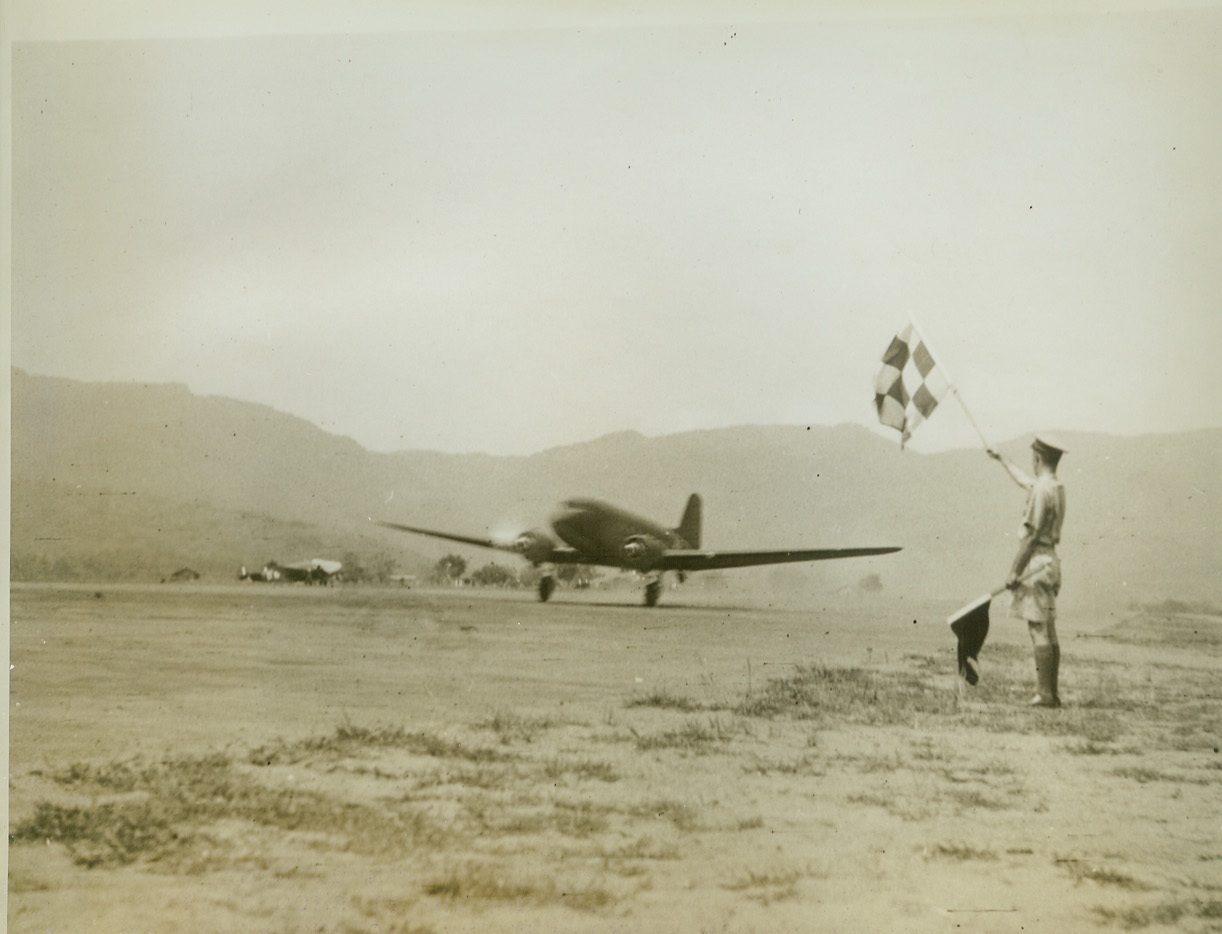
Dark Continent Brought to Light, 9/22/1942.
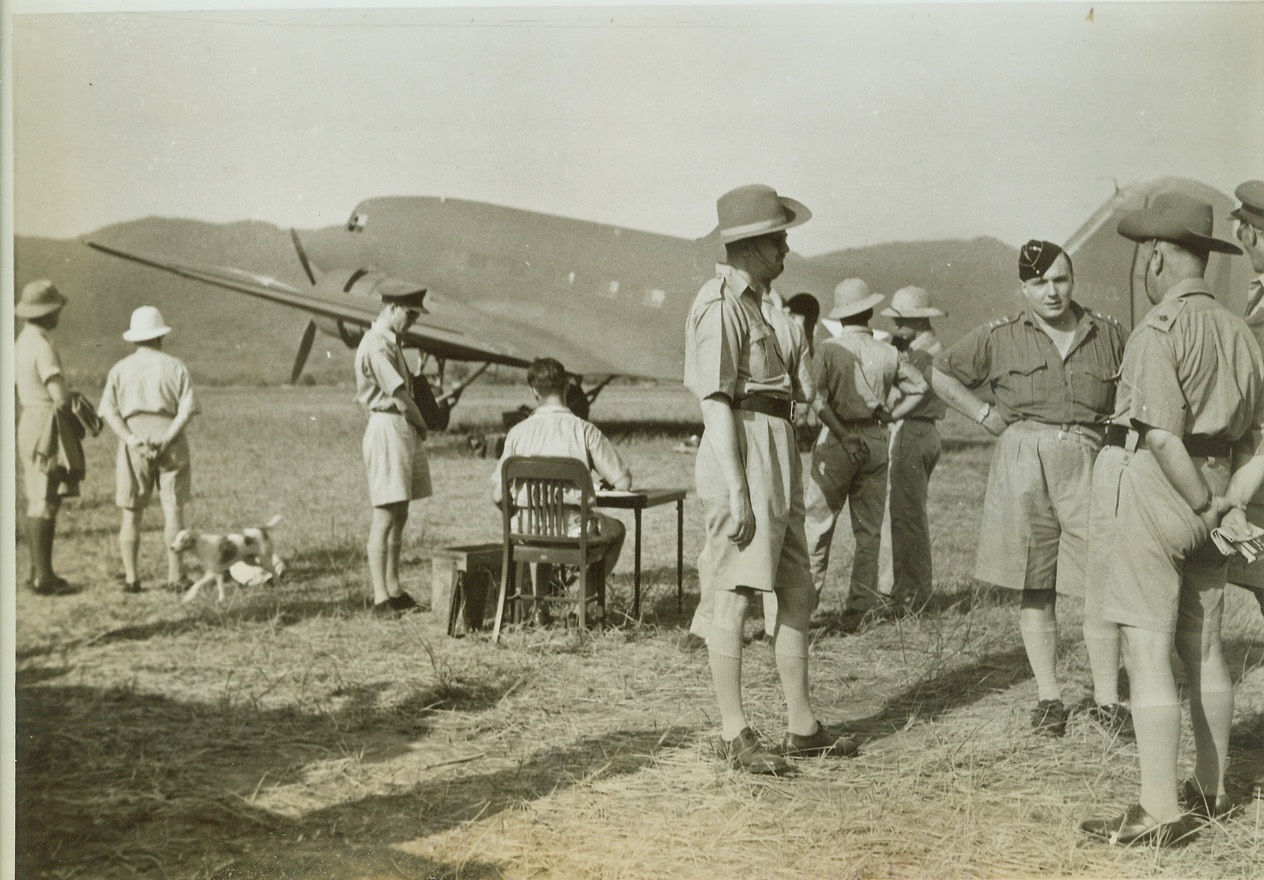
Dark Continent Brought to Light, 9/22/1942.
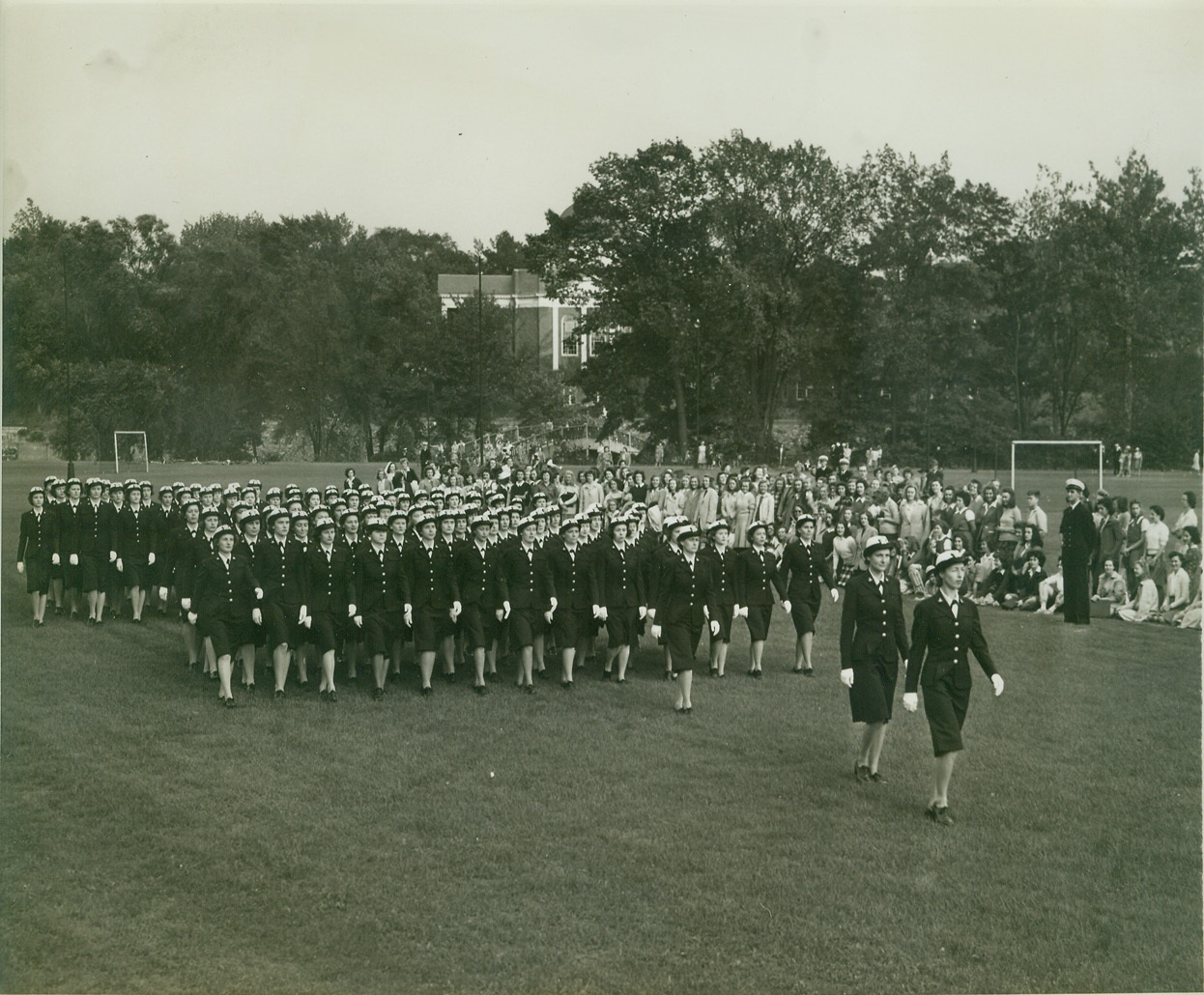
THE WAVES ON DRESS PARADE FOR FIRST TIME, 9/24/1942. NORTHAMPTON, MASS. – The WAVES held their first dress parade and review here today on the campus of Smith College. Here, the WAVES hold dress parade as the students of Smith College in the background watch. Credit: OWI Radiophoto from ACME;
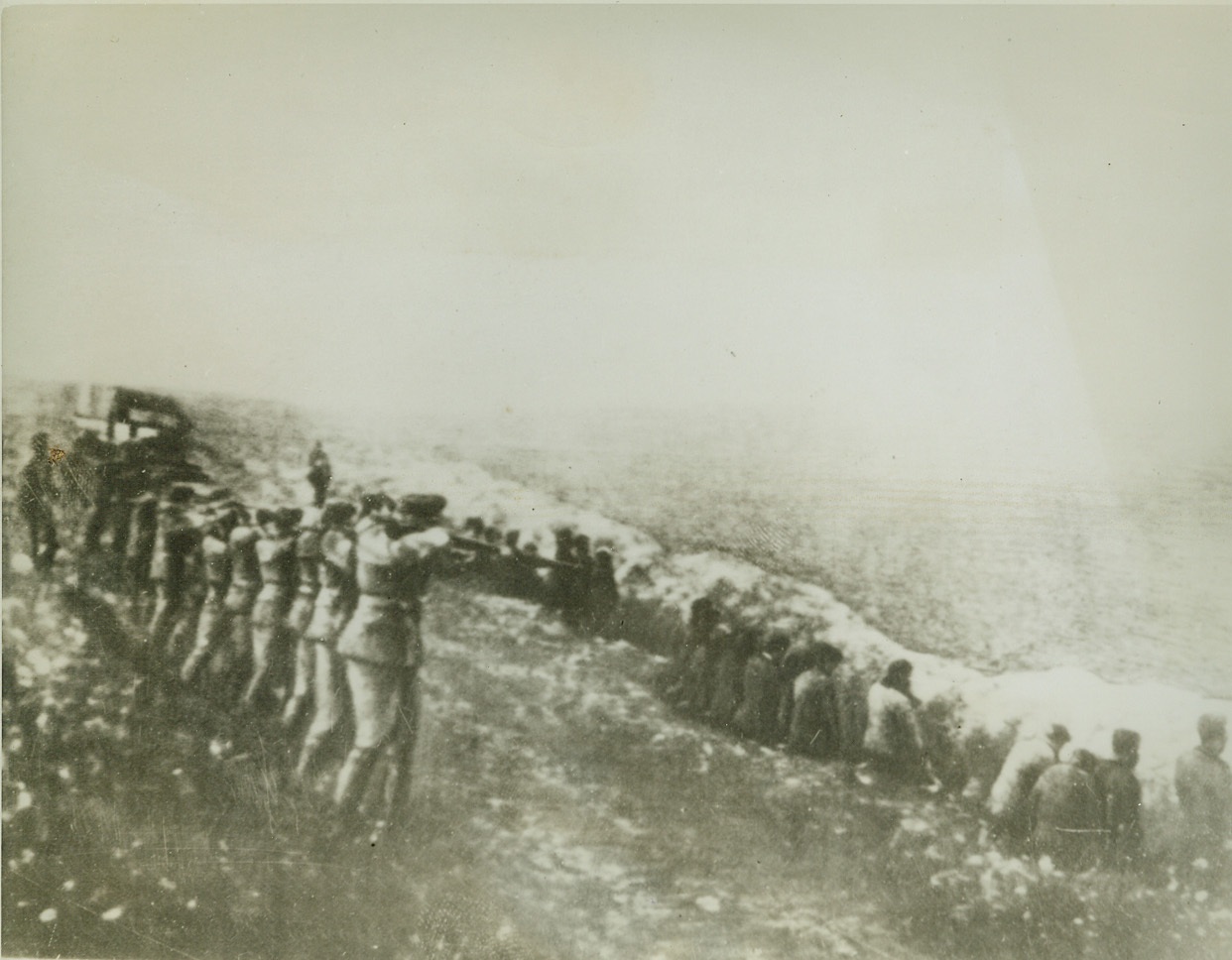
Nazis Execute Soviet Civilians, 9/27/1942. Russia – A German soldier proudly carried this picture. A long line of captured Soviet civilians sit beside their own mass grave, awaiting execution from the Nazi firing squad. The photo was taken from the body of a Nazi officer. Credit: (ACME);
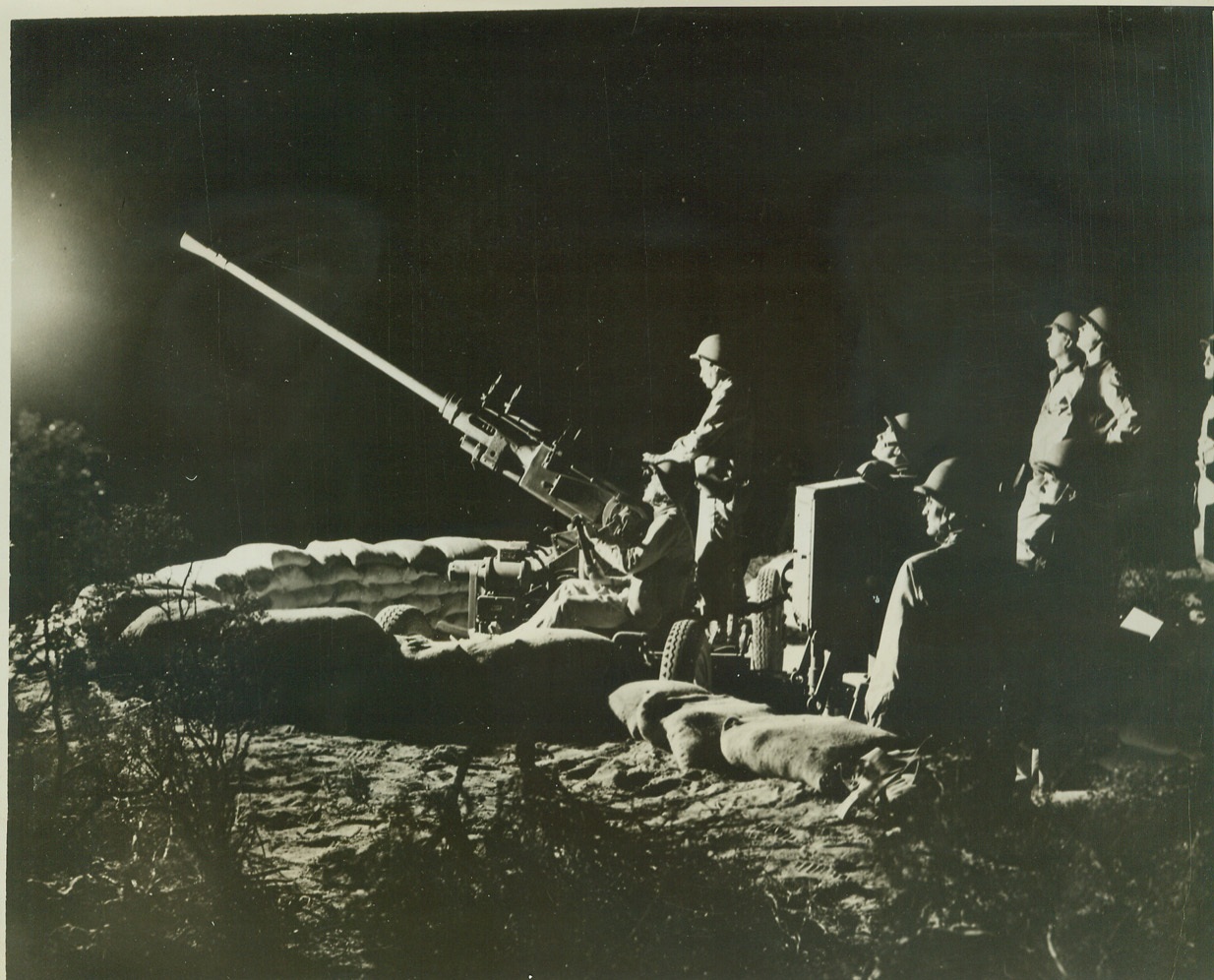
Ready for Night Raiders, 9/29/1942. CALIFORNIA -- A 40-millimeter anti-aircraft gun crew of an anti-aircraft coast artillery unit man their weapon during a night practice demonstration in the California desert. Credit: (ACME);
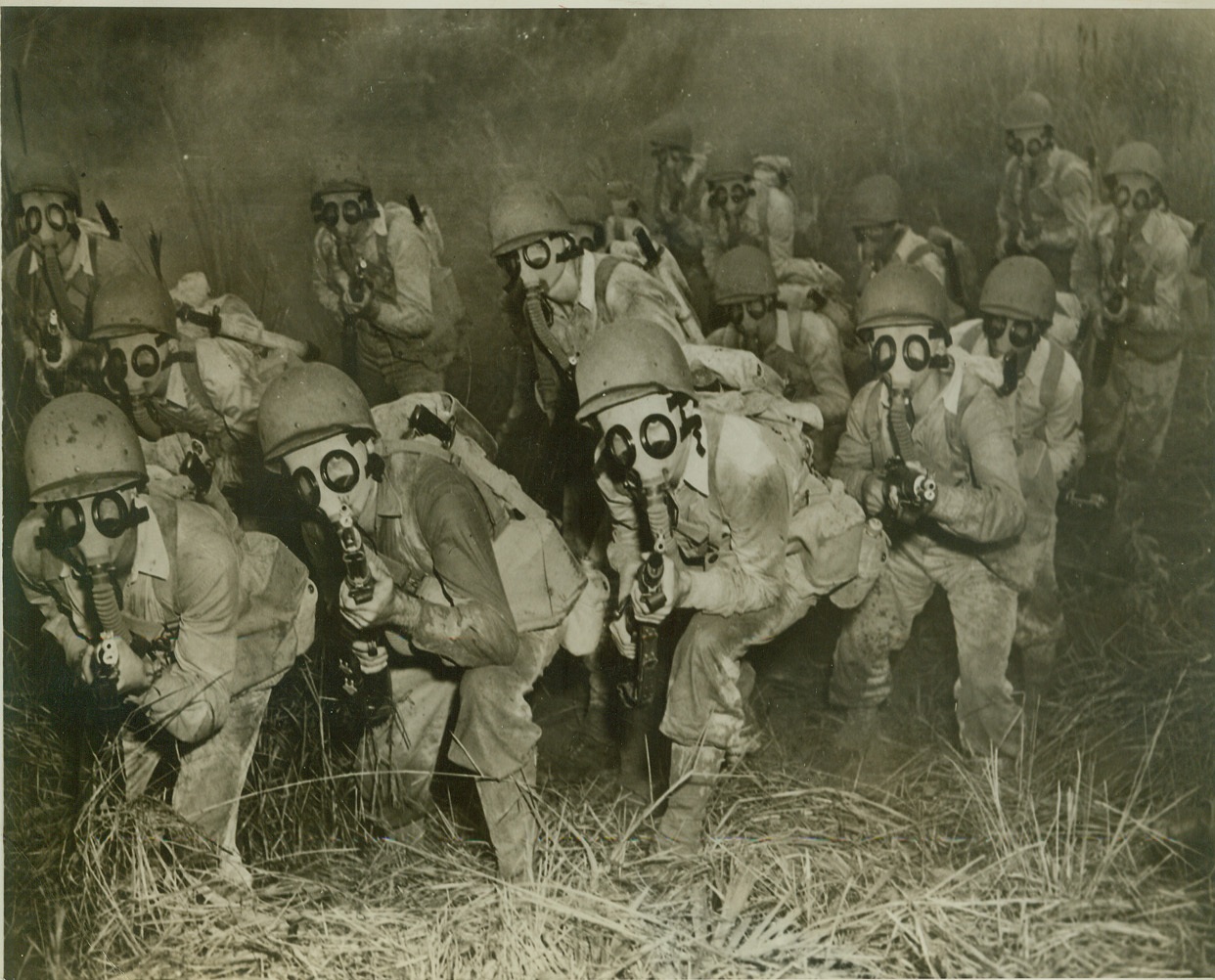
“Bushmasters” on Maneuvers, 9/29/1942. CARIBBEAN DEFENSE AREA – Members of a crack U.S. Army jungle-fighting unit, the “Bushmasters” as they maneuver through a simulated gas attack. These men, highly-trained and tough, are the spearhead of the attack forces under Lt. Gen. Frank M. Andrews, Chief of the Caribbean Defense Area. Credit: (U.S. Army Photo from ACME);
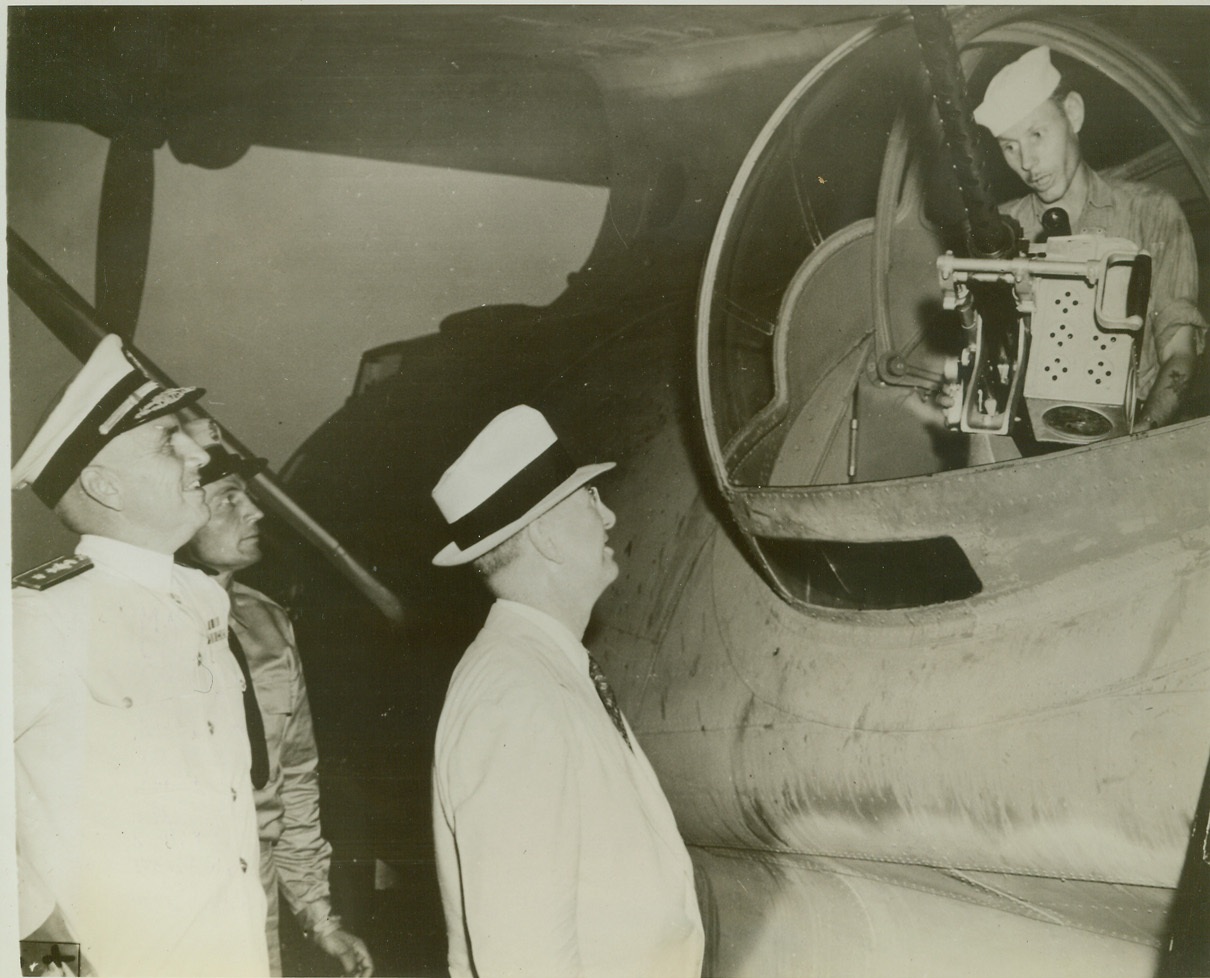
Secretary Knox Talks to Sub Hunter, 9/29/1942. Carribean Defense Area—On his tour of Carribean defense outposts, Secretary of the Navy Frank Knox, (center), talks to gunner Harry Suckman, (right), of Boston, Mass., still at his post in the gun blister of a PBY patrol plane after it returned to its base near the Panama Canal from a sub-hunting patrol flight. At far left is Rear Admiral Clifford Evans Van Hook, commander of the naval forces in the area. Credit: ACME;
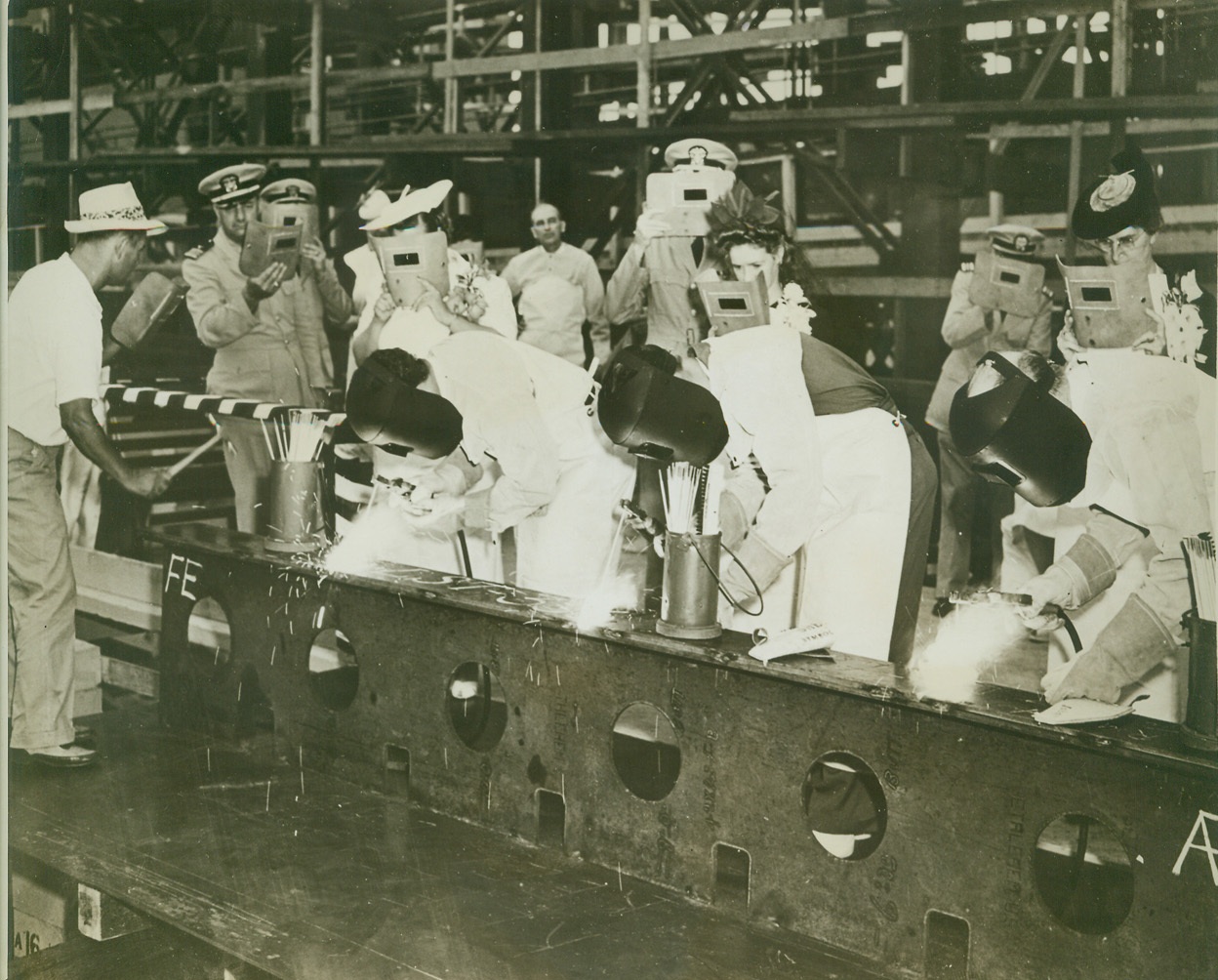
LABOR DAY KEEL LAYING AT CHARLESTON, 9/8/1942. CHARLESTON, S.C. – The first wartime Labor Day found workers at the Navy Yard here putting in a full day on the job and then attending the laying of keels for two landing ships. Striking arcs on one of the new keels are, L. to R., F.O. Tillman, Robert Kellahan, and Moses B. Rayes. Their proud wives stand behind them watching with aid of protective face shields. Credit: U.S. Navy photo via OWI Radiophoto from ACME;
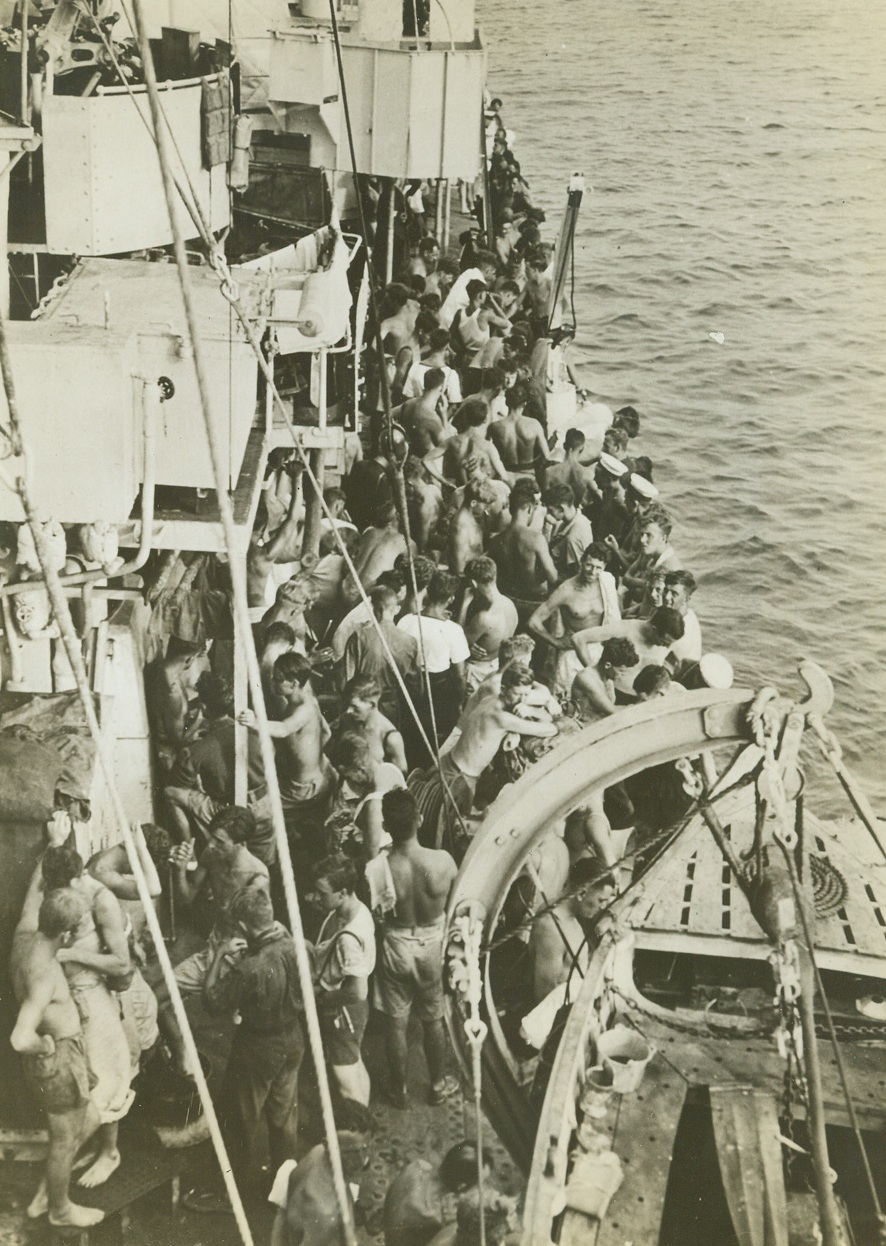
Rescue of Survivors from H.M.S. Dorsetshire, 9/8/1942. Indian Ocean – It’s all past history to these survivors of the British Cruiser H.M.S. Dorsetshire as they crowd the decks of the British Destroyer that came to the rescue, telling their buddies their experiences during the action in the Indian Ocean in which the Dorsetshire and another cruiser were sunk. From their attitudes, you’d think that they were just sunning themselves on deck. Credit: ACME;
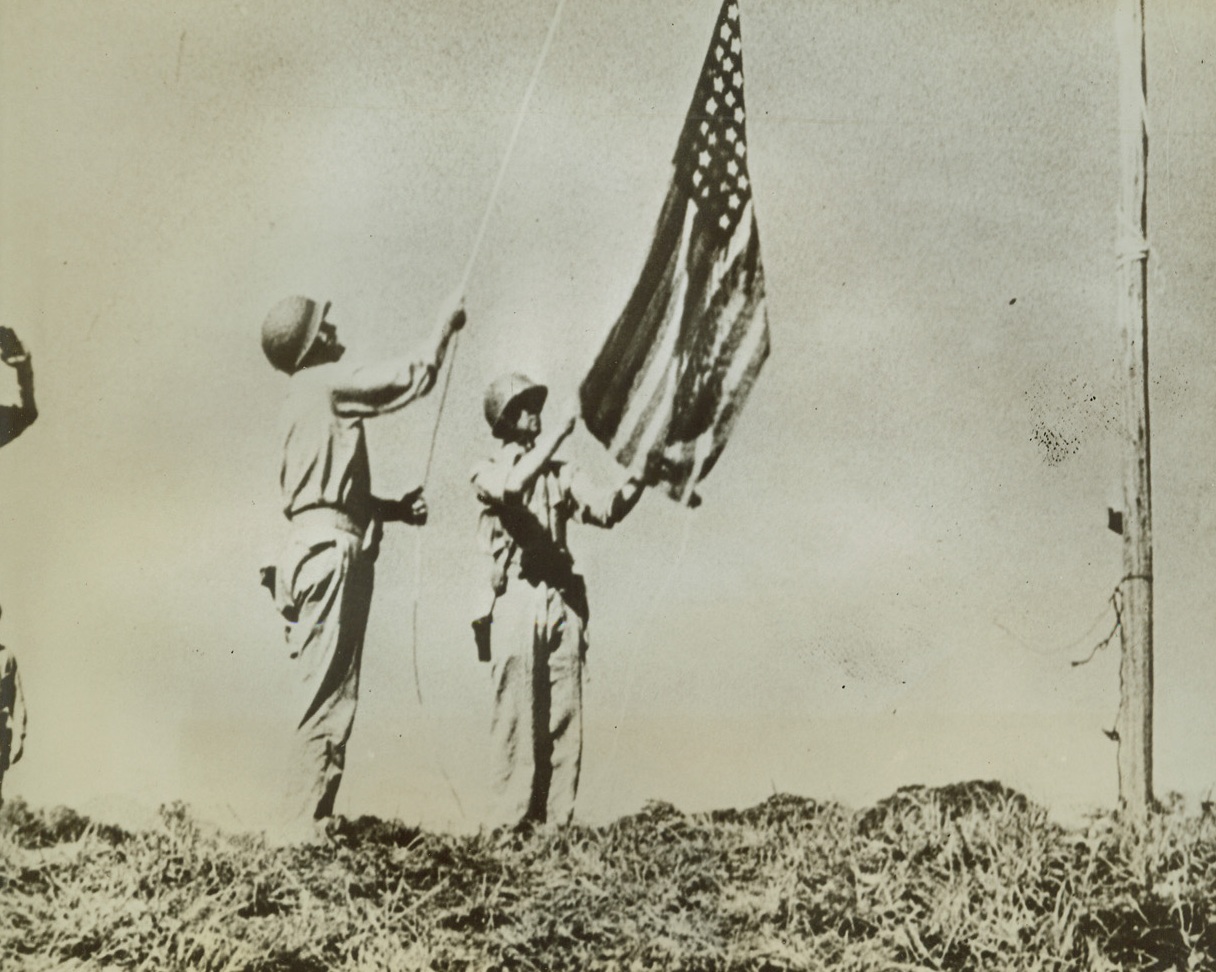
December 7—Plus Eight Months, 9/8/1942. SOLOMON ISLANDS—Marines hoist Old Glory over the first territory taken back from the Japs, eight months to the day after Pearl Harbor. Not fully showing in the picture is Major General Vandergrift, one of the leaders in the attack on the Solomons. Credit: U.S. Marine Corps photo from News of the Day supplied by ACME;
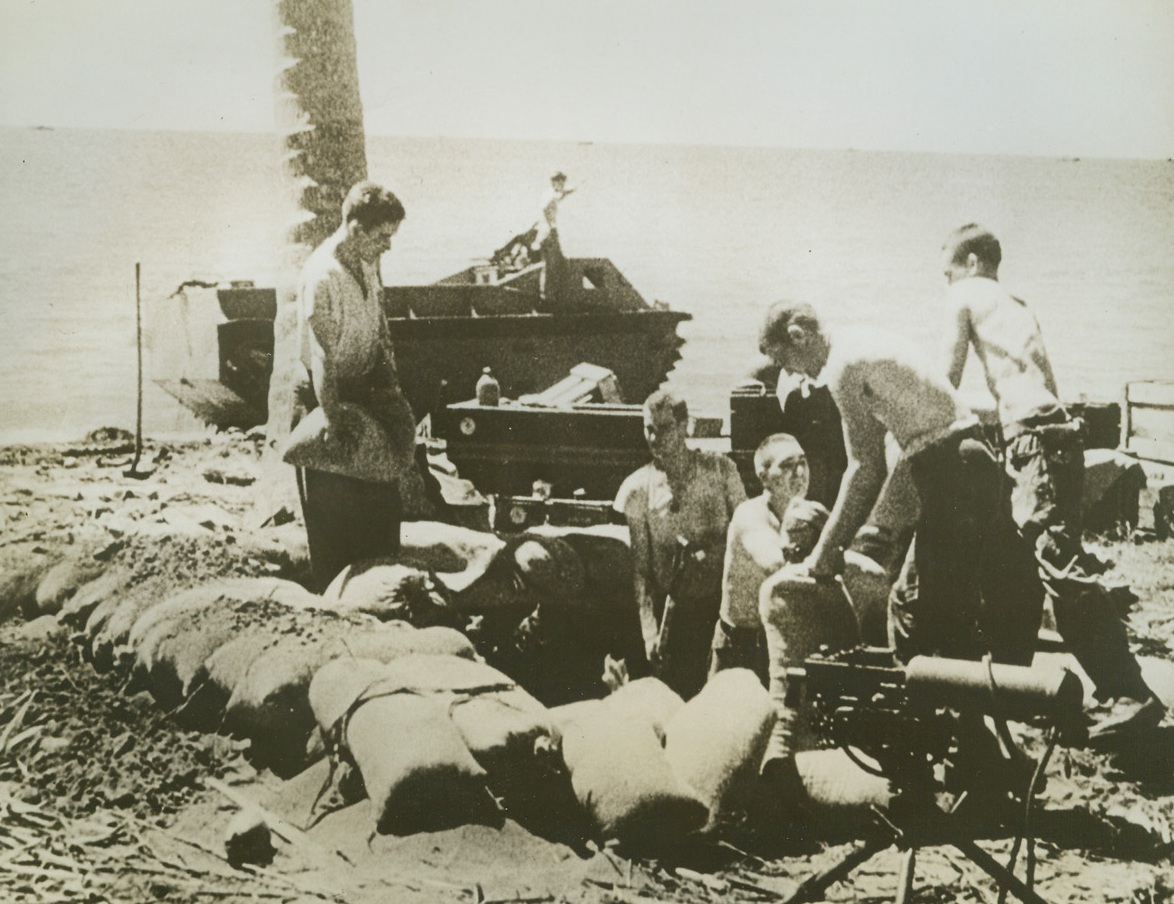
“Digging In”, 9/8/1942. SOLOMON ISLANDS—U.S. Marines establish positions on a beach in Guadalcanal after the opening battle of the first American offensive of World War II. The amphibian tractor, in the background, churned the South Seas waters to bring these marines ashore. Credit: U.S. Marine Corps photo from News of the Day supplied by ACME;
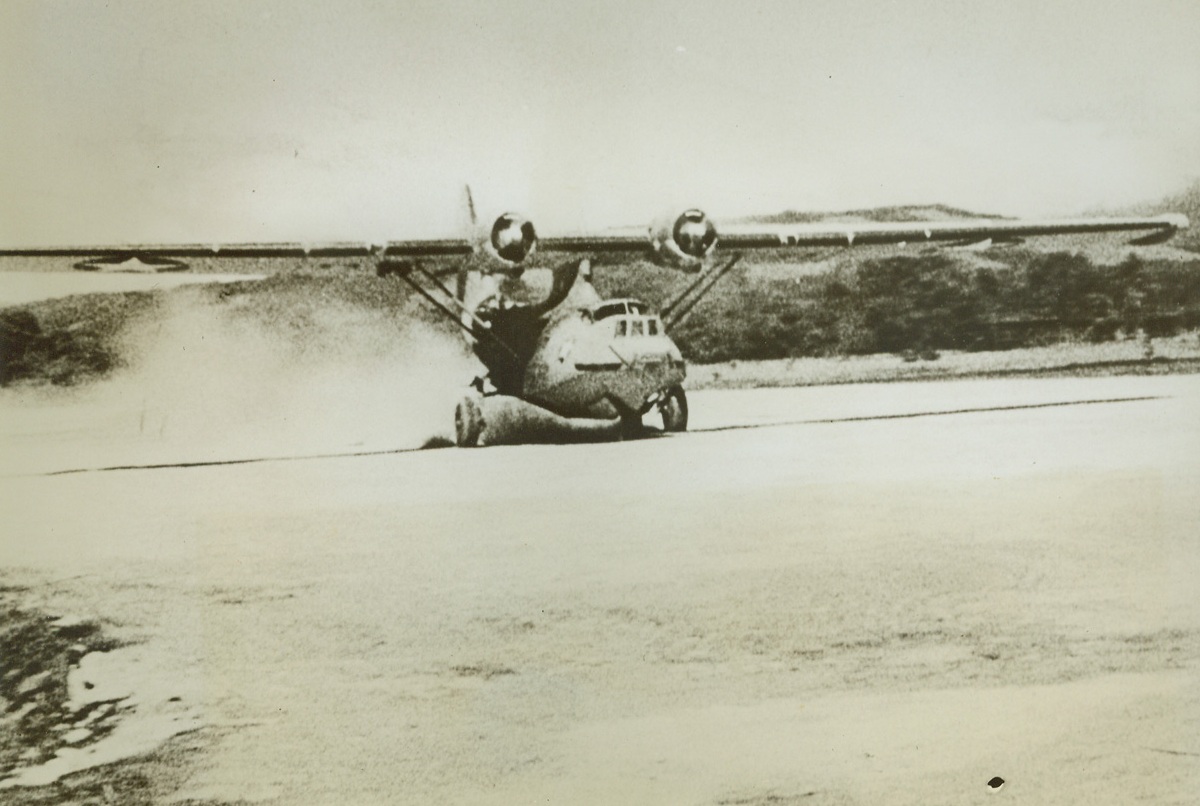
Squatter’s Rights, 9/8/1942. SOLOMON ISLANDS—The first U.S. plane to land after the capture of a beautiful Jap-built air field on Guadalcanal rests on the field’s mile-long runway. The plane, taking possession, is an amphibian patrol bomber. Credit: U.S. Marine Corps photo from News of the Day supplied by ACME;
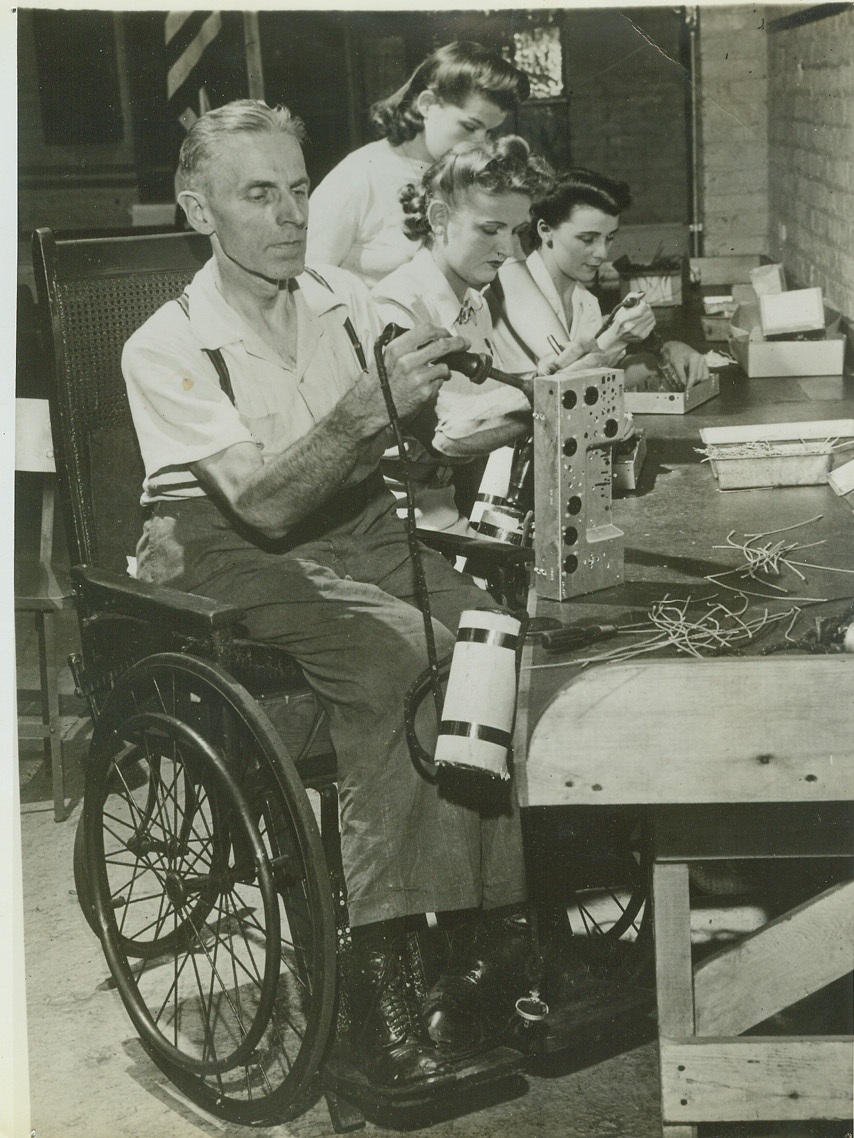
Chicago Bureau, 9/8/1942. CHICAGO, ILL. -- Although confined to a wheelchair, Albert Wiese, 54, infantile paralysis victim, works daily in a Chicago radio plant making radios for the Army and Navy. Your Credit: must read ACME;





 Trash & Recycling
Trash & Recycling
 Online Payments
Online Payments
 City Documents
City Documents
 Parks
Parks
 Traffic Court
Traffic Court
 CITY PARKS
CITY PARKS
 Outdoor Recreation
Outdoor Recreation
 Volunteer
Volunteer
 Home
Home TRANSLATE
TRANSLATE
